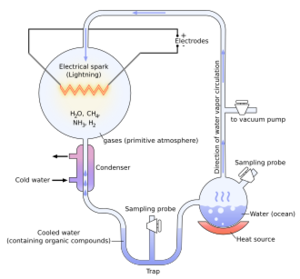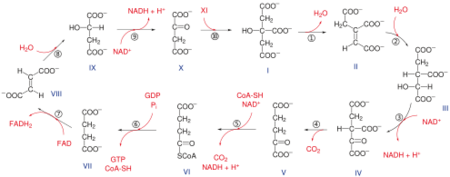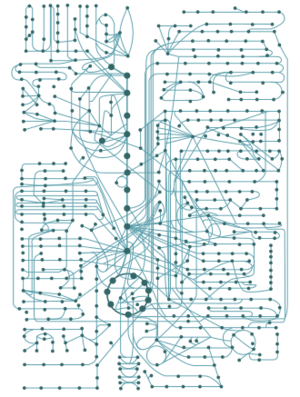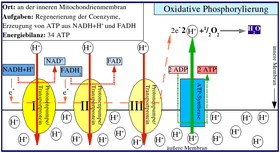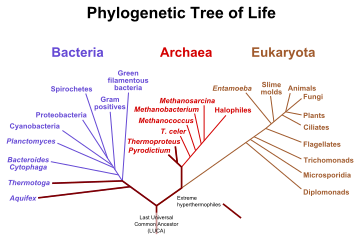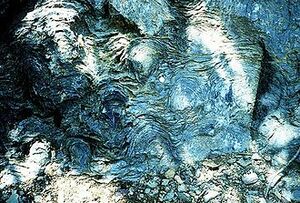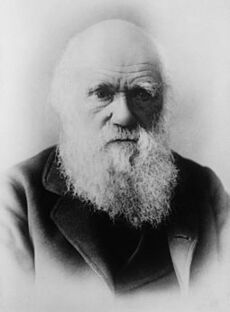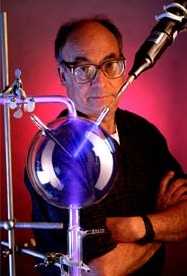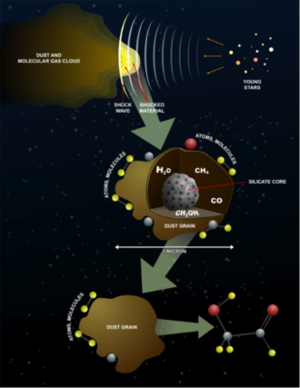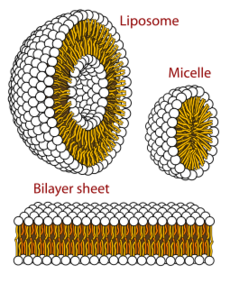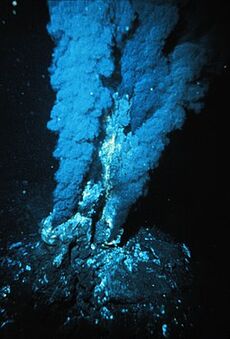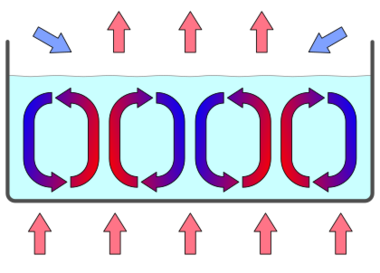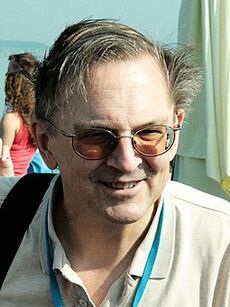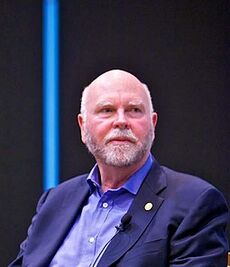生命起源
在进化生物学中,自然发生,或通俗地称为生命起源(OoL),[3][4][5]是生命从非生命物质(如简单的有机化合物)中产生的自然过程。 [6][4][7][8]虽然这一过程的细节仍未可知,但主流的科学假说认为,从非生命实体到生命实体的转变不是一个单一的事件,而是一个复杂度逐渐增加的进化过程,其中包括分子的自复制、自组装、自催化和细胞膜的出现。[9][10][11]虽然自然发生的发生在科学家中是没有争议的,但其可能的机制我们却不甚了解。关于自然发生如何发生,有几种原理和假说。[12]
对自然发生的研究旨在确定生命前的化学反应是如何在与今天地球上截然不同的条件下产生生命的。[13]它主要使用生物学、化学和地球物理学[14]的工具,最近的研究方法试图将这三者综合起来:[15]更具体地说,就是天体生物学、生物化学、生物物理学、地球化学、分子生物学、海洋学和古生物学。生命的功能是通过碳和水的特定化学作用来实现的,并主要建立在四个关键的化学物质家族之上:脂类(细胞膜)、碳水化合物(糖类、纤维素)、氨基酸(蛋白质代谢)和核酸(DNA和RNA)。任何成功的自然发生理论都必须解释这些类别分子的起源和相互作用。[16]许多自然发生的方法都在研究自我复制的分子或它们的组成部分是如何产生的。研究者普遍认为,目前的生命是从RNA世界中诞生的,[17]尽管在RNA之前可能还有其他自我复制分子。[18][19]
1952年经典的Miller-Urey实验 Miller–Urey experiment和类似的研究表明,大多数氨基酸,即所有生物体中使用的蛋白质的化学成分,可以在旨在复制早期地球的条件下从无机化合物中合成。科学家们提出了各种可能引发这些反应的外部能量来源,包括闪电和辐射。其他方法(“新陈代谢优先”假说)则侧重于了解早期地球化学系统中的催化作用如何提供自复制所需的前体分子。[20]
另一种有生源论假说 panspermia hypothesis[21]推测,微生物通过未知的机制在地球以外产生,并通过太空尘埃[22]和流星体传播到早期地球。[23]众所周知,太阳系和星际空间中存在复杂的有机分子,这些分子可能为地球上生命的发展提供了起始物质。[24][25][26][27]
地球仍然是宇宙中已知的唯一一个孕育生命的地方,[28][29] 来自地球的化石证据为大多数关于自然发生论的研究提供了信息。地球的年龄是45.5亿年;[30][31][32]地球上最早的无可争议的生命证据至少可以追溯到35亿年前,[33][34][35]也可能还要追溯到早至始太古代(36-40亿年前之间)。2017年,科学家在西澳大利亚的皮尔巴拉古地台发现的34.8亿岁的硅华和其他相关矿藏(通常在温泉和间歇泉附近发现) 中发现了陆地上早期生命的可能证据。[36][37][38][39]然而,许多发现表明,地球上的生命可能出现得更早。截至2017年,加拿大魁北克省的岩石中37.7亿至42.8亿年前的深海热液喷口沉淀物内的微化石(化石微生物)可能蕴藏着地球上最古老的生命记录,这表明生命在冥古宙44亿年前海洋形成后不久就开始了。[1][2][40][41][42]
美国宇航局关于自然发生的战略指出,有必要确定相互作用、中间结构和功能、能量来源和环境因素,这些因素有助于可进化大分子系统的多样性、选择和复制的因素。[43]强调必须继续绘制潜在的原始信息聚合物的化学景观。能够复制、储存遗传信息并表现出受选择的特性的聚合物的出现,很可能是生命起源前化学进化涌现的关键一步。[43]
热力学、自组织和信息:物理
热力学原理:能量与熵
在古代,人们普遍认为,例如恩培多克勒 Empedocles和亚里士多德 Aristotle就认为,某些物种个体的生命,更一般地说是生命本身,可以从高温开始,即隐含着热循环。[44]
同样,人们很早就意识到,当分子将自身组织成生命物质时,生命需要失去熵,或无序。当物质自组织到更高的复杂性时,需要考虑热力学第二定律。因为生物体是机器,[45]第二定律也适用于生命。
获得自由能
Bernal在 Miller-Urey 的实验中说,
it is not enough to explain the formation of such molecules, what is necessary, is a physical-chemical explanation of the origins of these molecules that suggests the presence of suitable sources and sinks for free energy.
仅仅解释这些分子的形成是不够的,需要的是对这些分子的起源作出物理-化学解释,表明存在合适的自由能源和自由能汇。[46]
早期地球上的化学反应有多种能量来源。例如,热(如来自地热过程)是化学的标准能源。其他的例子还包括阳光和放电(闪电)等。[47] 事实上,闪电是生命起源的似乎合理的能量来源,因为仅在热带地区,每年就有大约1亿次的闪电袭击。[48]
计算机模拟还表明,原始水库中的气蚀作用,如破碎的海浪、溪流和海洋,有可能导致生源化合物的合成。[49]
不利的反应也可以由非常有利的反应驱动,如铁硫化学反应。例如,这对碳固定(碳从其无机形式转化为有机形式)可能很重要。通过铁硫化学反应进行的碳固定是非常有利的,在中性pH值和100C时发生。深海热液喷口附近丰富的铁硫表面也能产生少量的氨基酸和其他生物代谢物。
自组织
协同学这门学科研究的是物理系统的自组织。Hermann Haken在其《协同论 Synergetics》[50]一书中指出,不同的物理系统可以用类似的方式处理。他举了几种类型的激光、流体动力学(包括对流)中的不稳定性以及化学和生化振荡作为自组织的例子。在他的序言中他提到了生命的起源,但只是泛泛而谈。
The spontaneous formation of well organized structures out of germs or even out of chaos is one of the most fascinating phenomena and most challenging problems scientists are confronted with. Such phenomena are an experience of our daily life when we observe the growth of plants and animals. Thinking of much larger time scales, scientists are led into the problems of evolution, and, ultimately, of the origin of living matter. When we try to explain or understand in some sense these extremely complex biological phenomena it is a natural question, whether processes of self-organization may be found in much simpler systems of the unanimated world.
从细菌甚至从混沌中自发形成的组织良好的结构是科学家们面临的最迷人的现象和最具挑战性的问题之一。这种现象是我们在日常生活中观察动植物生长时的一种体验。从更大的时间尺度来思考,科学家们就会被引向进化问题,并最终引向生命物质的起源问题。当我们试图在某种意义上解释或理解这些极其复杂的生物现象时,这是一个很自然的问题,自组织的过程是否可以在无生命世界里简单得多的系统中找到。
In recent years it has become more and more evident that there exists numerous examples in physical and chemical systems where well organized spatial, temporal, or spatio-temporal structures arise out of chaotic states. Furthermore, as in living organisms, the functioning of these systems can be maintained only by a flux of energy (and matter) through them. In contrast to man-made machines, which are devised to exhibit special structures and functionings, these structures develop spontaneously—they are selforganizing. ...
近年来,越来越明显的是,在物理和化学系统中存在着许多例子,在这些例子中,从混沌状态中产生了组织良好的空间、时间或时空结构。此外,就像在生物体中一样,这些系统的功能只能通过流通它们的能量(和物质)流来维持。与人造机器不同的是,人造机器被设计成表现出特殊的结构和功能,这些结构是自发发展的——它们是自组织的...[51]
多重耗散结构
该理论假设生命起源和进化的标志是有机色素的微观耗散结构及其在整个地球表面的扩散。[52]现今的生命通过将紫外线和可见光子通过水中的有机色素耗散成热能,从而增加了地球在太阳环境中的熵产生。然后这些热量又催化了一系列的二次耗散过程,如水循环、洋流和风流、飓风等。[53][54]
耗散结构的自组织
19世纪的物理学家路德维希-玻尔兹曼 Ludwig Boltzmann首先认识到,生物体的生存斗争既不是为了原料,也不是为了能源,而是与这些系统将太阳光谱转化为热能所产生的熵有关。[55]Boltzmann由此认识到,生命系统和所有不可逆的过程一样,其存在依赖于广义化学势的耗散。20世纪物理学家埃尔温·薛定谔 Erwin Schrödinger在其《生命是什么 What is Life》[56] 一书中强调了Boltzmann对生命系统不可逆的热力学本质的深刻洞察,认为这就是生命起源和进化背后的物理学和化学。
然而,不可逆的过程,更不用说生命系统了,在这个角度下无法方便地进行分析,直到拉斯·昂萨格 Lars Onsager[57]和后来的Ilya Prigogine[58],发展了一种优雅的数学形式体系,用于处理广义化学势下物质的 "自组织"。这个形式体系后来被称为经典不可逆热动力学,1977年Prigogine被授予诺贝尔化学奖,"以表彰他对非平衡热动力学,特别是耗散结构理论的贡献"。Prigogine的分析表明,如果让一个系统在一个强加的外部势下演化,物质可以自发地组织起来(降低其熵),形成他所说的 "耗散结构",从而增加外部强加势的耗散(增强全局熵的产生)。此后,非平衡热动力学被成功地应用于生命系统的分析,从ATP[59]的生化生产到优化细菌代谢通路[60]以形成完整的生态系统。[61][62][63]
当前的生命,生物发生的结果:生物学
生命的定义
当讨论生命的起源时,最基本的问题是对生命本身的定义。由于不同的生物学教科书对生命的定义不同,所以这个定义存在一定的分歧(虽然遵循相同的基本原则)。詹姆斯·古尔德 James Gould:
Most dictionaries define life as the property that distinguishes the living from the dead, and define dead as being deprived of life. These singularly circular and unsatisfactory definitions give us no clue to what we have in common with protozoans and plants.
大多数字典将生命定义为区别于存活和死亡的属性,并将死亡定义为被剥夺了生命。这些奇怪循环的、难以令人满意的定义,没有给我们提供任何线索,使我们了解我们与原生动物和植物的共同之处。[64]
然而,根据尼尔·坎贝尔Neil Campbell和简·里斯Jane Reece 的说法,
The phenomenon we call life defies a simple, one-sentence definition.[65]
我们称之为生命的现象,不能用简单的一句话去定义。
在关于生命起源的书籍中也可以找到这种差异。约翰·卡斯蒂 John Casti给出了一句话:
By more or general consensus nowadays, an entity is considered to be "alive" if it has the capacity to carry out three basic functional activities: metabolism, self-repair, and replication.
现在越来越多的人或普遍认为,如果一个实体有能力进行三种基本的功能活动:新陈代谢、自我修复,和复制,那么它就被认为是“有生命的”。[66]
相比之下,德克·舒尔茨-马库奇 Dirk Schulze-Makuch和路易斯·欧文 Louis Irwin在他们的书中花了整整第一章来讨论这个问题。[67]
尽管如此,美国宇航局目前对生命的定义是,生命是“一种能够进行达尔文进化的自我维持的化学系统”。[68][69][70][71]更简单地说,生命是“可以自我繁殖并按照生存要求进化的物质”。[72][73][74]
发酵
阿尔伯特·莱宁格 Albert Lehninger曾在1970年左右指出,包括糖酵解在内的发酵过程是生命起源一种合适的原始能量来源。[75]
Since living organisms probably first arose in an atmosphere lacking oxygen, anaerobic fermentation is the simplest and most primitive type of biological mechanism for obtaining energy from nutrient molecules.
由于生物体可能首先是在缺氧的环境中产生的,因此无氧发酵是从营养分子中获取能量的一种最简单、最原始的生物机制。
发酵过程包括糖酵解,它非常低效地将糖的化学能转化为ATP的化学能。
化学渗透
由于在1970年左右发酵已经被阐明,而氧化磷酸化的机制还没有,而且存在一些争议,所以发酵作用在当时对生命起源的研究者来说可能显得过于复杂。不过,彼得·米切尔 Peter Mitchell的化学渗透现在被普遍接受是正确的。
连Peter Mitchell自己也认为发酵先于化学渗透。然而,化学渗透在生命中无处不在。一个依据化学渗透的生命起源模型已经被提出来了。[76][77]
线粒体的呼吸作用和叶绿体的光合作用都是利用化学渗透来产生大部分ATP。
今天,一切生命的能量来源都可以与光合作用联系起来,人们称之为太阳光的初级生产。海洋底部热液喷口中的生物用于氧化还原性化合物[78] 的氧气,就来源于海洋表面光合作用。
ATP合成酶
ATP的合成机制很复杂,涉及到ATP合成酶所嵌入的闭合膜。ATP是由ATP合成酶的F1亚基通过 Paul Boyer 发现的结合变化机制合成的。释放形成的牢固结合的ATP所需的能量源自跨膜移动的质子。这些质子在呼吸作用或光合作用过程中穿过膜。
RNA世界 RNA world

RNA世界假说描述了一个具有自我复制和催化能力的RNA,但没有DNA或蛋白质的早期地球。[80] 现在普遍认为现在地球上的生命起源于一个RNA世界,尽管基于RNA的生命可能并不是最早存在的生命。[17]这个结论是由许多独立的证据得出的,例如观察到RNA是翻译过程的核心,并且小RNA可以催化生命所需的所有化学基团和信息转移。核糖体的结构被称为“确凿的证据 smoking gun”,因为它表明核糖体是一个核酶,其核心是RNA,并且在催化肽键形成的活性位点18埃以内没有氨基酸侧链。[18][81] 尽管如此,在 2021 年 3 月,研究人员报告的证据表明,转移 RNA 的初步形式可能是生命早期发展中的复制分子本身。[82][83]
RNA世界的概念是由亚历山大·里奇 Alexander Rich在1962年首次提出的[84] ,而这个术语则是由沃尔特·吉尔伯特 Walter Gilbert在1986年创造的。[19][85] 在2020年3月,天文学家户谷友则 Tomonori Totani提出了一种统计方法,用于解释初始的活性RNA分子是如何在宇宙大爆炸后某个时间随机产生的。[86][87]
系统发育和最后的普遍共同祖先
根据从卡尔·沃斯 Carl Woese 开始的一些分子研究,对于生命树的根部的位置,最普遍接受的观点是位于单系域细菌和一个由古细菌和真核生物组成的演化枝之间,这被称为“传统生命树”。[88][89]
2016年,一组355个基因被识别为可能存在于生活在地球上的所有生物的最后一个普遍共同祖先 Last Universal Common Ancestor(LUCA)中。对来自各种系统发育树的610万个原核生物蛋白编码基因进行了测序,从286,514个蛋白簇中识别了355个蛋白簇,它们很可能是LUCA共有的。结果说明LUCA是厌氧的、固定二氧化碳的、氢气依赖的且具有Wood-Ljungdahl通路的、固定氮气的和嗜热的。LUCA的生物化学中充斥着FeS簇和自由基反应机制。它的辅因子揭示了对过渡金属、黄素、S-腺苷甲硫氨酸、辅酶A、铁氧化还原蛋白、钼蝶呤、柯啉环和硒的依赖性。其遗传密码需要核苷修饰和S-腺苷甲硫氨酸依赖的甲基化"。
生物发生中的关键问题
孰先孰后:蛋白质还是核酸?
蛋白质合成的进化的可能前体包括合成短肽辅因子的机制或形成RNA复制的机制。祖先的核糖体很可能完全由RNA组成,尽管有些作用已经被蛋白质取代了。关于这个主题的主要剩余问题包括确定核糖体进化的选择性力量和确定遗传密码是如何产生的。[90]
尤金·库宁 Eugene Koonin 说,
Despite considerable experimental and theoretical effort, no compelling scenarios currently exist for the origin of replication and translation, the key processes that together comprise the core of biological systems and the apparent pre-requisite of biological evolution. The RNA World concept might offer the best chance for the resolution of this conundrum but so far cannot adequately account for the emergence of an efficient RNA replicase or the translation system. The MWO ["many worlds in one"] version of the cosmological model of eternal inflation could suggest a way out of this conundrum because, in an infinite multiverse with a finite number of distinct macroscopic histories (each repeated an infinite number of times), emergence of even highly complex systems by chance is not just possible but inevitable.
尽管在实验和理论上做了大量的努力,但对于复制和翻译的起源,目前还没有令人信服的设想,而复制和翻译是共同构成了生物系统核心的关键过程,也是生物进化的明显先决条件。RNA世界概念可能为这一难题的解决提供了最好的机会,但迄今为止还不能充分说明高效RNA复制酶或翻译系统的出现。MWO["多世界合一"]版本的永恒膨胀的宇宙模型可能提出了解决这一难题的方法,因为在一个无限的多元宇宙中,有有限数量的不同的宏观历史(每个历史重复无限次),即使是高度复杂的系统的偶然出现,不仅是可能的,而且是不可避免的。[91]
灾难性翻译错误
霍夫曼 Hoffmann已经证明,早期容易出错的翻译机制可以稳定地抵御曾被设想为对生命起源有问题的那种错误灾难,被称为 "奥格尔悖论 Orgel's paradox"。[92][93][94]
同手性
同手性是指由手性单元组成的某些材料的几何均匀性。手性是指不可重叠的三维形态,它们是彼此的镜像,就像左手和右手一样。生物体使用的分子具有相同的手性("利手性"):几乎没有例外,[95]氨基酸是左旋的,而核苷酸和糖类是右旋的。手性分子可以合成,但在没有手性源或手性催化剂的情况下,它们是以两种对映体以50/50的混合物(称为外消旋混合物)形成的。已知从外消旋起始原料产生非外消旋混合物的机制包括:非对称物理定律,如弱电相互作用;非对称环境,如圆偏振光、石英晶体或地球自转引起的环境,外消旋合成过程中的统计波动,[96]以及自发的对称性破缺。[97][98][99]
一旦建立,手性将被选择。[100]群体中的一个小偏差(对映体过量)可以通过不对称自催化放大成一个大的偏差,如在Soai反应中。[101]在不对称自催化中,催化剂是一个手性分子,这意味着手性分子正在催化自己的生产。最初的对映体过量,例如可以通过偏振光产生,然后允许更丰富的对映体超过其他对映体。[102]
克拉克 Clark认为,同手性可能始于外太空,因为对默奇森 Murchison陨石上氨基酸的研究表明,L-丙氨酸的出现频率是其D形式的两倍多,L-谷氨酸是其D形式的三倍多。各种手性晶体表面也可以作为手性单体单元可能集中和组装成大分子的场所。[103][104]在陨石上发现的化合物表明,生命的手性来源于非生物合成,因为陨石上的氨基酸表现出左手旋偏向,而糖类则主要表现出右手旋偏向,这与在生物体中发现的相同。[105]
有第一颗恒星的早期宇宙
在宇宙大爆炸发生后不久,大约140亿年前,宇宙中存在的化学元素只有氢、氦和锂,这是周期表中最轻的三种元素。这些元素逐渐聚集在一起,形成了恒星。这些早期的恒星质量大、寿命短,通过恒星核合成产生更重的元素。碳是目前宇宙中含量第四丰富的化学元素(仅次于氢、氦、氧),主要形成于白矮星,尤其是那些大于两个太阳质量的白矮星。[106][107]
当这些恒星达到其生命周期的终点时,它们在整个宇宙中喷射出这些较重的元素,其中包括碳和氧。这些较重的元素使得新的物体得以形成,包括岩质行星和其他天体。[108]
太阳系的出现
根据星云假说,太阳系的形成和演化始于46亿年前,因为一个巨大的分子云的一小部分的引力塌缩。[109]大部分塌缩的质量聚集在中心,形成了太阳,而其余的则压平成一个原行星盘,行星、卫星、小行星和其他小太阳系天体就是从这个原行星盘中形成的。
地球的出现
地球,形成于45亿年前,起初是不适合任何生物体生存的。根据对地质学时间尺度的大量观察和研究,人们认为冥古代地球曾有过一个次级大气层,是通过小行星撞击物所积累的岩石脱气而形成的。起初,人们认为地球的大气层由氢化合物——甲烷、氨和水蒸气组成,生命就是在这种有利于有机分子形成的还原性条件下开始的。根据后来的模型,通过对古代矿物的研究提出,冥古代晚期的大气层主要由水蒸气、氮气和二氧化碳组成,还有少量的一氧化碳、氢气和硫化合物。[110]在地球形成过程中,地球失去了其初始质量的很大一部分,原行星盘中较重的岩石元素组成的核仍然存在。[111]因此,地球缺乏在大气层中容纳任何氢分子的引力,并且在冥古代迅速失去了它,以及大部分的原始惰性气体.。二氧化碳在水中形成的溶液被认为使海洋呈微酸性,使海洋的pH值约为5.5。[112] 当时的大气层被描述为 "巨大的、高产的露天化学实验室。"它可能与今天火山释放的混合气体相似,它仍然支持一些非生物化学。[47]
海洋的出现
海洋可能最早出现在冥古宙,即地球形成后的2亿年,在一个100 C的高温的还原性环境中,pH值约为5.8,迅速上升到中性。.[113]这一假设已经得到了来自澳大利亚西部纳里尔山变质石英岩的4.404 Gyo锆石晶体的年代测定的支持。这一设想已经得到了来自澳大利亚西部的皮尔巴拉的杰克高地的纳瑞耶山的变质石英岩的44.04亿年前的锆石晶体的年代测定的支持,它提供了地球形成后1.5亿年前内存在海洋和大陆地壳的证据。[114]尽管可能增加了火山活动,并存在许多较小的构造 "板块",但有人认为,在44-43亿年之间,地球是一个水世界,几乎没有大陆地壳,大气层极度动荡,水圈受到来自T金牛座阶段的太阳的强烈的紫外线(UV)照射、宇宙辐射和持续的天体撞击。[115]由于地核和地幔之间的重力分选导致的内部加热会引起大量的地幔对流,这可能导致比现在存在的更小、更活跃的构造板块。
晚期重型轰炸
冥古代的环境对现代生命将是非常危险的。与直径达500公里的大型物体频繁碰撞,足以在撞击后的几个月内使地球成为不毛之地,并使海洋汽化,热蒸汽与岩石蒸汽混合,成为足以完全覆盖地球的高空云层。几个月后,这些云层的高度会开始降低,但在接下来的大约一千年里,云层的底部仍会升高。在那之后,低海拔地区就会开始下雨。在接下来的两千年里,雨水会慢慢地拉低云层的高度,使海洋只有在撞击事件发生3000年后才恢复到原来的深度。[116]
传统上认为,在42.8亿[1][2] 年前到38亿年前之间的时期,巨行星轨道的变化可能造成了小行星和彗星[117]对月球和其他内行星(水星、火星,大概还有地球和金星)的猛烈轰击。如果生命在那之前出现的话,这很可能会使这个星球反复成为不毛之地。[47]从地质学上来说,冥古代地球会比历史上任何其他时间都要活跃得多。对陨石的研究表明,放射性同位素,如半衰期为7.17 千年的铝-26和半衰期为12.5亿年的钾-40,这些主要产生于超新星的同位素更为常见[118] 。由于地核和地幔之间的重力分选而产生的内部加热会引起大量的地幔对流,其结果可能是产生了比现在更小、更活跃的构造板块。
这种毁灭性的环境事件之间的时间段,为早期环境中可能的生命起源提供了时间窗口。如果深海热液环境是生命起源的场所,那么自然发生可能早在40-42亿年前就发生了。如果地点在地球表面,那么自然发生只能发生在37-40亿年前之间。[119]
对这些来源的有机物的产生的估计表明,在35亿年前之前,早期大气层内的晚期重型轰炸使可获得的有机物的数量与陆地来源产生的有机物数量相当。[120][121]
据估计,晚期重型轰炸还可能对数十米深的地球表面进行了有效的灭菌。如果生命进化到比这更深的地方,它也会被屏蔽在太阳进化的T金牛座阶段的早期高水平紫外线辐射之外。对地热加热的海洋地壳进行模拟,得到的有机物远比Miller–Urey实验中发现的多。在深层热液喷口中,埃弗雷特·休克 Everett Shock发现“存在着形成有机化合物的巨大热力学驱动力,因为海水和热液远未达到平衡,混合并向更稳定的状态发展。”[122]Shock发现,可用的能量在100-150 C左右达到最大,而这正是发现嗜热细菌和嗜热古细菌的温度,处于最接近最后普遍共同祖先(LUCA)的生命系统发育树的底部。[123]
生命的最早证据:古生物学
地球上最早的生命存在于35亿年前,[33][34][35]在始太古代时期,在熔化的冥古宙之后,充足的地壳已经凝固。迄今为止发现的最早的物理证据包括魁北克北部努夫雅集图克绿岩带中的微生物化石,位于至少37.7亿岁,也可能42.8亿岁的带状铁层岩石中。[1][124]这个发现表明生命在海洋形成后不久便出现了。据悉,这种微生物的结构与现代热液喷口附近发现的细菌相似,为无生源论始于热液喷口附近的假说提供了支持。
人们在格陵兰岛西南部37亿岁的变质沉积岩中发现了生物来源的石墨[125] ,在西澳大利亚距今34.8亿年前的砂岩中发现了微生物垫层化石[126][127]。在格陵兰岛西南部伊苏亚上地壳带附近的阿基利亚岛的岩石中发现了早期生命的证据,这些可追溯到37亿年前的证据中发现了生源碳同位素[128][129] 。在伊苏亚上地壳带的其他地方,被困在石榴石晶体内的石墨包裹体与生命的其他元素相连:氧、氮和可能以磷酸盐形式存在的磷,为37亿年前的生命提供了进一步的证据[130] 。在西澳大利亚皮尔巴拉地区的斯特雷利池,在一个化石滩的含黄铁矿砂岩中发现了早期生命的令人信服的证据,它显示了圆形的管状细胞,在没有氧气的情况下通过光合作用氧化硫。2015年对西澳大利亚的锆石的进一步研究表明,生命很可能在至少41亿年前就存在于地球上。[131][132][133]
20世纪60年代以前的概念演变史:生物学
泛种论
泛种论是一种假说,即生命存在于整个宇宙,由流星体、小行星、彗星分布。[134]
泛种论假说并不试图解释生命最初是如何起源的,而只是将起源转移到另一颗行星或彗星上。原始生命的地外起源的优点是,生命不需要在它出现的每个星球上形成,而是在一个单一的位置,然后通过彗星和/或陨石撞击在银河系周围传播到其他恒星系统。[135] 泛种论假说的证据很少,但它在对南极洲发现的火星陨石的研究和对极端微生物在外太空测试中生存的研究中找到了一些支持。[136][137][138][139]
2020年8月,科学家报告称,根据在国际空间站上进行的研究,发现来自地球的细菌,特别是对环境危害有很强抵抗力的耐辐射球菌,可以在外太空存活3年。[140][141]
生命起源于宇宙大爆炸之后,并已遍布整个宇宙
一种极端的推测是生命的生物化学可能早在大爆炸后1700万年就开始了,在一个适宜居住的时期,生命可能存在于整个宇宙中。[142][143]
生命从火星带入地球的泛种论
卡尔·齐默 Carl Zimmer推测,火星早期的化学条件,包括最初生成RNA所需的硼,钼和氧的存在,可能比地球早期更好。[144][145][146]如果是这样,起源于火星的适合生命的分子可能后来会通过流星喷射迁移到地球。
自然发生
19世纪之前,人们普遍接受自然发生论
传统宗教把生命的起源归结为超自然的神灵,他们创造了自然界。“自然发生”,是第一个从非生命中产生生命的自然主义理论,它可以追溯到Aristotle和古希腊哲学,并在西方学术界一直得到支持,直到19世纪。[147]"自然发生”的古典观念认为,某些 “低等”或“害虫”动物是由腐烂的有机物质产生的。根据Aristotle的观点,很容易观察到蚜虫从植物上的露水中产生,苍蝇从腐烂的物质中产生,老鼠从肮脏的干草中产生,鳄鱼从腐烂的沉木中产生,等等。[148] A related theory was heterogenesis: that some forms of life could arise from different forms (e.g. bees from flowers).[149]一个相关的理论是异生论:某些生命形式可以从不同的形式中产生(如蜜蜂从花中产生)。现代科学家约翰·德斯蒙德·贝纳尔John Desmond Bernal说,这种理论的基本思想是生命是作为偶然事件的结果而不断产生的。[46]
在17世纪,人们开始质疑这些假设。1646年,托马斯·布朗爵士 Sir Thomas Browne出版了他的《伪传染病》(副标题为“对许多公认的原则和通常假定的真理的询问”),该书攻击了错误的信念和“庸俗的错误”。与他同时代的亚历山大·罗斯 Alexander Ross错误地驳斥了他,称:
To question this [spontaneous generation], is to question Reason, Sense, and Experience: If he doubts of this, let him go to Egypt, and there he will find the fields swarming with mice begot of the mud of Nile, to the great calamity of the Inhabitants.
质疑这个自然发生,就是质疑理性、感觉和经验。如果他怀疑这一点,让他去埃及, 在那里,他将会发现田野里到处都是由尼罗斯的泥土生出的老鼠,给当地居民带来了巨大的灾难。[150][151]
1665年,罗伯特·胡克 Robert Hooke发表了第一本微生物的图画。1676年,安东尼·范·列文虎克 Antonie van Leeuwenhoek紧随其后,他绘制并描述了现在被认为是原生动物和细菌的微生物。[152] 许多人认为微生物的存在是支持自然发生的证据,因为微生物对于有性生殖来说似乎过于简单,而通过细胞分裂的无性生殖尚未被观察到。Van Leeuwenhoek对当时常见的跳蚤和虱子可能由腐烂作用自发产生,以及青蛙同样可能由粘液产生的观点提出了异议。他利用广泛的实验,从密封和开放的肉孵化以及对昆虫繁殖的仔细研究,到1680年代,他确信自然发生是不正确的。[153]
第一个反对自然发生的实验证据是在1668年,当时弗朗西斯科·雷迪 Francesco Redi表明,当阻止苍蝇产卵时,肉中不会出现蛆虫。人们逐渐发现,至少在所有高等和易见生物的情况下,以前关于自发生成的观点是错误的。另一种假设是“生源论”:每个生物都来自一个已经存在的生物(“omne vivum ex ovo”,拉丁语的意思是“每个生物来自于一个蛋”)。[154] 1768年,拉扎罗·斯帕兰扎尼 Lazzaro Spallanzani证明了空气中存在微生物,并且可以通过煮沸杀死。1861年,路易·巴斯德 Louis Pasteur进行了一系列实验,证明细菌和真菌等生物在无菌、营养丰富的培养基中不会自发出现,只能通过从外部入侵出现。
自然发生论在19世纪被认为是不成立的
到19世纪中叶,生源论已经积累了大量的证据,以至于自然发生的替代理论已经被有效地否定。Pasteur评论道,他在1864年的一项发现被他认为是决定性的:
Never will the doctrine of spontaneous generation recover from the mortal blow struck by this simple experiment.
自然发生的学说永远不会从这个简单的实验所带来的致命打击中恢复过来。[6][155]
实验给出了一个机制,通过这个机制,生命从几个简单的生物体多样化到各种复杂的形式。今天,科学家们一致认为,目前所有的生命都是早期生命的后裔,而早期生命通过Charles Darwin的自然选择进化机制,逐渐变得更加复杂和多样化。Darwin在1863年给Hooker写信指出:
It is mere rubbish, thinking at present of the origin of life; one might as well think of the origin of matter.
目前思考生命的起源纯粹是垃圾,还不如思考物质的起源。
在《物种起源》中,他曾提到生命是 "被创造的",他说生命是“被创造出来的”,“实际上是指通过某种完全未知的过程‘出现’”,但很快就后悔使用《旧约》中的“创造”一词。
生源论(生物起源)和非生源论(非生物起源)的词源学
生物起源一词通常归功于亨利·巴斯蒂安 Henry Bastian或托马斯·赫胥黎 Thomas Huxley。[156]Bastian大约在1869年与约翰·廷德尔John Tyndall的一次未发表的交流中使用了这个词,意思是“生命-起源或开始”。1870年,Huxley作为英国科学促进会的新任主席,发表了题为《生物起源和非生物起源 Biogenesis and Abiogenesis》的演讲。[157] 在演讲中,他介绍了“生物起源”(与Bastian的意思相反)以及“非生物起源”这个术语。
因此,关于生命物质总是经由先前存在的生命物质产生的假说,就有了明确的形式;并且,从今以后,在仔细的推理者能够承认以任何其他方式产生生命物质之前,在每一个特定的情况下,都有被考虑和被驳斥的权利。我有必要经常提到这个假说,所以,为了节省周折,我将把它称为“生物起源论”的假说;而我将把相反的学说--有生命的物质可能由无生命的物质产生--称为“非生物起源论 Abiogenesis”的假说。[157]
随后,在Bastian1871年出版的《最低级生物的起源模式 The Modes of Origin of Lowest Organisms》[158]一书的序言中,Bastian提到了可能与Huxley的用法相混淆,并明确放弃了自己的意思。
关于新术语 "生物自生 "的引入,似乎有必要作一解释。我最初在未发表的著作中,采用了 "生物起源 "一词来表达同样的意思,即生命的起源或开始。但与此同时,“生物起源”这个词已经被一位杰出的生物学家Huxley独立地使用了,他希望使它具有完全不同的意义。他还介绍了“非生物起源”这个词。然而,我从最权威的人士那里得知,这些词无论它们来自什么语言,都不应具有最近公开赋予它们的含义。为了避免一切不必要的混淆,我因此放弃了使用 "生物起源 "这个词,而且由于刚才所讲的原因,我无法采用另一个词,我不得不引入一个新词,以便指定生命物质被认为是独立于先前存在的生命物质而产生的过程。[158]
自19世纪末以来,'演化性非生物起源'是指物质从惰性状态到生命状态的复杂性和演化性的增加。[159]奥帕林 Oparin:原始汤假说
对于生命的起源,没有一个普遍接受的模式。科学家们提出了几种似乎可信的假说,这些假说有一些共同的内容。这些假说虽然在细节上有所不同,但都是基于亚历山大·奥帕林Alexander Oparin(1924年)和约翰·霍尔丹John Haldane(1925年)提出的框架,即构成最早的细胞的第一批分子。[160]
Oparin和Haldane提出,早期地球的大气可能具有化学还原性,主要由甲烷(CH4)、氨(NH3)、水(H2O)、硫化氢(H2S、二氧化碳(CO2)或一氧化碳(CO)和磷酸盐(PO43−)组成,分子氧(O2)和臭氧(O3)很少或没有。根据后来的模型,冥古代晚期的大气主要由氮气(N2)和二氧化碳组成,还有少量的一氧化碳、氢气(H2)和硫磺化合物;虽然它确实缺乏分子氧和臭氧,[161]但它并不像Oparin和Haldane所认为的那样具有化学还原性。
直到1924年,才出现了关于这个问题的新的著名研究或假说,Oparin推理出大气中的氧气阻碍了某些有机化合物的合成,而这些有机化合物是生命的必要构件。在他的《生命的起源 The Origin of Life》一书中,[46][6] 他提出(与Darwin相呼应),被Pasteur抨击的 "生命的自然发生"事实上确实曾经发生过,但现在是不可能的,因为早期地球上发现的条件已经发生了变化,先前存在的生物体会立即消耗任何自发产生的生物体。Oparin认为,在无氧的大气中,通过太阳光的作用,可以产生有机分子的 "原始汤"。这些分子会以越来越复杂的方式结合在一起,直到形成凝聚的液滴。这些液滴会通过与其他液滴的融合而"生长",并通过裂变"繁殖"成子液滴,因此具有原始的新陈代谢,在这种新陈代谢中,能促进 "细胞完整性"的因子得以生存,而不能促进的因子则会灭绝。现代许多关于生命起源的理论仍然以Oparin的思想为出发点。
大约在这个时候,Haldane提出,地球上的前生物海洋(与现代的同类海洋截然不同)会形成一种 "热稀汤",有机化合物可能在其中形成。Bernal将这一观点称为“生物创建”或“生物创造”,即有生命的物质从自我复制但无生命的分子中演化出来的过程,[46][162]并提出生物创建经过许多中间阶段。
罗伯特·夏皮罗 Robert Shapiro将Oparin和Haldane的 "原始汤"理论的 "成熟形态 "总结如下:[163]
- 早期的地球有一个化学还原的大气层。
- 这种大气层暴露在各种形式的能量之下,产生了简单的有机化合物("单质")。
- 这些化合物积聚在 "汤 "中,可能集中在不同的地点(海岸线、海洋喷口等)。
- 通过进一步的转化,更复杂的有机聚合物--最终在汤中发展出生命。
约翰·伯纳尔
John Bernal 表明,基于这一研究和随后的工作,从无机前体中形成我们所认识到的生命所必需的大部分分子原则上没有困难。例如,Oparin、Haldane、Bernal、Miller和Urey所持的基本假设是,原始地球上的多种条件有利于化学反应从这些简单的前体合成同一组复杂的有机化合物。
Bernal在1949年创造了“生物创建”这一术语,用来指代生命的起源。[164]1967年,他提出生命起源的三个 "阶段 ":
- 生物单体的起源
- 生物聚合物的起源
- 从分子到细胞的演变
Bernal认为,进化始于第一和第二阶段之间。Bernal认为第三阶段是最困难的阶段,在这一阶段,生物反应被纳入细胞的边界之后。现代对细胞膜自组装方式的研究,以及对各种基质中微孔的研究,可能是理解独立自主生活细胞发展的关键一步。[165][166][167]
Miller–Urey实验
“汤 ”理论最重要的实验支持之一是在1952年。Stanley Miller和Harold Urey做了一个实验,证明了在类似Oparin-Haldane假说所提出的条件下,有机分子是如何从无机前体自发形成的。现在著名的Miller-Urey实验使用高度还原性的混合气体--甲烷、氨、氢以及水蒸气—来形成简单的有机单体,如氨基酸。[168]混合气体通过一个装置循环,将电火花传递到混合物中。一周后,发现系统中约有10%至15%的碳以有机化合物的外消旋混合物的形式存在,其中包括氨基酸,而氨基酸是蛋白质的构件。这为 "汤 "理论的第二点提供了直接的实验支持,而现在很多争论的焦点正是围绕着该理论的其余两点。
2011年,利用目前更先进的分析设备和技术,对Miller和Urey实验产生的含有原始提取物的保存瓶进行了重新分析,发现了比20世纪50年代最初发现的更多的生化物质。其中比较重要的发现是23种氨基酸,远远超过原来发现的5种。[169]
生物分子的原始起源:化学
生物前的早期地球的化学过程称为“化学进化”。除氢和氦外,其他元素最终都来自于恒星核合成。2016年,天文学家报告说,生命的非常基本的化学成分--碳氢分子(CH,或称次甲基自由基)、碳氢正离子(CH+)和碳离子(C+)--主要是来自恒星的紫外线的结果,而不是之前认为的来自超新星和年轻恒星的其他辐射形式。[170]复杂的分子,包括有机分子,在太空和行星上自然形成。[24] 早期地球上的有机分子有两种可能的来源:
- 地球起源——撞击冲击或其他能量源(如紫外光、氧化还原耦合或放电;如,Miller的实验)驱动的有机分子合成。
- 地外起源——星际尘埃云中有机分子的形成,这些尘埃云降到行星上。[171]
观察到的地外有机分子
有机化合物是指分子中含有碳的一大类气态、液态或固态化学物质的任何成员。[172]按质量计算,碳是宇宙中仅次于氢、氦和氧的第四大丰富元素。[173]碳在太阳、恒星、彗星和大多数行星的大气层中含量丰富。有机化合物在太空中比较常见,是由分子云和环星包层中出现的 "复杂分子合成工厂"形成的,主要由电离辐射引发反应后发生化学演变。[24][174][175][176] 根据计算机模型研究,在地球形成之前,生命所需的复杂有机分子可能已经在太阳周围原行星盘的尘粒上形成。[177] 根据计算机研究,这一过程也可能发生在其他获得行星的恒星周围。[177]
氨基酸
美国宇航局在2009年宣布,科学家们首次在彗星中发现了生命的另一个基本化学构件--甘氨酸,这是一种氨基酸,在2004年从荒野2号彗星喷出的物质中检测到,并被美国宇航局的 "星尘 "探测器抓取。甘氨酸此前也曾在陨石中被检测到。领导美国宇航局天体生物学研究所的卡尔·皮尔彻Carl Pilcher说:
The discovery of glycine in a comet supports the idea that the fundamental building blocks of life are prevalent in space, and strengthens the argument that life in the universe may be common rather than rare.
在一颗彗星中发现甘氨酸,支持了生命的基本组成构件在太空中普遍存在的观点,并加强了宇宙中的生命可能是常见而非罕见的论点。[178]
彗星外层包裹着深色物质,被认为是一种焦油状物质,由简单的碳化合物经过主要由电离辐射引发的反应后形成的复杂有机物质组成。彗星的物质雨有可能将大量的这种复杂的有机分子带到地球上。[179][180][181]在外星形成的氨基酸也可能通过彗星到达地球。[47] 据估计,在晚期重型轰炸期间,陨石每年可能向地球输送多达500万吨的有机前生物元素。[47]
多环芳烃世界假说
多环芳烃 Polycyclic aromatic hydrocarbon(PAH)是可观测宇宙中已知的多原子分子中最常见、最丰富的一种,被认为是原始海的一种可能成分。[182][183][184] 2010 年,在星云中检测到多环芳烃。[185]
众所周知,多环芳烃在宇宙中非常丰富,[182][183][184]包括在星际介质、彗星和陨石中,是迄今为止在空间发现的一些最复杂的分子。[173]
复杂分子的其他来源也被推测出来,包括地外恒星或星际起源。例如,根据光谱分析,已知有机分子存在于彗星和陨石中。2004年,一个团队在一个星云中检测到了多环芳烃的痕迹。[186]2010年,另一个团队也在星云中检测到了多环芳烃以及富勒烯。[185]“多环芳烃世界”假说中还提出将多环芳烃作为RNA世界的前导。.[187]斯皮策太空望远镜探测到一颗恒星HH 46-IR,它的形成过程与太阳的形成过程相似。在恒星周围的物质盘中,有非常多的分子,包括氰化合物、碳氢化合物和一氧化碳。2012年,美国宇航局的科学家报告说,多环芳烃在星际介质条件下,通过氢化、氧化和羟基化,转化为更复杂的有机物--"分别是向氨基酸和核苷酸(蛋白质和DNA的原料)道路上迈进的一步。[188][189]此外,由于这些转化,多环芳烃失去了它们的光谱特征,这可能是 "星际冰粒,特别是寒冷的稠密云的外部区域或原行星盘的上层分子层中,缺乏检测到多环芳烃的原因之一。[188][189]
美国宇航局维护着一个追踪宇宙中多环芳烃的数据库。[173][190]宇宙中超过20%的碳可能与多环芳烃有关,[173][173]可能是生命形成的起始材料。多环芳烃似乎是在宇宙大爆炸后不久形成的,在宇宙中广泛存在,[182][183][184]并与新的恒星和系外行星有关。[173]
核酸碱基
观测结果表明,星际尘埃颗粒引入地球的大多数有机化合物被认为是形成复杂分子的主要媒介,这是因为它们具有特殊的表面催化活性。[191][192]2008年报告的研究基于在默奇森陨石中发现的有机化合物的12C/13C同位素比率,表明RNA成分尿嘧啶和相关分子,包括黄嘌呤,是在外星形成的。[193][194] 2011年,发表了一份基于美国宇航局对在地球上发现的陨石的研究的报告,表明DNA成分(腺嘌呤、鸟嘌呤和相关有机分子)是在外太空制造的。 [191][195][196]科学家们还发现,弥漫在宇宙中的宇宙尘埃中含有复杂的有机物("具有芳香族-脂肪族混合结构的无定形有机固体"),这些有机物可能是由恒星自然地、迅速地创造出来的。[197][198][199]香港大学的郭新 Sun Kwok提出,这些化合物可能与地球上生命的发展有关,他说:"如果是这样的话,地球上的生命可能更容易开始,因为这些有机物可以作为生命的基本原料。"[197]
糖-羟乙醛
羟乙醛是星际糖分子的第一个例子,在银河系中心附近的恒星形成区被发现。它是由詹斯·约根森 Jes Jørgensen和简·霍利斯 Jan Hollis在2000年发现的。[200]2012年,Jørgensen的团队报告了在一个遥远的恒星系统中发现羟乙醛。该分子是在距离地球400光年的原恒星双星IRAS 16293-2422周围发现的。[201][202][203]羟乙醛是形成RNA所需要的,RNA的功能与DNA相似。这些发现表明,复杂的有机分子可能在行星形成之前就在恒星系统中形成,最终在行星形成的早期到达年轻行星上。[204][205]由于糖类与新陈代谢和遗传密码这两个生命最基本的方面有关,因此认为发现地外糖类增加了银河系其他地方可能存在生命的可能性。[200]
多聚磷酸盐
在大多数非生物发生的情况下,一个问题是氨基酸与肽的热力学平衡是向着分离氨基酸的方向发展的。一直以来,缺少的是某种推动聚合的力量。这个问题的解决很可能在于多聚磷酸盐的特性[206][207] 。聚磷酸盐是由普通的单磷酸离子PO43-聚合而成。目前已经研究了几种有机分子合成的机制。多聚磷酸盐能使氨基酸聚合成肽。它们也是合成三磷酸腺苷(ATP)等关键生化化合物的逻辑前体。一个关键的问题似乎是,钙与可溶性磷酸盐反应形成不溶性的磷酸钙(磷灰石),所以必须找到一些似合理的机制来防止钙离子引起磷酸盐的沉淀。多年来,关于这个主题的工作很多,但一个有趣的新想法是,陨石可能在早期地球上引入了活性磷物种。[208]根据最近的计算机模型研究,在地球形成之前,生命所必需的复杂有机分子可能已经在太阳周围的尘粒的原行星盘中形成了。[177][209] 根据计算机研究,这个相同的过程也可能发生在其他获得行星的恒星周围。
有机分子在行星表面的积累和集中也被认为是生命起源的一个重要的早期步骤。[43]假设分子的非生物生产最终影响了生命涌现的分子选择,那么识别和理解导致在各种环境中产生前生物分子的机制对于建立地球上生命起源的成分清单至关重要。[43]
2019年,科学家报告首次在陨石中检测到包括核糖在内的糖分子,表明小行星上的化学过程可以产生一些对生命很重要的基本生物原料,并支持地球上以DNA为基础的生命起源之前的RNA世界的概念,也可能支持泛种论的概念。[210][205]
实验室中的化学合成
早在19世纪60年代,就有实验证明,简单的碳源与丰富的无机催化剂相互作用可以产生生物相关的分子。
福克斯类蛋白
在试图发现Bernal提到的非生物发生的中间阶段时,西德尼·福克斯Sidney Fox在20世纪50年代和60年代研究了在地球历史早期可能存在的条件下自发形成的肽结构(小的氨基酸链)。在他的一个实验中,他让氨基酸在前生物条件下,像在温暖干燥的地方搅拌一样变干燥。在一个为生命的形成设置合适条件的实验中,Fox从夏威夷的一个火山灰烬锥状物中收集了火山材料。他发现火山灰烬锥状物表面下4英寸(100毫米)的温度就超过了100 C,并认为这可能是生命诞生的环境--分子可能已经形成,然后通过松散的火山灰被冲入海中。他将一块块的熔岩放在由甲烷、氨和水产生的氨基酸上,对所有材料进行灭菌,并将熔岩放在氨基酸上,在玻璃炉中烘烤几个小时。在表面形成了一种棕色的粘性物质,当把熔岩浸泡在消毒水中时,就会有浓稠的棕色液体渗出。他发现,随着它们的干燥,氨基酸形成了长长的、常常是交联的、线状的、亚显微的多肽分子。[211]
糖类Sugars
特别是布列特洛夫Butlerov的实验(甲醛聚糖反应)表明,当甲醛在碱性条件下与钙等二价金属离子加热时,会产生四糖、五糖和六糖。1959年,布雷斯洛 Breslow对该反应进行了仔细研究,随后提出该反应是自催化反应。
核酸碱基
类似的实验(见下文)表明,像鸟嘌呤和腺嘌呤这样的核酸碱基可以从简单的碳和氮源如氰化氢和氨合成。
- 讨论:我觉得一方面我们要探寻生命起源前化学反应产生生命所需基本原料的可能,另一方面我们还需要知道这些反应发生的几率和量***
甲酰胺在各种陆地矿物质存在下升温时,可产生所有四种核糖核苷酸和其他生物分子。甲酰胺在宇宙中无处不在,由水和氰化氢(HCN)反应生成。作为一种生物的前体,它有几个优点,包括通过水的蒸发而容易浓缩的能力。[212][213]虽然HCN是有毒的,但它只影响需氧生物(真核生物和需氧细菌),它们当时还不存在。它也可以在其他化学过程中发挥作用,比如氨基酸甘氨酸的合成。[47]
2015年3月,美国宇航局科学家报告称,在外太空条件下,利用陨石中发现的嘧啶等起始化学物质,首次在实验室中形成了生命的复杂DNA和RNA有机化合物,包括尿嘧啶、胞嘧啶和胸腺嘧啶。嘧啶和多环芳烃一样,是宇宙中发现的最富含碳的化学物质,可能是在红巨星中或星际尘埃和气体云中形成的。[214]一组捷克科学家报告说,所有四种RNA碱基可能是在如地外撞击等高能密度事件过程中由甲酰胺合成的。[215]使用高温
1961年,研究表明核酸嘌呤碱基腺嘌呤可以通过加热氰化铵水溶液形成。[216]
使用低(极冷的)温
还有人报道了从无机材料合成碱基的其他途径。[217]Orgel及其同事的研究表明,由于氰化氢等关键前体的浓缩作用,冷冻温度对嘌呤的合成是有利的。[218]Miller及其同事的研究表明,腺嘌呤和鸟嘌呤的合成需要冷冻条件,而胞嘧啶和尿嘧啶可能需要沸腾的温度。[219]Miller课题组的研究指出,从1972年到1997年,当氨和氰化物被放置在冰柜中时,在冰中形成了7种不同的氨基酸和11种核酸碱基。[220][221]其他研究证明了s-三嗪(替代核酸碱基)、嘧啶(包括胞嘧啶和尿嘧啶)和腺嘌呤从尿素溶液在还原性气氛下(以火花放电为能量来源)经过冻融循环形成。[222]对于这些反应在如此低的温度下的异常速度,给出的解释是共晶凝固。当冰晶形成时,它保持纯净:只有水分子加入生长的晶体,而盐或氰化物等杂质被排除在外。这些杂质在冰内变得拥挤在微观的液体口袋中,这种拥挤导致分子更频繁地碰撞。利用量子化学方法进行机理探索,可以更详细地了解化学演化中的一些化学过程,并对分子生物发生的基本问题做出部分回答。[223]
在Miller-Urey实验中使用还原性较低的气体t
在Miller-Urey实验时,科学界的共识是,早期地球有一个还原性大气层,其化合物中氢气相对丰富,而氧气相对贫乏(如CH4和NH3,而不是CO2 和二氧化氮(NO2))。然而,目前的科学共识将原始大气层描述为弱还原性或中性[224][225] (另见氧气灾难)。这样的大气会减少可以产生的氨基酸的数量和种类,尽管在实验条件中加入铁和碳酸盐矿物(被认为存在于早期海洋中)的研究又产生了多种氨基酸。其他科学研究集中在另外两种潜在的还原性环境:外太空和深海热喷口。[224] 其他科学研究集中在另外两个潜在的减少环境:外层空间和深海热喷口。[226][227][228]
基于氰化氢的合成
约翰·萨瑟兰 John Sutherland 等人在2015年完成的一个研究项目发现,在紫外线照射的水流中,一个以氰化氢和硫化氢为起点的反应网络,可以产生蛋白质和脂类的化学成分,以及RNA的化学成分,[229][230]同时不产生其他多种化合物。研究人员用 "氰基硫化物 "一词来描述这个反应网络。[230]
实验室合成过程中的问题
在"汤"理论提出的条件下,由非生物生成的单体自发形成复杂的聚合物,根本不是一个简单的过程。[231]除了必要的基本有机单体外,在Miller-Urey和琼·奥罗 Joan Oró实验过程中,还形成了高浓度的禁止聚合物形成的化合物。例如,Miller-Urey实验会产生许多与氨基酸反应或终止其偶联成肽链的物质。[232]
自催化
自催化剂是指能催化生产自身的物质,因此是 "分子复制器"。最简单的自我复制化学体系是自催化的,通常包含三个组成部分:一个产物分子和两个前体分子。产物分子将前体分子们连接在一起,反过来由更多的前体分子产生更多的产物分子。产物分子通过提供一个互补的模板来催化反应,该模板与前体结合,从而使它们结合在一起。[233][234]这样的系统在生物大分子和有机小分子中都得到了证明。也观察到了不通过模板机制进行的系统,如胶束和囊泡的自我再生。[234]
有人提出,生命最初是以自催化的化学网络产生的。.[235] 英国伦理学家理查德·道金斯 Richard Dawkins在2004年出版的《祖先的故事 The Ancestor's Tale》一书中写道,自催化是生命起源的一种可能的解释。[236]在书中,Dawkins引用了朱利叶斯·雷贝克 Julius Rebek和他的同事所做的实验,他们将氨基腺苷和五氟苯基酯与自催化剂氨基腺苷三酸酯(AATE)相结合。其中一种产物是AATE的变体,它能催化自身的合成。这一实验表明,自催化剂有可能在具有遗传性的实体种群中表现出竞争,这可以被解释为自然选择的一种基本形式。[237][238]
胶囊化:形态学
无膜胶囊化
无膜聚酯液滴
研究人员托尼·贾 Tony Jia和库罕·尚德吕 Kuhan Chandru[239]提出,无膜聚酯液滴可能在生命起源中发挥了重要作用。[240]鉴于生命起源以前的化学的 "混乱 "性质,[241][242]这些组合液滴的自然发生可能在脂质小泡革新之前的早期细胞化中发挥了作用。研究表明,在某些聚酯液滴的存在下,液滴内的蛋白质功能和RNA功能得以保存。此外,该液滴具有支架能力,通过允许脂质在其周围组装,可能防止了遗传物质的泄漏。
类蛋白微球体
Fox在20世纪60年代观察到,他合成的类蛋白可以形成细胞状结构,被命名为“类蛋白微球体”。[211]
氨基酸组合形成类蛋白,而类蛋白组合成小球,福克斯称之为 "微球体"。他的类蛋白不是细胞,虽然它们形成的团块和链子让人联想到蓝藻,但它们不含任何功能性核酸或任何编码信息。基于这样的实验,科林·布里斯顿 Colin Pittendrigh在1967年说:“实验室将在十年内创造出一个活细胞。”这句话反映了当代人对细胞结构复杂性的典型天真。[243]
脂质世界
脂质世界理论认为,第一个自我复制的物体是类脂质的。[244][245]众所周知,磷脂在水中搅拌时形成脂质双层--与细胞膜的结构相同。这些分子在早期地球上并不存在,但其他两亲性质的长链分子也会形成膜。此外,这些脂质体可能会膨胀(通过插入额外的脂质),在过度膨胀下可能会发生自发的分裂,从而在两个后代中保留了相同的大小和脂质的组成。这一理论的主要观点是,脂质体的分子组成是信息储存的初步方式,进化导致了如RNA或DNA等聚合物实体的出现,它们可能有利地储存信息。迄今为止,对来自潜在的前生物两亲化合物的囊泡的研究还仅限于含有一两种两亲化合物的系统。这与模拟的前生物化学反应的产出形成鲜明对比,前生物化学反应通常会产生非常异质的化合物的混合物。[246]
在由各种不同的两亲化合物的混合物组成的脂质双层膜的假设中,这些两亲化合物在膜上的排列中有大量理论上可能的组合的机会。在所有这些潜在的组合中,膜的一个特定的局部排列将有利于超循环的构成,[247][248][249] 实际上是由两个相互的催化剂组成的正反馈,由一个膜位点和一个被困在囊泡中的特定化合物代表。这样的位点/化合物对可以传递给子囊泡,从而导致不同的囊泡谱系的出现,这将允许达尔文的自然选择。[250]
- 讨论:这样的膜位点和化合物对,如何保证遗传性?***
原始细胞
原始细胞是一种自组织、自排序、球形的脂质集合,被提议作为生命起源的踏脚石。[246]进化论中的一个核心问题是简单的原始细胞是如何首先产生的,并对下一代的繁殖贡献不同,推动生命的进化。虽然在实验室环境中还没有实现功能性的原始细胞,但有科学家认为这个目标是可以实现的。[251][252][253]
自组装囊泡是原始细胞的必要组成部分。[246]热力学第二定律要求宇宙向熵增加的方向运动,然但生命以其组织程度高而著称。因此,需要一个边界来将生命过程与非生命物质分开。[254]研究人员艾琳·陈 Irene Chen和绍斯塔克 Szostak等人认为,基本原细胞的简单物理化学特性可以引起基本的细胞行为,包括原始形式的差异繁殖竞争和能量储存。膜与包裹物之间的这种合作相互作用可以大大简化从简单复制分子到真正细胞的过渡。[252] 此外,对膜分子的竞争将有利于稳定的膜,这表明交联脂肪酸甚至今天的磷脂的进化具有选择性优势。 [252] 这种微胶囊将允许膜内的新陈代谢,小分子的交换,但防止大物质穿过膜。[255] 胶囊化的主要优势包括胶囊内所含货物的溶解度增加,以及以电化学梯度的形式储存能量。讨论***为什么胶囊内的货物的溶解度会增加呢?***
奥斯纳布吕克大学的穆尔基贾尼安 Mulkidjanian领导的一项2012年的研究表明,冷凝和冷却的地热蒸汽的内陆池具有生命起源的理想特征。[256]科学家在2002年证实,通过在脂肪酸胶束(脂质球)溶液中加入蒙脱石粘土,粘土将囊泡形成的速度加快了100倍。[253]此外,最近的研究还发现,脱水和补水的反复作用将RNA等生物分子困在了温泉内发现的脂质原始细胞内,为自然选择的进化提供了必要的前提条件。[257]
淡水中脂质泡的形成
布鲁斯·达默 Bruce Damer和大卫·迪默 David Deamer得出的结论是,细胞膜不可能在咸咸的海水中形成,因此必须起源于淡水。在大陆形成之前,地球上唯一干燥的陆地应该是火山岛,雨水会在那里形成池塘,脂质可以在那里形成走向细胞膜的第一个阶段。这些真正细胞的前身被认为表现得更像一个超个体,而不是个体的结构,多孔的膜会容纳分子,这些分子会漏出并进入其他原细胞。只有当真细胞进化后,它们才会逐渐适应较咸的环境,进入海洋。[258]
由RNA类生化物质的混合物组成的囊泡
另一种原细胞模型是Jeewanu。1963年首次由简单的矿物质和基本有机物在阳光下合成,据报道,它仍具有一定的新陈代谢能力,存在半透膜、氨基酸、磷脂、碳水化合物和RNA类分子。[259][260]然而,Jeewanu 的性质和特性仍有待澄清。
由长度为7个氨基酸或更少的带正电荷的疏水性短肽引起的静电相互作用,可以将RNA附着在囊膜上,即基本细胞膜上。[261][262]
金属硫化物沉淀物
威廉·马丁 William Martin和迈克尔·拉塞尔 Michael Russell说:
. . . that life evolved in structured iron monosulphide precipitates in a seepage site hydrothermal mound at a redox, pH, and temperature gradient between sulphide-rich hydrothermal fluid and iron(II)-containing waters of the Hadean ocean floor. The naturally arising, three-dimensional compartmentation observed within fossilized seepage-site metal sulphide precipitates indicates that these inorganic compartments were the precursors of cell walls and membranes found in free-living prokaryotes. The known capability of FeS and NiS to catalyze the synthesis of the acetyl-methylsulphide from carbon monoxide and methylsulphide, constituents of hydrothermal fluid, indicates that pre-biotic syntheses occurred at the inner surfaces of these metal-sulphide-walled compartments,..."
......生命是在一个渗流点热液丘中的结构化一硫化铁沉淀物中演化出来的,其氧化还原、pH值和温度梯度介于富含硫化物的热液和冥古代洋底的含铁(II)水之间。在渗透点金属硫化物沉淀物化石中观察到的自然生成的三维分隔表明,这些无机分隔是在自由生活的原核生物中发现的细胞壁和细胞膜的前身。已知FeS和NiS能够催化一氧化碳和甲基硫化物(热液的成分)合成乙酰-甲基硫化物,这表明前生物合成发生在这些金属硫化物壁隔室的内表面,......"[263]
相关地质环境
Darwin的小池塘
一个早期的概念,即生命在缓慢的阶段中起源于非生命物质,出现在赫伯特·斯宾塞 Herbert Spencer 1864-1867年的《生物学原理 Principles of Biology》一书中。1879年威廉·特纳·希塞尔顿-代尔 William Turner Thiselton-Dyer在论文"论自然发生和演化"中提到了这一点。1871年2月1日,Charles Darwin将这些出版物写信给约瑟夫·胡克 Joseph Hooker,并提出了自己的推测,[264][265]认为生命的最初火花可能是始于
warm little pond, with all sorts of ammonia and phosphoric salts, light, heat, electricity, &c., present, that a proteine compound was chemically formed ready to undergo still more complex changes.
温暖的小池塘,加上各种氨和磷盐,光、热、电等的存在,一种蛋白质化合物已经在化学上形成,准备进行更复杂的变化。
他继续解释说,
at the present day such matter would be instantly devoured or absorbed, which would not have been the case before living creatures were formed.
在今天,这种物质会被立即吞噬或吸收,而在生物形成之前是不会有这种情况的。[266]
It is often said that all the conditions for the first production of a living organism are now present, which could ever have been present. But if (and oh! what a big if!) we could conceive in some warm little pond, with all sorts of ammonia and phosphoric salts, light, heat, electricity, &c., present, that a proteine compound was chemically formed ready to undergo still more complex changes, at the present day such matter would be instantly devoured or absorbed, which would not have been the case before living creatures were formed.
人们常说,现在已经具备了生物体第一次生产的所有条件,而这些条件本来是可能存在的。但是,如果(哦!多么大的如果啊!)我们可以设想在某个温暖的小池塘里,在各种氨和磷盐、光、热、电等条件存在的情况下,一种蛋白质化合物被化学形成,准备进行更复杂的变化,在现在,这种物质会立即被吞噬或吸收,这在生物形成之前是不会出现的。
— Darwin, 1 February 1871 —达尔文,1871年2月1日
2017年的最新研究支持这样的观点:生命可能在地球形成后就开始了,因为RNA分子从"温暖的小池塘"中出现。[267]
浅层或深层的火山温泉和热液喷口
马丁·布劳泽尔 Martin Brazier曾表明,早期的微体化石来自于甲烷、氨、二氧化碳和硫化氢等气体的高温世界,这些气体对目前的许多生命都是有毒的。[268] 另一种对传统的三重生命树的分析表明,嗜热和嗜高温的细菌和古细菌最接近根部,这表明生命可能是在高温环境中进化的。[269]
深海热液喷口
深海喷口或碱性热液喷口理论认为生命可能始于海底热液喷口,[270][271]Martin和Russell认为
life evolved in structured iron monosulphide precipitates in a seepage site hydrothermal mound at a redox, pH, and temperature gradient between sulphide-rich hydrothermal fluid and iron(II)-containing waters of the Hadean ocean floor. The naturally arising, three-dimensional compartmentation observed within fossilized seepage-site metal sulphide precipitates indicates that these inorganic compartments were the precursors of cell walls and membranes found in free-living prokaryotes. The known capability of FeS and NiS to catalyze the synthesis of the acetyl-methylsulphide from carbon monoxide and methylsulphide, constituents of hydrothermal fluid, indicates that pre-biotic syntheses occurred at the inner surfaces of these metal-sulphide-walled compartments,...
生命是在一个渗流点热液丘中的结构化一硫化铁沉淀物中演化出来的,其氧化还原、pH值和温度梯度介于富含硫化物的热液和冥古代洋底的含铁(II)水之间。在渗流点金属硫化物沉淀物化石中观察到的自然生成的三维分隔表明,这些无机分隔是自由生活的原核生物中发现的细胞壁和膜的前体。已知FeS和NiS能够催化一氧化碳和甲基硫化物(热液的成分)合成乙酰-甲基硫化物,这表明前生物合成发生在这些金属硫化物壁隔室的内表面,...[263]
这些喷口形成于海底富氢液体渗出的地方,是超镁铁质橄榄石与海水发生蛇纹石化以及与富含二氧化碳的海水的pH值界面的结果。这些喷口形成了一个来自氧化还原反应的持续化学能源,其中电子供体(分子氢)与电子受体(二氧化碳)发生反应;见铁-硫世界理论。这些都是高度放热的反应。[270]
Russell证明,碱性喷口创造了一个非生物质子动力(PMF)化学渗透的梯度,[263] 其中的条件是理想的非生物生命孵化器。它们的微观隔间"提供了集中有机分子的天然手段",由铁硫矿物组成,如马基诺矿,赋予这些矿物小室以金特·沃特肖泽 Günter Wächtershäuser设想的催化特性。[272]这种离子在膜上的运动取决于两个因素的组合:
- 由浓度梯度引起的扩散力--包括离子在内的所有粒子都倾向于从高浓度向低浓度扩散。
- 电位梯度引起的静电力--质子H+等阳离子倾向于顺着电位扩散,阴离子则相反。
这两个梯度综合起来可以表示为电化学梯度,为非生物合成提供能量。质子动力可以描述为质子和电压跨膜梯度的组合(质子浓度和电位的差异)所储存的势能的度量。
Szostak提出,在有矿物质堆积的开放湖泊中,地热活动为生命的起源提供了更大的机会。2010年,伊格纳特·伊格纳托夫 Ignat Ignatov和奥列格·莫辛Oleg Mosin根据对海水和热矿泉水的光谱分析,证明生命可能主要起源于热矿泉水。含有碳酸氢盐和钙离子的热矿泉水具有最理想的范围。[273]这种情况类似于热液喷口中的生命起源,但热水中含有碳酸氢盐和钙离子。这种水的pH值为9-11,有可能在海水中发生反应。根据梅尔文·卡尔文 Melvin Calvin的观点,在更后的进化阶段,在pH值为9-11的原生水球中,可能发生某些氨基酸和核苷酸在多肽和核酸各个区段中的脱水-缩合反应。[274] 其中一些化合物如氢氰酸(HCN)已经在Miller的实验中得到证明。这就是产生叠层石的环境。蒙大拿州立大学的大卫·沃德 David Ward描述了黄石国家公园的热矿泉水中的叠层石的形成。叠层石存在于热矿泉水中和靠近火山活动的地区。[275]这些过程是在热矿泉水的间歇泉附近的海中演化的。2011年,东京大学的Tadashi Sugawara在热水中创造了一个原生细胞。
实验研究和计算机建模表明,热液喷口内的矿物颗粒表面具有类似酶的催化特性,能够从水中溶解的二氧化碳中制造出简单的有机分子,如甲醇(CH3OH)和甲酸、乙酸和丙酮酸。[276][277]
Martin在2016年报告的上述研究支持这样的论点,[278][279]即生命产生于热液喷口,地壳中由岩石-水相互作用驱动的非平衡热力学自发化学作用是生命起源的基础,[280][281]古细菌和细菌的创始系是依赖H2的自养生物,它们在能量代谢中使用CO2作为终端接受体。[282]Martin根据这些证据提出,LUCA "可能严重依赖喷口的地热能而生存"。[283]
火山岛或原大陆上的波动性热液池
Mulkidjanian和其合著者认为,海洋环境没有提供细胞中普遍存在的离子平衡和组成,也没有提供几乎所有生物体中基本蛋白质和核酶所需的离子,特别是K+/Na+比率、Mn2+、Zn2+和磷酸盐浓度。唯一已知的模拟地球上所需条件的环境是在由蒸汽喷口供给的陆地热液池中发现的[270]。此外,这些环境中的矿藏在缺氧大气下会有合适的pH值(而不是目前在含氧大气下的池子),含有能阻挡有害紫外线辐射的硫化物矿物质沉淀物,有湿润/干燥循环,能将基质溶液浓缩到适合自发形成多聚核酸、聚酯[284] 和缩肽[285]的浓度,这些都是通过热液环境中的化学反应,以及通过从喷口向相邻池子运输过程中暴露在紫外线下形成的。他们推测的前生物环境与通常推测的深海喷口环境相似,但增加了额外的成分,有助于解释在重建所有生物的最后普遍共同祖先(LUCA)中发现的奇特之处。.[286]
科林-加西亚 Colín-García“等人”(2016)讨论了热液喷口作为原始环境的优势和劣势。[270] 他们提到,这种系统中的放能反应可能是促进化学反应的一种自由能来源,此外,它们的矿物学多样性很高,这意味着重要的化学梯度的诱导,从而有利于电子供体和受体之间的相互作用。Colín-García等(2016)还总结了一组被提议用于测试热液喷口在前生物合成中的作用的实验。[270]
海洋中的火山灰
杰弗里·W.霍夫曼 Geoffrey W.Hoffmann认为,作为生命起源的复杂成核事件涉及多肽和核酸,与地球原始海洋中可用的时间和空间相适应。[287]Hoffmann认为,火山灰可能提供了假设的复杂成核事件中所需要的许多随机形状。这方面的理论可以通过实验来检验。
戈德的深热生物圈
20世纪70年代,托马斯·戈德 Thomas Gold提出了生命最初不是在地球表面,而是在地球表面以下几公里处发展起来的理论。据称,如果在我们的太阳系另一个天体表面以下发现微生物生命,将为这一理论提供重要的凭证。Gold还断言,从深不可测的源头获得涓涓细流的食物是生存所需要的,因为在一滩有机物中产生的生命很可能会消耗掉所有的食物而灭绝。Gold的理论是,这种食物的流动是由于地幔中原始甲烷的逸出所致;对深层微生物(远离沉积碳化合物)的食物供应,更传统的解释是,生物靠水和岩石中(还原的)铁化合物之间的相互作用释放的氢气为生。
放射性海滩假说
扎卡里·亚当 Zachary Adam声称,在月球更接近的时期发生的潮汐过程可能将铀和其他放射性元素的颗粒集中在原始海滩的高水位线上,在那里它们可能负责生成生命的构件。.[288] 根据计算机模型,[289] 这种放射性物质的沉积可能显示出与加蓬奥克洛铀矿缝中发现的相同的自我维持的核反应。这种放射性海滩沙子可能提供了足够的能量来生成有机分子,如水中的乙腈生成氨基酸和糖类。放射性独居石物质还将可溶性磷酸盐释放到沙粒之间的区域,使其成为生物上的 "可利用物质"。据Adam说,因此氨基酸、糖类和可溶性磷酸盐可能是同时产生的。放射性的锕系元素,在反应中留下了一定的浓度,可能已经形成了有机金属复合物的一部分。这些复合物可能是生命过程的重要早期催化剂。
约翰·帕内尔 John Parnell认为,在任何早期潮湿的岩石行星的早期阶段,这种过程都可能提供部分 "生命的坩埚",只要该行星足够大,产生了板块构造系统,将放射性矿物带到地表。由于早期地球被认为有许多较小的板块,它可能为这种过程提供了合适的环境。[290]
代谢起源:生理学
在早期的地球历史中,具有不同起源过程的不同生命形式可能准同时出现。[291]其他形式可能已经灭绝(通过其不同的生物化学--如假设的生物化学类型--留下了独特的化石)。有人提出:
The first organisms were self-replicating iron-rich clays which fixed carbon dioxide into oxalic and other dicarboxylic acids. This system of replicating clays and their metabolic phenotype then evolved into the sulfide rich region of the hotspring acquiring the ability to fix nitrogen. Finally phosphate was incorporated into the evolving system which allowed the synthesis of nucleotides and phospholipids. If biosynthesis recapitulates biopoiesis, then the synthesis of amino acids preceded the synthesis of the purine and pyrimidine bases. Furthermore, the polymerization of the amino acid thioesters into polypeptides preceded the directed polymerization of amino acid esters by polynucleotides.
最早的生物是自我复制的富铁粘土,它将二氧化碳固定成草酸和其他二羧酸。这种复制粘土及其新陈代谢表型的系统随后进化到富含硫化物的热泉区获得了固氮的能力。最后磷酸盐被纳入进化的系统,使核苷酸和磷脂的合成成为可能。如果说生物合成概括了生物创建,那么氨基酸的合成就先于嘌呤和嘧啶碱基的合成。此外,氨基酸硫酯聚合成多肽,先于多核苷酸定向聚合氨基酸酯。[292]
类似新陈代谢的反应可能在早期海洋中自然发生,在第一批生物进化之前。[20][293]新陈代谢可能早于生命的起源,它可能是由最早的海洋中的化学条件演化而来的。实验室中的重建表明,其中一些反应可以产生RNA,另外一些反应类似于新陈代谢的两个基本反应级联:糖酵解和磷酸戊糖通路,它们为核酸、氨基酸和脂类提供了必要的前体。[293]
粘土假说
蒙脱石是一种丰富的粘土,是RNA聚合和脂质形成膜的催化剂。[294]1985年,亚历山大·凯恩斯-史密斯 Alexander Cairns-Smith提出了一个利用粘土进行生命起源的模型,并被一些科学家作为一种似可信的机制进行了探索。[295] 粘土假说假定复杂的有机分子是在溶液中的硅酸盐晶体预先存在的非有机重复表面上逐渐产生的。
在伦斯勒理工学院,詹姆斯·费里斯 James Ferris的研究也证实,蒙脱石粘土矿物在水溶液中催化RNA的形成,通过连接核苷酸形成较长的链。[296]
2007年,来自华盛顿大学的巴特·卡尔 Bart Kahr 及其同事报告了他们的实验,利用邻苯二甲酸氢钾的晶体,检验了晶体可以作为可转移信息的来源的想法。有缺陷的"母"晶体被切割用作种子以从溶液中生长出"子"晶体。然后,他们检查了新晶体中缺陷的分布,发现母晶体中的缺陷在子晶体中重现,但子晶体也有许多额外的缺陷。要想观察到类似基因的行为,这些缺陷的遗传的量应该超过连续几代中的突变的量,但事实并非如此。因此Kahr 得出结论,这些晶体 "不够忠实,无法存储信息并将信息从一代传给下一代”。[297]
铁-硫世界
20世纪80年代,Günter Wächtershäuser在卡尔·波普尔 Karl Popper[298][299][300] 的鼓励和支持下,提出了他的铁-硫世界,这是一个关于前生物化学途径进化的理论,是生命进化的起点。它系统地将今天的生物化学追溯到原始反应,原始反应提供了从简单的气体化合物合成有机构件的替代途径。
与经典的Miller实验依赖外部能量来源(模拟闪电、紫外线照射)不同,“Wächtershäuser系统”自带内置能量来源:铁的硫化物(黄铁矿)和其他矿物。这些金属硫化物的氧化还原反应所释放的能量可用于有机分子的合成,这种系统可能已经演化成自催化组,构成自我复制、代谢活跃的实体,早于今天已知的生命形式。[20][293]在100℃的水环境中用这种硫化物进行实验,产生了产量相对较小的二肽 (0.4%~12.4%)和更小产量的三肽 (0.10%),尽管在相同的条件下,二肽很快被分解。[301]
有几个模型否定了“裸基因”的自我复制,而是假设出现了一种原始的新陈代谢,为后来出现的RNA复制提供了安全的环境。克雷布斯循环 Krebs cycle(柠檬酸循环)在需氧生物体内产生能量,以及在复杂有机化学物的生物合成中吸取二氧化碳和氢离子的中心地位,表明它是新陈代谢中最早进化的部分之一。[272]与此相一致的是,地球化学家Russell提出“生命的目的是使二氧化碳氢化”(这是“新陈代谢优先”而不是“基因优先”情形的一部分)。[302][303]物理学家杰里米·英格兰Jeremy England提出,从一般的热力学考虑,生命是不可避免的:... when a group of atoms is driven by an external source of energy (like the sun or chemical fuel) and surrounded by a heat bath (like the ocean or atmosphere), it will often gradually restructure itself in order to dissipate increasingly more energy. This could mean that under certain conditions, matter inexorably acquires the key physical attribute associated with life.[304][305] ...当一组原子受到外部能量源(如太阳或化学燃料)的驱动,并被热浴(如海洋或大气层)所包围时,它往往会逐渐重组自己,以耗散越来越多的能量。这可能意味着,在某些条件下,物质不可避免地获得了与生命相关的关键物理属性。
- 讨论:给我们一堆原子,我们会创造出什么呢?可是生命不是为了简单地耗散更多能量,相反,生物具有经济性***
这一思想最早的化身之一是在1924年提出的Oparin的原始自复制囊泡的概念,这比DNA结构的发现还要早。20世纪80年代和90年代的变体包括Wächtershäuser的铁-硫世界理论和克里斯蒂安·德·杜夫 Christian de Duve提出的基于硫酯的化学的模型。对于在没有基因存在的情况下新陈代谢出现的合理性,更加抽象和理论化的论证,包括弗里曼·戴森Freeman Dyson在20世纪80年代初提出的数学模型和斯图亚特·考夫曼Stuart Kauffman的集体自催化集的概念,该观点在该十年晚些时候进行了讨论。
Orgel总结他的分析说,There is at present no reason to expect that multistep cycles such as the reductive citric acid cycle will self-organize on the surface of FeS/FeS2 or some other mineral."[306]
目前没有理由期望多步循环,如还原性柠檬酸循环会在FeS/ FeS2或一些其他矿物的表面自组织。
有可能在生命诞生之初就使用了另一种代谢通路。例如,"开放的"乙酰-辅酶A通路(当今公认的自然界中五种二氧化碳固定方式中的另一种)而不是还原性柠檬酸循环,会符合金属硫化物表面的自组织的想法。该通路的关键酶--一氧化碳脱氢酶/乙酰-辅酶A合成酶,在其反应中心藏有镍-铁-硫混合簇,并在一个步骤中催化形成乙酰-辅酶A(类似乙酰-硫醇)。然而,越来越多的人担心,在热力学和动力学上,生命起源以前的硫醇化和硫酯化合物不利于在假定的生命起源以前的条件(如,热液喷口)中积累。[307]然而也有人提出,半胱氨酸和同型半胱氨酸可能已经与施特克反应 Stecker reaction产生的腈类反应,容易形成起催化作用的富硫醇的多肽。[308]
- thiol-reach 应为thiol-rich,poplypeptodes应为polypeptides***
锌世界假说
Mulkidjanian的锌世界 Zn-world理论[309]是Wächtershäuser的黄铁矿假说的延伸。Wächtershäuser根据他的导致信息分子(RNA、肽)的初始化学过程的理论建立在黄铁矿表面有规律的电荷网状结构上,这种网状结构可能通过吸引反应物并将它们适当地相对排列,促进了原始聚合。[310]"锌世界 "理论进一步明确和区分了[309][311]富含H2S的热流与寒冷的原始海洋(或Darwin的"温暖的小池塘")的水相互作用,导致金属硫化物颗粒的沉淀。大洋喷口系统和其他热液系统的区域结构反映在热液起源的古火山块状硫化物矿床(VMS)中。它们的直径达数千米,可追溯到太古宙。最丰富的是黄铁矿(FeS2)、黄铜矿(CuFeS2)和闪锌矿(ZnS),另外还有方铅矿(PbS)和硫锰矿(MnS)。ZnS和MnS具有独特的储存辐射能量的能力,例如来自紫外线的能量。在复制分子起源的相关时间窗口内,原始大气压足够高(>100巴,约100个大气压),可以在地球表面附近沉降,紫外线照射强度是现在的10~100倍,因此,ZnS所介导的独特的光合作用特性为供能信息分子和代谢分子的合成以及光稳定核酸碱基的选择提供了正好的能量条件。
锌世界理论已经被在古细菌、细菌和原真核生物演化之前的第一批原细胞内部的离子构成的实验和理论上的证据进一步充实了。阿奇博尔德·麦卡勒姆 Archibald Macallum注意到血液和淋巴等体液与海水的相似性;[312]然而,所有细胞的无机成分与现代海水的无机成分不同,这使得Mulkidjanian及其同事结合地球化学分析和系统发育组学审查现代细胞普遍成分的无机离子需求,重建了第一批细胞的"孵化器"。作者得出的结论是,普遍存在的,并根据推断,原始的蛋白质和功能系统显示出对K+, Zn2+, Mn2+和[PO4]3−的亲和性和功能需求。
地球化学重建表明,有利于细胞起源的离子成分不可能存在于我们今天所说的海洋环境中,而是与我们今天所说的内陆地热系统的蒸汽主导区的排放相符合。在缺氧的、以二氧化碳为主的原始大气下,地热场附近的水凝结物和蒸发物的化学性质会类似于现代细胞的内环境。因此,细胞前的进化阶段可能发生在浅层的"达尔文池塘"中,池塘内衬与金属硫化物混合的多孔硅酸盐矿物,富含K+, Zn2+和磷化合物。[313][314][315]
其他非生物起源的情景
我们将情景定义为一组正在或已经被研究过的生命起源相关的一组相关概念。可以将与铁硫世界有关的概念视为一种情景。我们考虑一些其他情景,这些情景可能与上面讨论的方案或彼此部分重叠。
计算机描述的化学通路
2020年9月,化学家们首次基于一个名为“ALLCHEMY”的新计算机程序,描述了从无生命生命起源以前的化学物质到复杂的生物化学物质可能产生生命体的化学通路。[316][317]
超循环理论
20世纪70年代初,曼弗雷德·艾根 Manfred Eigen和彼得·舒斯特 Peter Schuster研究了分子混沌和前生物汤中的自复制超循环之间的瞬时阶段。[318]在超循环中,信息存储系统(可能是RNA)产生一种酶,这种酶依次催化另一个信息系统的形成,直到最后一个信息系统的产物帮助第一个信息系统的形成。经过数学处理,超循环可以创造准物种,通过自然选择进入一种达尔文的进化论的形式。对超循环理论的推动是发现了能够催化他们自身的化学反应的核酶。超循环理论要求存在如核苷酸等复杂的生化物质,而在Miller–Urey实验提出的条件下,核苷酸是不会形成的。
耗散结构中的有机颜料
在他的 "生命起源和进化的热力学耗散理论 Thermodynamic Dissipation Theory of the Origin and Evolution of Life "中,[319][53][52]卡洛·米迦勒安 Karo Michaelian将Boltzmann的洞见和Prigogine的工作用于关于生命起源的最终结果。该理论假设生命起源和进化的标志是有机颜料的微观耗散结构及其在整个地球表面的扩散。现今的生命通过将紫外线和可见光子通过水中的有机颜料耗散成热能,增强了地球在太阳环境中的熵产生。这种热量就会催化大量的二次耗散过程,如水循环、洋流和风流、飓风等。[53][54] Michaelian认为,如果说今天生命的热力学功能是通过有机颜料中光子耗散产生熵,那么这可能是它在一开始就具有的功能。事实证明,RNA和DNA在水溶液中时,都是230-290nm波长(UV-C)区域内紫外线的极强吸收者和极快耗散者,这是太阳光谱中可能穿透生命起源以前大气层的一部分。[320] 事实上,不仅是RNA和DNA,许多生命的基本分子(生命所有三个域共同的分子)也是在UV-C中吸收的色素,其中许多也与RNA和DNA有化学亲和力。[321] 因此,核酸可能通过提供一个超快的耗散通道,充当了UV-C光子激发的天线色素供体分子的受体分子。Michaelian用非线性不可逆热力学的形式体系表明,在太古宙,如果这些色素作为催化剂来增强太阳光子的耗散,那么这些色素的生命起源前UV-C光化学合成和扩散在整个地球表面就会存在一种热力学上的必然性。[322] 到了太古宙末期,随着生命诱导的臭氧使地球上层大气中的UV-C光耗散,要想出现一种不依赖已有的复杂代谢通路的全新生命将变得越来越不可能,因为现在到达地球表面的光子中的自由能已经不足以直接破坏和重造共价键。然而,有人认为,由于影响大气层的地球物理事件造成的紫外线辐射的地表通量的这种变化,可能是在现有代谢通路的基础上促进生命复杂性发展的原因,例如在寒武纪生命大爆发期间。[323]
- 讨论:应该做一张图,标注这些理论试图解释的生命起源的时间段,以及瞄准的方面,看看理论之间是否自洽,如何互相联系,以及各自缺乏哪些方面的思考***
关于生命起源的一些最困难的问题,如RNA和DNA的无酶复制,[324]基本分子的同手型,以及RNA和DNA中信息编码的起源,[325]也可以通过考虑原始复制和UV-C光子耗散之间可能存在的关系,在同一耗散热力学框架内找到解释。Michaelian认为,如果期望描述生命的涌现、增殖甚至进化,而不大量提及通过耗散广义热力学势能,特别是主流太阳光子通量产生的熵,那是错误的。
淀粉样蛋白
2009年莫里 Maury提出了一种基于自复制β-片层结构的新的生命起源理论。[326][327]该理论认为,自复制和自组装催化的淀粉样蛋白是原始的前RNA世界中的第一个信息聚合物。“淀粉样蛋白假说”的主要论据是基于β-片层为基础的信息系统的结构稳定性、自催化和催化性以及可进化性。这种系统还具有纠错性[328] 和手性选择性。[329]
变化的盐度:稀释和干涸
非生物起源理论很少涉及哈罗德·布卢姆Harold Blum提出的警告:[330]如果生命的关键信息元素——原核酸链——自发形成双螺旋结构,那么就没有办法将它们解离。
Somewhere in this cycle work must be done, which means that free energy must be expended. If the parts assemble themselves on a template spontaneously, work has to be done to take the replica off; or, if the replica comes off the template of its own accord, work must be done to put the parts on in the first place.
在这个循环的某个地方,必须做功,这意味着自由能必须被消耗。如果零件自发地在模板上组装起来,就必须做功才能把复制品取下来;或者,如果复制品自动从模板上脱落,首先一定要做功把这些零件装上。
Oparin-Haldane猜想解决的是核酸聚合物和双螺旋的形成,而不是解离。然而,核酸是不寻常的,因为在没有反离子(低盐)中和对立的磷酸基团上的高电荷时,核酸双螺旋会解离成单链。[331]早期的潮汐,在近月的驱动下,可能产生了快速的稀释(高潮、低盐)和浓缩(低潮、高盐时干涸)循环,通过被称为潮汐链式反应(TCR)的过程,[332]专门促进核酸[331]的复制。 这一理论受到了批评,理由是早期的潮汐可能并不那么快,[333]尽管从目前数值的回归需要在二十亿年左右的地月毗邻***,但没有证据表明这一点,而且早期的潮汐可能大约是每7个小时一次。[334] 另一种批评认为,直到陆地演化的晚期,只有2-3%的地壳可能暴露在海面上。[335]在深海喷口, TCR (潮汐链式反应)理论与热联合/解离相比,在力学上具有优势,因为潮汐链式反应要求链的组装(模板驱动的聚合)发生在干涸阶段,即前体最集中的时候,而热循环则需要聚合发生在冷阶段,即链的组装速度最低,前体可能更稀薄的时候。
第一个在热循环过程中凝结底物的蛋白质:热合成作用
化学渗透机制的出现
今天发酵的生物能过程是由上述柠檬酸循环或乙酰-辅酶A通路进行的,这两种通路都与原始的铁-硫世界有关。
热合成假说则用不同的方法,认为在细胞呼吸和光合作用中起着必要作用的化学渗透的生物能量过程比发酵更基础:提出维持化学渗透的ATP合成酶是目前现存的与第一个代谢过程关系最密切的酶。[336][337]
第一个生命需要一个能量源来实现缩合反应,产生蛋白质的肽键和RNA的磷酸二酯键。在今天ATP合成酶的结合变化机制的概括和热变化中,"第一种蛋白质"应该是结合了底物(肽、磷酸盐、核苷、RNA“单体”),并将它们缩合成一种反应产物,这种产物一直保持结合,直到温度变化后通过热诱导去折叠被释放。因此,原始的“第一种蛋白质”应该会与今天的FoF1 ATP合成酶中的F1部分的ATP合成酶的α/β亚基的β亚基非常相似。但请注意,今天的酶是在等温条件下发挥功能的,而假设的第一种蛋白质则是在热循环中工作的。
热合成假说下的能量来源是热循环,是原细胞悬浮在对流中的结果,就像在火山热泉中一样是似可信的;对流说明了任何生命起源模型中所需要的自组织和耗散结构。热循环在发芽和细胞分裂中仍然无处不在的作用被认为是原始热合成的遗迹。
通过对细胞膜脂质的磷酸化,这“第一种蛋白质”给含有该蛋白质的脂质原细胞带来了选择性优势。这种蛋白质还合成了一个由许多种蛋白质组成的库,其中只有一小部分具有热合成能力。正如Dyson提出的那样,[14]它在功能上进行了传播:它制造了具有类似能力的子代,但它没有复制自己。有功能的子代由不同的氨基酸序列组成。
然而铁-硫世界确定的循环通路是最简单的,热合成假说甚至没有调用通路。ATP合成酶的结合变化机制类似于产生自由能的物理吸附过程,[338] 而不是减少自由能的普通的酶的机制。
在只需要一条保守的氨基酸残基的短序列的意义上,所述的第一种蛋白质可能是简单的,这条序列足以满足适当的催化裂隙。相反,有人声称,由于许多所需序列的长度,出现诸如发酵所需的蛋白质催化剂的循环系统是不可信的。[339]
- 讨论:可见,其实不同假说只是从不同角度考虑“生命的本质是xxx”这一问题***
前RNA世界:核糖问题和及其旁路
有可能一种不同类型的核酸,如肽核酸、苏糖核酸或乙二醇核酸,最先以自再生分子的形式出现,只是后来被RNA所取代。[340][341]拉腊尔德 Larralde等人说,
the generally accepted prebiotic synthesis of ribose, the formose reaction, yields numerous sugars without any selectivity.
普遍接受的生物前核糖的合成,即甲醛聚糖反应,产生了许多没有任何选择性的糖类。[342]
他们得出结论,他们的结果表明,
the backbone of the first genetic material could not have contained ribose or other sugars because of their instability.
第一种遗传物质的主干不可能含有核糖或其他糖类,因为它们不稳定。
已知RNA中核糖和磷酸的酯连接容易发生水解。[343]
嘧啶核糖核苷及其各自的核苷酸已经通过一连串的反应,绕过游离的糖类,利用含氮或含氧的化学反应,一步步地组装起来,进行了生物起源以前的合成。Sutherland已经证明了由小的2和3个碳片段如羟乙醛、甘油醛或甘油醛-3-磷酸、氰胺和氰基乙炔构建胞嘧啶和尿嘧啶核糖核苷酸的高产路线。该序列中的一个步骤允许分离出对映纯的核糖氨基噁唑啉,如果甘油醛的对映体过量为大于或等于60%。[344] 这可以看作是一个生物起源以前的纯化步骤,所述化合物自发地从其他戊糖氨基恶唑啉的混合物中结晶出来。然后,核糖氨基恶唑啉可以以温和和高效的方式与氰基乙炔反应,给出α胞嘧啶核糖核苷酸。用紫外光进行光异构化,可以实现关于1'异构中心的倒置,从而给出正确的β立体化学。[345]2009年,他们表明,同样的简单构件允许通过磷酸盐控制的核碱基加工,直接获得2',3'-环状嘧啶核苷酸,已知这些核苷酸能够聚合成RNA。这篇文章还强调了嘧啶-2',3'-环状磷酸盐的光致消毒的可能性。[346]
- 评论:不依赖模板链的RNA合成***
RNA结构
虽然自组织和自复制的特征经常被认为是生命系统的标志,但有许多无生命分子在适当条件下表现出这种特征的实例。斯坦·帕拉塞克 Stan Palasek根据理论模型提出,核糖核酸分子(RNA)的自组装可以由于热液喷口的物理因素而自发地发生。[347]病毒在宿主细胞内的自组装对生命起源的研究有启示,[348]因为它进一步证实了生命可能是从自组装有机分子开始的假说。[349][350]
病毒的起源
最近有人提出了“病毒优先”假说的证据,这可能支持RNA世界的理论。[351][352]研究病毒起源的困难之一是它们的高突变率;尤其是像HIV这样的RNA逆转录病毒。[353]2015年的一项研究比较了生命树不同分支的蛋白质折叠结构,研究人员可以重建折叠和基因组编码这些折叠的生物体的进化史。他们认为,蛋白质折叠是古代事件的更好标志,因为即使编码那些折叠的序列开始变化,它们的三维结构也能保持不变。[351]因此,病毒蛋白库保留了古代进化史的痕迹,可以使用先进的生物信息学方法来恢复。那些研究人员认为,“基因组和颗粒大小减少的长期压力最终将病毒细胞缩减成现代病毒(通过细胞组成的完全丧失来识别),同时其他共存的细胞系也多样化成了现代细胞。”[354] 数据表明,病毒起源于与现代细胞的祖先共存的古细胞。这些古细胞很可能包含分段的RNA基因组。[351][355]
- 讨论:那么和病毒最近源的细胞谱系是哪一支呢***
一个计算模型(2015)表明,病毒的衣壳可能起源于RNA世界,它们作为复制因子群体之间水平转移的工具,因为如果基因寄生虫的数量增加,这些群体就无法生存,某些基因负责这些结构的形成,而那些基因有利于自复制群体的生存。[356] 这些祖先基因在细胞生物之间的位移可能有利于进化中新病毒的出现。[357]病毒保留了从前生物阶段继承的复制模块,因为它在细胞中是不存在的。[357]所以这是病毒可能起源于RNA世界的证据,也可能在进化中通过细胞中的遗传逃逸而多次出现。[357]
- 讨论:阮病毒的出现和某种“位移”或“逃逸”有关吗?这里所谓“从前生物阶段继承的复制模块”是什么呢?***
RNA世界
已经提出了RNA的形成的许多假说。截至1994年,在解释核苷酸胞嘧啶和尿嘧啶的非生物合成方面还存在困难。[358]随后的研究表明了可能的合成途径;例如,甲酰胺在各种陆地矿物质存在的情况下加热时可产生所有四种核糖核苷酸和其他生物分子。[212][213]早期的细胞膜可能是由类蛋白自发形成的,类蛋白是氨基酸溶液在正确浓度的水溶液中加热时产生的蛋白质类分子。这些被视为形成微球体,观察到其行为类似于膜封闭的隔室。其他可能产生更复杂的有机分子的方法包括发生在粘土基质或矿物黄铁矿表面的化学反应。
支持RNA在早期生命中发挥重要作用的因素包括:它既能储存信息,又能催化化学反应(作为核酶);它作为现代生物体内遗传信息(以DNA形式)表达和维持的中间体,发挥着许多重要作用;在近似于早期地球的条件下,至少RNA分子的成分容易化学合成。[359]
已经合成了相对较短的RNA分子,能够进行复制。[360]这种复制酶RNA,既起密码,又起催化剂的作用,提供了自己的模板,可以在其上进行复制。Szostak已经证明,某些起催化作用的RNA可以将较小的RNA序列连接在一起,从而产生自复制的潜力。如果具备这些条件,Darwin的自然选择就会有利于这种自催化集的增殖,可以在其上添加进一步的功能。[361] 这种能够自我维持复制的RNA自催化系统已经被发现。[362]RNA复制系统包括两个催化彼此的合成的核酶,产物的翻倍时间约为1小时,并且在实验中存在的条件下,受到自然选择的影响。[363]在进化竞争实验中,这导致了新系统的出现,它们的复制效率更高。[18] 这是在分子遗传系统中发生进化适应的第一次证明。[363]
- 讨论:就算我们最后提出了一种成功的生命起源机制,我们也很难证实地球生命真的是那样起源的***
根据定义,当RNA链开始自复制时,生命就开始了,启动了达尔文选择的三种机制:遗传性、类型的变异和生殖输出差异。一个RNA复制因子的适应性(其人均增长率)很可能是其内在适应能力的函数,由其核苷酸序列以及资源的可用性决定。[364][365]三种主要的适应能力可能是:这些能力将通过核苷酸序列产生的RNA复制因子的折叠构型来发挥作用。
关于生命起源的实验
Eigen和索尔·斯皮格尔曼 Sol Spiegelman都证明了进化,包括复制、变异和自然选择,可以发生在分子群体中,也可以发生在生物群体中。[47]继化学进化之后,是生物进化的开始,导致了第一个细胞的出现。[47]目前还没有人用简单的成分合成一个具有必要生命特征的"原细胞"(所谓"自下而上的方法")。在没有这样的原理证明的情况下,解释往往集中在化学合成上。[366] 然而,一些研究者从事这一领域的研究,著名的有斯蒂恩·拉斯穆森 Steen Rasmussen和Szostak。
另一些人则认为"自上而下的方法"更可行,从当前生命的简单形式开始。Spiegelman利用自然选择的优势合成了Spiegelman怪兽,它的基因组只有218个核苷酸碱基,是由4500个碱基的细菌RNA解构进化而来的。Eigen在Spiegelman的研究基础上,制造了一个类似的系统,该系统进一步退化为仅有48或54个核苷酸——这是复制酶结合所需的最低限度。[367]美国克雷格·文特尔研究所 J.Craig Venter研究所的克雷格·文特尔 Craig Venter等人对现有的原核细胞进行了基因逐渐减少的工程,试图分辨出在哪一点上达到了生命的最基本要求。[368][369][370]
2018年10月,麦克马斯特大学的研究人员宣布开发出一种名为"行星模拟器"的新技术,以帮助研究地球及其他星球上生命的起源。[371][372][373][374]它由一个复杂的气候室组成,以研究生命的构件是如何组装的,以及这些前生物分子如何过渡到自我复制的RNA分子。[371]
进一步阅读
- "Minerals and the Emergence of Life, pp 135-157 in "Metals, Microbes and Minerals: The Biogeochemical Side of Life" (2021) pp xiv + 341. Walter de Gruyter, Berlin. Authors Duval, Simon; Authors Zuchan, Kilian; Baymann, Frauke; Schoepp-Cothenet, Barbara; Branscomb, Elbert; Russell, Michael, J.; Nitschke, Wolfgang; Editors Kroneck, Peter M.H. and Sosa Torres, Martha. DOI 10.1515/9783110589771-005
- Tim Flannery, "In the Soup" (review of Michael Marshall, The Genesis Quest: The Geniuses and Eccentrics on a Journey to Uncover the Origins of Life on Earth, University of Chicago Press, 360 pp.), The New York Review of Books, vol. LXVII, no. 19 (3 December 2020), pp. 37–38.
相关链接
- "Exploring Life's Origins: A Virtual Exhibit". Exploring Life's Origins: A Virtual Exhibit. Arlington County, VA: National Science Foundation. Retrieved 2015-07-02.
- "The Geochemical Origins of Life by Michael J. Russell & Allan J. Hall". Glasgow, Scotland: University of Glasgow. 13 December 2008. Retrieved 2015-07-02.
- The Origins of Life, BBC Radio 4 discussion with Richard Dawkins, Richard Corfield & Linda Partridge (In Our Time]], 23 September 2004)
- Minerals and the Origins of Life (Robert Hazen, NASA) (video, 60m, April 2014).
- How life began on Earth (Marcia Malory, Earth Facts) (2015)
- Winston Churchill's essay on Evolution (c.1939/1950s)
参考文献
- ↑ 1.0 1.1 1.2 1.3 Dodd, Matthew S.; Papineau, Dominic; Grenne, Tor; Slack, John F.; Rittner, Martin; Pirajno, Franco; O'Neil, Jonathan; Little, Crispin T.S. (1 March 2017). "Evidence for early life in Earth's oldest hydrothermal vent precipitates". Nature. 543 (7643): 60–64. Bibcode:2017Natur.543...60D. doi:10.1038/nature21377. PMID 28252057. Archived from the original on 8 September 2017. Retrieved 2 March 2017.
- ↑ 2.0 2.1 2.2 Zimmer, Carl (1 March 2017). "Scientists Say Canadian Bacteria Fossils May Be Earth's Oldest". The New York Times. Archived from the original on 2 March 2017. Retrieved 2 March 2017.
- ↑ Oparin, Aleksandr Ivanovich (1938). The Origin of Life. Phoenix Edition Series (2 ed.). Mineola, New York: Courier Corporation (published 2003). ISBN 978-0486495224. https://books.google.com/books?id=Jv8psJCtI0gC.
- ↑ 4.0 4.1 Peretó, Juli (2005). "Controversies on the origin of life" (PDF). International Microbiology. 8 (1): 23–31. PMID 15906258. Archived from the original (PDF) on 24 August 2015. Retrieved 2015-06-01.
Ever since the historical contributions by Aleksandr I. Oparin, in the 1920s, the intellectual challenge of the origin of life enigma has unfolded based on the assumption that life originated on Earth through physicochemical processes that can be supposed, comprehended, and simulated; that is, there were neither miracles nor spontaneous generations.- ↑ Compare: Scharf, Caleb; et al. (18 December 2015). "A Strategy for Origins of Life Research". Astrobiology. 15 (12): 1031–1042. Bibcode:2015AsBio..15.1031S. doi:10.1089/ast.2015.1113. PMC 4683543. PMID 26684503.
What do we mean by the origins of life (OoL)? [...] Since the early 20th century the phrase OoL has been used to refer to the events that occurred during the transition from non-living to living systems on Earth, i.e., the origin of terrestrial biology (Oparin, 1924; Haldane, 1929). The term has largely replaced earlier concepts such as abiogenesis (Kamminga, 1980; Fry, 2000).- ↑ 6.0 6.1 6.2 Oparin, A.I. (1953) [Originally published 1938; New York: The Macmillan Company]. The Origin of Life. Translation and new introduction by Sergius Morgulis (2nd ed.). Mineola, NY: Dover Publications. ISBN 978-0-486-49522-4. LCCN 53010161.,p196
- ↑ Warmflash, David; Warmflash, Benjamin (November 2005). "Did Life Come from Another World?". Scientific American. 293 (5): 64–71. Bibcode:2005SciAm.293e..64W. doi:10.1038/scientificamerican1105-64. PMID 16318028.
According to the conventional hypothesis, the earliest living cells emerged as a result of chemical evolution on our planet billions of years ago in a process called abiogenesis.- ↑ Yarus, Michael (2010). Life from an RNA World: The Ancestor Within. Cambridge, MA: Harvard University Press. ISBN 978-0-674-05075-4. LCCN 2009044011.
- ↑ Witzany, Guenther (2016). "Crucial steps to life: From chemical reactions to code using agents" (PDF). Biosystems. 140: 49–57. doi:10.1016/j.biosystems.2015.12.007. PMID 26723230.
- ↑ Howell, Elizabeth (8 December 2014). "How Did Life Become Complex, And Could It Happen Beyond Earth?". Astrobiology Magazine. Retrieved 14 February 2018.
- ↑ Tirard, Stephane (20 April 2015). Abiogenesis – Definition. pp. 1. doi:10.1007/978-3-642-27833-4_2-4. ISBN 978-3-642-27833-4. "Thomas Huxley (1825–1895) used the term abiogenesis in an important text published in 1870. He strictly made the difference between spontaneous generation, which he did not accept, and the possibility of the evolution of matter from inert to living, without any influence of life. [...] Since the end of the nineteenth century, evolutive abiogenesis means increasing complexity and evolution of matter from inert to living state in the abiotic context of evolution of primitive Earth."
- ↑ Levinson, Gene (2020). Rethinking evolution: the revolution that's hiding in plain sight. World Scientific. ISBN 978-1786347268. https://rethinkingevolution.com/.
- ↑ Voet, Donald; Voet, Judith G. (2004). Biochemistry. 1 (3rd ed.). New York: John Wiley & Sons. ISBN 978-0-471-19350-0. LCCN 2003269978.
- ↑ 14.0 14.1 Dyson, Freeman (1999). Origins of Life (Revised ed.). Cambridge, UK; New York: Cambridge University Press. ISBN 978-0-521-62668-2. LCCN 99021079.
- ↑ Davies, Paul (1998). The Fifth Miracle, Search for the origin and meaning of life. Penguin.
- ↑ Ward, Peter; Kirschvink, Joe (2015). A New History of Life: the radical discoveries about the origins and evolution of life on earth. Bloomsbury Press. pp. 39–40. ISBN 978-1608199105.
- ↑ 17.0 17.1 *Copley, Shelley D.; Smith, Eric; Morowitz, Harold J. (December 2007). "The origin of the RNA world: Co-evolution of genes and metabolism" (PDF). Bioorganic Chemistry. 35 (6): 430–443. doi:10.1016/j.bioorg.2007.08.001. PMID 17897696. Archived (PDF) from the original on 5 September 2013. Retrieved 2015-06-08.
The proposal that life on Earth arose from an RNA world is widely accepted.- ↑ 18.0 18.1 18.2 Robertson, Michael P.; Joyce, Gerald F. (May 2012). "The origins of the RNA world". Cold Spring Harbor Perspectives in Biology. 4 (5): a003608. doi:10.1101/cshperspect.a003608. PMC 3331698. PMID 20739415.
- ↑ 19.0 19.1 Cech, Thomas R. (July 2012). "The RNA Worlds in Context". Cold Spring Harbor Perspectives in Biology. 4 (7): a006742. doi:10.1101/cshperspect.a006742. PMC 3385955. PMID 21441585.
- ↑ 20.0 20.1 20.2 Keller, Markus A.; Turchyn, Alexandra V.; Ralser, Markus (25 March 2014). "Non‐enzymatic glycolysis and pentose phosphate pathway‐like reactions in a plausible Archean ocean". Molecular Systems Biology. 10 (725): 725. doi:10.1002/msb.20145228. PMC 4023395. PMID 24771084.
- ↑ Rampelotto, Pabulo Henrique (26 April 2010). Panspermia: A Promising Field of Research (PDF). Astrobiology Science Conference 2010. Houston, TX: Lunar and Planetary Institute. p. 5224. Bibcode:2010LPICo1538.5224R. Archived (PDF) from the original on 27 March 2016. Retrieved 2014-12-03. Conference held at League City, TX
- ↑ Berera, Arjun (6 November 2017). "Space dust collisions as a planetary escape mechanism". Astrobiology. 17 (12): 1274–1282. arXiv:1711.01895. Bibcode:2017AsBio..17.1274B. doi:10.1089/ast.2017.1662. PMID 29148823.
- ↑ Chan, Queenie H.S. (10 January 2018). "Organic matter in extraterrestrial water-bearing salt crystals". Science Advances. 4 (1, eaao3521): eaao3521. Bibcode:2018SciA....4O3521C. doi:10.1126/sciadv.aao3521. PMC 5770164. PMID 29349297.
- ↑ 24.0 24.1 24.2 Ehrenfreund, Pascale; Cami, Jan (December 2010). "Cosmic carbon chemistry: from the interstellar medium to the early Earth". Cold Spring Harbor Perspectives in Biology. 2 (12): a002097. doi:10.1101/cshperspect.a002097. PMC 2982172. PMID 20554702.
- ↑ Perkins, Sid (8 April 2015). "Organic molecules found circling nearby star". Science (News). Washington, DC: American Association for the Advancement of Science. Retrieved 2015-06-02.
- ↑ King, Anthony (14 April 2015). "Chemicals formed on meteorites may have started life on Earth". Chemistry World (News). London: Royal Society of Chemistry. Archived from the original on 17 April 2015. Retrieved 2015-04-17.
- ↑ Saladino, Raffaele; Carota, Eleonora; Botta, Giorgia; et al. (13 April 2015). "Meteorite-catalyzed syntheses of nucleosides and of other prebiotic compounds from formamide under proton irradiation". Proceedings of the National Academy of Sciences of the United States of America. 112 (21): E2746–E2755. Bibcode:2015PNAS..112E2746S. doi:10.1073/pnas.1422225112. PMC 4450408. PMID 25870268.
- ↑ Graham, Robert W. (February 1990). "Extraterrestrial Life in the Universe" (PDF) (NASA Technical Memorandum 102363). Glenn Research Center, Cleveland, Ohio: NASA. Archived (PDF) from the original on 3 September 2014. Retrieved 2015-06-02.
- ↑ Altermann, Wladyslaw (2009). "Introduction: A Roadmap to Fata Morgana?". In Seckbach, Joseph; Walsh, Maud (eds.). From Fossils to Astrobiology: Records of Life on Earth and the Search for Extraterrestrial Biosignatures. Cellular Origin, Life in Extreme Habitats and Astrobiology. 12. Dordrecht, the Netherlands; London: Springer Science+Business Media. ISBN 978-1-4020-8836-0. LCCN 2008933212
- ↑ "Age of the Earth". United States Geological Survey. 9 July 2007. Archived from the original on 23 December 2005. Retrieved 2006-01-10.
- ↑ Dalrymple, G. Brent (2001). "The age of the Earth in the twentieth century: a problem (mostly) solved". In Lewis, C.L.E.; Knell, S.J. (eds.). The Age of the Earth: from 4004 BC to AD 2002. Geological Society of London, Special Publications. Geological Society Special Publication. 190. London: Geological Society of London. pp. 205–221. Bibcode:2001GSLSP.190..205D,pp205–221}}
- ↑ Manhesa, Gérard; Allègre, Claude J.; Dupréa, Bernard; Hamelin, Bruno (May 1980). "Lead isotope study of basic-ultrabasic layered complexes: Speculations about the age of the earth and primitive mantle characteristics". Earth and Planetary Science Letters. 47 (3): 370–382. Bibcode:1980E&PSL..47..370M. doi:10.1016/0012-821X(80)90024-2.
- ↑ 33.0 33.1 Schopf, J. William; Kudryavtsev, Anatoliy B.; Czaja, Andrew D.; Tripathi, Abhishek B. (5 October 2007). "Evidence of Archean life: Stromatolites and microfossils". Precambrian Research. 158 (3–4): 141–155. Bibcode:2007PreR..158..141S. doi:10.1016/j.precamres.2007.04.009.
- ↑ 34.0 34.1 Schopf, J. William (29 June 2006). "Fossil evidence of Archaean life". Philosophical Transactions of the Royal Society B. 361 (1470): 869–885. doi:10.1098/rstb.2006.1834. PMC 1578735. PMID 16754604.
- ↑ 35.0 35.1 Raven, Peter H.; Johnson, George B. (2002). Biology (6th ed.). Boston: McGraw-Hill. ISBN 978-0-07-112261-0,p68
- ↑ Staff (9 May 2017). "Oldest evidence of life on land found in 3.48-billion-year-old Australian rocks". Phys.org. Archived from the original on 10 May 2017. Retrieved 13 May 2017.
- ↑ Djokic, Tara; Van Kranendonk, Martin J.; Campbell, Kathleen A.; Walter, Malcolm R.; Ward, Colin R. (9 May 2017). "Earliest signs of life on land preserved in ca. 3.5 Gao hot spring deposits". Nature Communications. 8: 15263. Bibcode:2017NatCo...815263D. doi:10.1038/ncomms15263. PMC 5436104. PMID 28486437.
- ↑ Schopf, J. William; Kitajima, Kouki; Spicuzza, Michael J.; Kudryavtsev, Anatolly B.; Valley, John W. (2017). "SIMS analyses of the oldest known assemblage of microfossils document their taxon-correlated carbon isotope compositions". Proceedings of the National Academy of Sciences of the United States of America. 115 (1): 53–58. Bibcode:2018PNAS..115...53S. doi:10.1073/pnas.1718063115. PMC 5776830. PMID 29255053.
- ↑ Tyrell, Kelly April (18 December 2017). "Oldest fossils ever found show life on Earth began before 3.5 billion years ago". University of Wisconsin-Madison. Retrieved 18 December 2017.
- ↑ Ghosh, Pallab (1 March 2017). "Earliest evidence of life on Earth found". BBC News. BBC News. Archived from the original on 2 March 2017. Retrieved 2 March 2017.
- ↑ Dunham, Will (1 March 2017). "Canadian bacteria-like fossils called oldest evidence of life". Reuters. Archived from the original on 2 March 2017. Retrieved 1 March 2017.
- ↑ "Researchers uncover 'direct evidence' of life on Earth 4 billion years ago". Deutsche Welle. Retrieved 5 March 2017.
- ↑ 43.0 43.1 43.2 43.3 "NASA Astrobiology Strategy" (PDF). NASA. 2015. Archived from the original (PDF) on 22 December 2016. Retrieved 24 September 2017.
- ↑ Guthrie, W. K. C. (1957). In the beginning: Some Greek views on the origins of life and the early state of man. Methuen, London.
- ↑ Simon, Michael A. (1971). The Matter of Life (1 ed.). New Haven and London: Yale University Press.
- ↑ 46.0 46.1 46.2 46.3 Bernal, J.D. (1967) [Reprinted work by A.I. Oparin originally published 1924; Moscow: The Moscow Worker]. The Origin of Life. The Weidenfeld and Nicolson Natural History. Translation of Oparin by Ann Synge. London: Weidenfeld & Nicolson. LCCN 67098482.
- ↑ 47.0 47.1 47.2 47.3 47.4 47.5 47.6 47.7 Follmann, Hartmut; Brownson, Carol (November 2009). "Darwin's warm little pond revisited: from molecules to the origin of life". Naturwissenschaften. 96 (11): 1265–1292. Bibcode:2009NW.....96.1265F. doi:10.1007/s00114-009-0602-1. PMID 19760276.
- ↑ Gora, Evan M.; Burchfield, Jeffrey C.; Muller‐Landau, Helene C.; Bitzer, Phillip M.; Yanoviak, Stephen P. (2020). "Pantropical geography of lightning-caused disturbance and its implications for tropical forests". Global Change Biology (in English). n/a (n/a): 5017–5026. Bibcode:2020GCBio..26.5017G. doi:10.1111/gcb.15227. ISSN 1365-2486. PMID 32564481.
- ↑ Kalson, Natan-Haim; Furman, David; Zeiri, Yehuda (2017). "Cavitation-Induced Synthesis of Biogenic Molecules on Primordial Earth". ACS Central Science. 3 (9): 1041–1049. doi:10.1021/acscentsci.7b00325. PMC 5620973. PMID 28979946.
- ↑ Haken, Hermann (1978). Synergetics. An Introduction.. Berlin: Springer.
- ↑ Haken, Hermann (1978). Synergetics. An Introduction.. Springer.
- ↑ 52.0 52.1 Michaelian, Karo (2017). "Microscopic dissipative structuring and proliferation at the origin of life". Heliyon. 3 (10): e00424. doi:10.1016/j.heliyon.2017.e00424. PMC 5647473. PMID 29062973.
- ↑ 53.0 53.1 53.2 Michaelian, K (2011). "Thermodynamic dissipation theory for the origin of life". Earth System Dynamics. 2 (1): 37–51. arXiv:0907.0042. Bibcode:2011ESD.....2...37M. doi:10.5194/esd-2-37-2011.
- ↑ 54.0 54.1 Michaelian, K (2012). "HESS Opinions 'Biological catalysis of the hydrological cycle: Life's thermodynamic function'". Hydrology and Earth System Sciences. 16 (8): 2629–2645. arXiv:0907.0040. Bibcode:2012HESS...16.2629M. doi:10.5194/hess-16-2629-2012.
- ↑ Boltzmann, L. (1886) The Second Law of Thermodynamics, in: Ludwig Boltzmann: Theoretical physics and Selected writings, edited by: McGinness, B., D. Reidel, Dordrecht, The Netherlands, 1974.
- ↑ Schrödinger, Erwin (1944) What is Life? The Physical Aspect of the Living Cell. Cambridge University Press
- ↑ Onsager, L. (1931) Reciprocal Relations in Irreversible Processes I and II, Phys. Rev. 37, 405; 38, 2265 (1931)
- ↑ Prigogine, I. (1967) An Introduction to the Thermodynamics of Irreversible Processes, Wiley, New York
- ↑ Dewar, R; Juretić, D.; Županović, P. (2006). "The functional design of the rotary enzyme ATP synthase is consistent with maximum entropy production". Chem. Phys. Lett. 430 (1): 177–182. Bibcode:2006CPL...430..177D. doi:10.1016/j.cplett.2006.08.095.
- ↑ Unrean, P., Srienc, F. (2011) Metabolic networks evolve towards states of maximum entropy production, Metabolic Engineering 13, 666–673.
- ↑ Zotin, A.I. (1984) "Bioenergetic trends of evolutionary progress of organisms", in: Thermodynamics and regulation of biological processes Lamprecht, I. and Zotin, A.I. (eds.), De Gruyter, Berlin, pp. 451–458.
- ↑ Schneider, E.D.; Kay, J.J. (1994). "Life as a Manifestation of the Second Law of Thermodynamics". Mathematical and Computer Modelling. 19 (6–8): 25–48. CiteSeerX 10.1.1.36.8381. doi:10.1016/0895-7177(94)90188-0.
- ↑ Michaelian, K. (2005). "Thermodynamic stability of ecosystems". Journal of Theoretical Biology. 237 (3): 323–335. Bibcode:2004APS..MAR.P9015M. doi:10.1016/j.jtbi.2005.04.019. PMID 15978624.
- ↑ Gould, James L.; Keeton, William T. (1996). Biological Science (6 ed.). New York: W.W. Norton.
- ↑ Campbell, Neil A.; Reece, Jane B. (2005). Biology (7 ed.). Sn Feancisco: Benjamin.
- ↑ Casti, John L. (1989). Paradigms lost. Images of man in the mirror of science. New York: Morrow. Bibcode 1989plim.book.....C.
- ↑ Schulze-Makuch, Dirk; Irwin, Louis N. (2018). Life in the Universe. Expectations and Constraints (3 ed.). New York: Springer.
- ↑ Voytek, Mary a. (6 March 2021). "About Life Detection". NASA. Retrieved 8 March 2021.
- ↑ Marshall, Michael (14 December 2020). "He may have found the key to the origins of life. So why have so few heard of him? - Hungarian biologist Tibor Gánti is an obscure figure. Now, more than a decade after his death, his ideas about how life began are finally coming to fruition". National Geographic Society. Retrieved 8 March 2021.
- ↑ Mullen, Lesle (1 August 2013). "Defining Life: Q&A with Scientist Gerald Joyce". Space.com. Retrieved 8 March 2021.
- ↑ Zimmer, Carl (26 February 2021). "The Secret Life of a Coronavirus - An oily, 100-nanometer-wide bubble of genes has killed more than two million people and reshaped the world. Scientists don't quite know what to make of it". Retrieved 8 March 2021.
- ↑ Luttermoser, Donald G. (2012). "ASTR-1020: Astronomy II Course Lecture Notes Section XII" (PDF). East Tennessee State University. Archived from the original (PDF) on 7 July 2017. Retrieved 8 March 2021.
- ↑ Luttermoser, Donald G. (2012). "Physics 2028: Great Ideas in Science: The Exobiology Module" (PDF). East Tennessee State University. Archived from the original (PDF) on 12 April 2016. Retrieved 8 March 2021.
- ↑ Luttermoser, Donald G. (2012). "Lecture Notes for ASTR 1020 - Astronomy II with Luttermoser at East Tennessee (ETSU)". East Tennessee State University. Archived from the original on 2 May 2012. Retrieved 8 March 2021.
- ↑ Lehninger, Albert L. (1970). Biochemistry. The Molecular Basis of Cell Structure and Function. New York: Worth. p. 313.
- ↑ Anthonie W.J. Muller (1995). "Were the first organisms heat engines? A new model for biogenesis and the early evolution of biological energy conversion". Progress in Biophysics and Molecular Biology. 63 (2): 193–231. doi:10.1016/0079-6107(95)00004-7. PMID 7542789.
- ↑ Anthonie W.J. Muller and Dirk Schulze-Makuch (2006). "Thermal energy and the origin of life". Origins of Life and Evolution of Biospheres. 36 (2): 77–189. Bibcode:2006OLEB...36..177M. doi:10.1007/s11084-005-9003-4. PMID 16642267.
- ↑ Schmidt-Rohr, K. (2020). "Oxygen Is the High-Energy Molecule Powering Complex Multicellular Life: Fundamental Corrections to Traditional Bioenergetics ACS Omega 5: 2221-2233. http://dx.doi.org/10.1021/acsomega.9b03352
- ↑ Wimberly, Brian T.; Brodersen, Ditlev E.; Clemons, William M. Jr.; et al. (21 September 2000). "Structure of the 30S ribosomal subunit". Nature. 407 (6802): 327–339. Bibcode:2000Natur.407..327W. doi:10.1038/35030006. PMID 11014182.
- ↑ Zimmer, Carl (25 September 2014). "A Tiny Emissary From the Ancient Past". The New York Times. New York. Archived from the original on 27 September 2014. Retrieved 2014-09-26.
- ↑ Fox, George.E. (9 June 2010). "Origin and evolution of the ribosome". Cold Spring Harbor Perspectives in Biology. 2 (9(a003483)): a003483. doi:10.1101/cshperspect.a003483. PMC 2926754. PMID 20534711.
- ↑ Kühnlein, Alexandra; Lanzmich, Simon A.; Brun, Dieter (2 March 2021). "tRNA sequences can assemble into a replicator". eLife. 10. doi:10.7554/eLife.63431. PMC 7924937.
- ↑ Maximilian, Ludwig (3 April 2021). "Solving the Chicken-and-the-Egg Problem – "A Step Closer to the Reconstruction of the Origin of Life"". SciTechDaily. Retrieved 3 April 2021.
- ↑ Neveu, Marc; Kim, Hyo-Joong; Benner, Steven A. (22 April 2013). "The 'Strong' RNA World Hypothesis: Fifty Years Old". Astrobiology. 13 (4): 391–403. Bibcode:2013AsBio..13..391N. doi:10.1089/ast.2012.0868.
- ↑ Gilbert, Walter (20 February 1986). "Origin of life: The RNA world". Nature. 319 (6055): 618. Bibcode:1986Natur.319..618G. doi:10.1038/319618a0.
- ↑ Gough, Evan (10 March 2020). "Life Could be Common Across the Universe, Just Not in Our Region". Universe Today. Retrieved 15 March 2020.
- ↑ Totani, Tomonori (3 February 2020). "Emergence of life in an inflationary universe". Scientific Reports. 10 (1671): 1671. arXiv:1911.08092. Bibcode:2020NatSR..10.1671T. doi:10.1038/s41598-020-58060-0. PMC 6997386.
- ↑ Boone, David R.; Castenholz, Richard W.; Garrity, George M., eds. (2001). The Archaea and the Deeply Branching and Phototrophic Bacteria. Bergey's Manual of Systematic Bacteriology. Springer. ISBN 978-0-387-21609-6. Archived from the original on 25 December 2014. https://web.archive.org/web/20141225112809/http://www.springer.com/life+sciences/microbiology/book/978-0-387-98771-2.
- ↑ Woese CR, Fox GE (1977). "Phylogenetic structure of the prokaryotic domain: the primary kingdoms". Proc Natl Acad Sci U S A. 74 (11): 5088–5090. Bibcode:1977PNAS...74.5088W. doi:10.1073/pnas.74.11.5088. PMC 432104. PMID 270744.
- ↑ Noller, Harry F. (April 2012). "Evolution of protein synthesis from an RNA world". Cold Spring Harbor Perspectives in Biology. 4 (4): a003681. doi:10.1101/cshperspect.a003681. PMC 3312679. PMID 20610545.
- ↑ Koonin, Eugene V. (31 May 2007). "The cosmological model of eternal inflation and the transition from chance to biological evolution in the history of life". Biology Direct. 2: 15. doi:10.1186/1745-6150-2-15. PMC 1892545. PMID 17540027.
- ↑ Hoffmann, Geoffrey W. (25 June 1974). "On the origin of the genetic code and the stability of the translation apparatus". Journal of Molecular Biology. 86 (2): 349–362. doi:10.1016/0022-2836(74)90024-2. PMID 4414916.
- ↑ Orgel, Leslie E. (April 1963). "The Maintenance of the Accuracy of Protein Synthesis and its Relevance to Ageing". Proc. Natl. Acad. Sci. U.S.A. 49 (4): 517–521. Bibcode:1963PNAS...49..517O. doi:10.1073/pnas.49.4.517. PMC 299893. PMID 13940312.
- ↑ Hoffmann, Geoffrey W. (October 1975). "The Stochastic Theory of the Origin of the Genetic Code". Annual Review of Physical Chemistry. 26: 123–144. Bibcode:1975ARPC...26..123H. doi:10.1146/annurev.pc.26.100175.001011.
- ↑ Chaichian, Masud; Rojas, Hugo Perez; Tureanu, Anca (2014). "Physics and Life". Basic Concepts in Physics: From the Cosmos to Quarks. Undergraduate Lecture Notes in Physics. Berlin; Heidelberg: Springer Berlin Heidelberg. doi:10.1007/978-3-642-19598-3_12. ISBN 978-3-642-19597-6. LCCN 2013950482. OCLC 900189038.pp353–364}}
- ↑ Plasson, Raphaël; Kondepudi, Dilip K.; Bersini, Hugues; et al. (August 2007). "Emergence of homochirality in far-from-equilibrium systems: Mechanisms and role in prebiotic chemistry". Chirality. 19 (8): 589–600. doi:10.1002/chir.20440. PMID 17559107. "Special Issue: Proceedings from the Eighteenth International Symposium on Chirality (ISCD-18), Busan, Korea, 2006"
- ↑ Jafarpour, Farshid; Biancalani, Tommaso; Goldenfeld, Nigel (2017). "Noise-induced symmetry breaking far from equilibrium and the emergence of biological homochirality" (PDF). Physical Review E. 95 (3): 032407. Bibcode:2017PhRvE..95c2407J. doi:10.1103/PhysRevE.95.032407. PMID 28415353.
- ↑ Jafarpour, Farshid; Biancalani, Tommaso; Goldenfeld, Nigel (2015). "Noise-induced mechanism for biological homochirality of early life self-replicators". Physical Review Letters. 115 (15): 158101. arXiv:1507.00044. Bibcode:2015PhRvL.115o8101J. doi:10.1103/PhysRevLett.115.158101. PMID 26550754.
- ↑ Frank, F.C. (1953). "On spontaneous asymmetric synthesis". Biochimica et Biophysica Acta. 11 (4): 459–463. doi:10.1016/0006-3002(53)90082-1. PMID 13105666.
- ↑ Clark, Stuart (July–August 1999). "Polarized Starlight and the Handedness of Life". American Scientist. 87 (4): 336. Bibcode:1999AmSci..87..336C. doi:10.1511/1999.4.336.
- ↑ Shibata, Takanori; Morioka, Hiroshi; Hayase, Tadakatsu; et al. (17 January 1996). "Highly Enantioselective Catalytic Asymmetric Automultiplication of Chiral Pyrimidyl Alcohol". Journal of the American Chemical Society. 118 (2): 471–472. doi:10.1021/ja953066g.
- ↑ Soai, Kenso; Sato, Itaru; Shibata, Takanori (2001). "Asymmetric autocatalysis and the origin of chiral homogeneity in organic compounds". The Chemical Record. 1 (4): 321–332. doi:10.1002/tcr.1017. PMID 11893072.
- ↑ Hazen, Robert M. (2005). Genesis: The Scientific Quest for Life's Origin. Washington, DC: Joseph Henry Press. ISBN 978-0-309-09432-0. LCCN 2005012839. OCLC 60321860.
- ↑ Meierhenrich, Uwe (2008). Amino acids and the asymmetry of life caught in the act of formation. Berlin: Springer. pp. 76–79. ISBN 978-3540768869.
- ↑ Mullen, Leslie (5 September 2005). "Building Life from Star-Stuff". Astrobiology Magazine. Archived from the original on 14 July 2015. Retrieved 2015-06-15.
- ↑ Rabie, Passant (6 July 2020). "Astronomers Have Found The Source Of Life In The Universe". Inverse. Retrieved 7 July 2020.
- ↑ Marigo, Paola; et al. (6 July 2020). "Carbon star formation as seen through the non-monotonic initial–final mass relation". Nature Astronomy. 152. arXiv:2007.04163. Bibcode:2020NatAs.tmp..143M. doi:10.1038/s41550-020-1132-1. Retrieved 7 July 2020.
- ↑ "WMAP- Life in the Universe".
- ↑ Formation of Solar Systems: Solar Nebular Theory. University of Massachusetts Amherst, Department of Astronomy. Accessed on 27 September 2019.
- ↑ Kasting, James F. (12 February 1993). "Earth's Early Atmosphere" (PDF). Science. 259 (5097): 920–926. Bibcode:1993Sci...259..920K. doi:10.1126/science.11536547. Archived from the original (PDF) on 10 October 2015. Retrieved 2015-07-28.
- ↑ Fesenkov, V.G. (1959). "Some Considerations about the Primaeval State of the Earth". In Oparin, A.I.; et al. (eds.). The Origin of Life on the Earth. I.U.B. Symposium Series. 1. Edited for the International Union of Biochemistry by Frank Clark and R.L.M. Synge (English-French-German ed.). London; New York: Pergamon Press. ISBN 978-1-4832-2240-0. LCCN 59012060,p9
- ↑ Morse, John (September 1998). "Hadean Ocean Carbonate Geochemistry". Aquatic Geochemistry. 4 (3/4): 301–319. Bibcode:1998MinM...62.1027M. doi:10.1023/A:1009632230875.
- ↑ Morse, John W.; MacKenzie, Fred T. (1998). "Hadean Ocean Carbonate Geochemistry". Aquatic Geochemistry. 4 (3–4): 301–319. Bibcode:1998MinM...62.1027M. doi:10.1023/A:1009632230875.
- ↑ Wilde, Simon A.; Valley, John W.; Peck, William H.; Graham, Colin M. (11 January 2001). "Evidence from detrital zircons for the existence of continental crust and oceans on the Earth 4.4 Gyr ago" (PDF). Nature. 409 (6817): 175–178. Bibcode:2001Natur.409..175W. doi:10.1038/35051550. PMID 11196637. Archived (PDF) from the original on 5 June 2015. Retrieved 2015-06-03.
- ↑ Rosing, Minik T.; Bird, Dennis K.; Sleep, Norman H.; et al. (22 March 2006). "The rise of continents – An essay on the geologic consequences of photosynthesis". Palaeogeography, Palaeoclimatology, Palaeoecology. 232 (2–4): 99–113. Bibcode:2006PPP...232...99R. doi:10.1016/j.palaeo.2006.01.007. Archived (PDF) from the original on 14 July 2015. Retrieved 2015-06-08.
- ↑ Sleep, Norman H.; Zahnle, Kevin J.; Kasting, James F.; et al. (9 November 1989). "Annihilation of ecosystems by large asteroid impacts on early Earth". Nature. 342 (6246): 139–142. Bibcode:1989Natur.342..139S. doi:10.1038/342139a0. PMID 11536616.
- ↑ Gomes, Rodney; Levison, Hal F.; Tsiganis, Kleomenis; Morbidelli, Alessandro (26 May 2005). "Origin of the cataclysmic Late Heavy Bombardment period of the terrestrial planets". Nature. 435 (7041). Bibcode:2005Natur.435..466G. doi:10.1038/nature03676. PMID 15917802.
- ↑ Davies, Paul (December 2007). "Are Aliens Among Us?" . Scientific American. 297 (6): 62–69. Bibcode:2007SciAm.297f..62D. doi:10.1038/scientificamerican1207-62.,pp=61–73
- ↑ Maher, Kevin A.; Stevenson, David J. (18 February 1988). "Impact frustration of the origin of life". Nature. 331 (6157): 612–614. Bibcode:1988Natur.331..612M. doi:10.1038/331612a0. PMID 11536595.
- ↑ Chyba, Christopher; Sagan, Carl (9 January 1992). "Endogenous production, exogenous delivery and impact-shock synthesis of organic molecules: an inventory for the origins of life". Nature. 355 (6356): 125–132. Bibcode:1992Natur.355..125C. doi:10.1038/355125a0. PMID 11538392.
- ↑ Furukawa, Yoshihiro; Sekine, Toshimori; Oba, Masahiro; et al. (January 2009). "Biomolecule formation by oceanic impacts on early Earth". Nature Geoscience. 2 (1): 62–66. Bibcode:2009NatGe...2...62F. doi:10.1038/NGEO383.
- ↑ Davies, Paul (1999). The Fifth Miracle: The Search for the Origin of Life. London: Penguin Books. ISBN 978-0-14-028226-9.,p155
- ↑ Bock, Gregory R.; Goode, Jamie A., eds. (1996). Evolution of Hydrothermal Ecosystems on Earth (and Mars?). Ciba Foundation Symposium. 202. Chichester, UK; New York: John Wiley & Sons. ISBN 978-0-471-96509-1. LCCN 96031351.
- ↑ Mortillaro, Nicole (1 March 2017). "Oldest traces of life on Earth found in Quebec, dating back roughly 3.8 Gya". CBC News. Archived from the original on 1 March 2017. Retrieved 2 March 2017.
- ↑ Ohtomo, Yoko; Kakegawa, Takeshi; Ishida, Akizumi; et al. (January 2014). "Evidence for biogenic graphite in early Archaean Isua metasedimentary rocks". Nature Geoscience. 7 (1): 25–28. Bibcode:2014NatGe...7...25O. doi:10.1038/ngeo2025.
- ↑ Borenstein, Seth (13 November 2013). "Oldest fossil found: Meet your microbial mom". Excite. Yonkers, NY: Mindspark Interactive Network. Associated Press. Archived from the original on 29 June 2015. Retrieved 2015-06-02.
- ↑ Noffke, Nora; Christian, Daniel; Wacey, David; Hazen, Robert M. (16 November 2013). "Microbially Induced Sedimentary Structures Recording an Ancient Ecosystem in the ca. 3.48 Gyo Dresser Formation, Pilbara, Western Australia". Astrobiology. 13 (12): 1103–1124. Bibcode:2013AsBio..13.1103N. doi:10.1089/ast.2013.1030. PMC 3870916. PMID 24205812.
- ↑ Wade, Nicholas (31 August 2016). "World's Oldest Fossils Found in Greenland". The New York Times. Archived from the original on 31 August 2016. Retrieved 31 August 2016.
- ↑ Davies, Paul (1999). The Fifth Miracle: The Search for the Origin of Life. London: Penguin Books. ISBN 978-0-14-028226-9.
- ↑ Hassenkam, T.; Andersson, M.P.; Dalby, K.N.; Mackenzie, D.M.A.; Rosing, M.T. (2017). "Elements of Eoarchean life trapped in mineral inclusions". Nature. 548 (7665): 78–81. Bibcode:2017Natur.548...78H. doi:10.1038/nature23261. PMID 28738409.
- ↑ Borenstein, Seth (19 October 2015). "Hints of life on what was thought to be desolate early Earth". AP News. Associated Press. Retrieved 9 October 2018.
- ↑ Bell, Elizabeth A.; Boehnike, Patrick; Harrison, T. Mark; et al. (19 October 2015). "Potentially biogenic carbon preserved in a 4.1 billion-year-old zircon". Proc. Natl. Acad. Sci. U.S.A. 112 (47): 14518–14521. Bibcode:2015PNAS..11214518B. doi:10.1073/pnas.1517557112. PMC 4664351. PMID 26483481. Early edition, published online before print.
- ↑ Wolpert, Stuart (19 October 2015). "Life on Earth likely started at least 4.1 billion years ago – much earlier than scientists had thought". ULCA. Archived from the original on 20 October 2015. Retrieved 20 October 2015.
- ↑ Wickramasinghe, Chandra (2011). "Bacterial morphologies supporting cometary panspermia: a reappraisal". International Journal of Astrobiology. 10 (1): 25–30. Bibcode:2011IJAsB..10...25W. CiteSeerX 10.1.1.368.4449. doi:10.1017/S1473550410000157.
- ↑ Chang, Kenneth (12 September 2016). "Visions of Life on Mars in Earth's Depths". The New York Times. Archived from the original on 12 September 2016. Retrieved 12 September 2016.
- ↑ Clark, Stuart (25 September 2002). "Tough Earth bug may be from Mars". New Scientist. Archived from the original on 2 December 2014. Retrieved 2015-06-21.
- ↑ Horneck, Gerda; Klaus, David M.; Mancinelli, Rocco L. (March 2010). "Space Microbiology". Microbiology and Molecular Biology Reviews. 74 (1): 121–156. Bibcode:2010MMBR...74..121H. doi:10.1128/MMBR.00016-09. PMC 2832349. PMID 20197502.
- ↑ Rabbow, Elke; Horneck, Gerda; Rettberg, Petra; et al. (December 2009). "EXPOSE, an Astrobiological Exposure Facility on the International Space Station – from Proposal to Flight". Origins of Life and Evolution of Biospheres. 39 (6): 581–598. Bibcode:2009OLEB...39..581R. doi:10.1007/s11084-009-9173-6. PMID 19629743.
- ↑ Onofri, Silvano; de la Torre, Rosa; de Vera, Jean-Pierre; et al. (May 2012). "Survival of Rock-Colonizing Organisms After 1.5 Years in Outer Space". Astrobiology. 12 (5): 508–516. Bibcode:2012AsBio..12..508O. doi:10.1089/ast.2011.0736. PMID 22680696.
- ↑ Strickland, Ashley (26 August 2020). "Bacteria from Earth can survive in space and could endure the trip to Mars, according to new study". CNN News. Retrieved 26 August 2020.
- ↑ Kawaguchi, Yuko; et al. (26 August 2020). "DNA Damage and Survival Time Course of Deinococcal Cell Pellets During 3 Years of Exposure to Outer Space". Frontiers in Microbiology. 11: 2050. doi:10.3389/fmicb.2020.02050. PMC 7479814. PMID 32983036.
- ↑ Loeb, Abraham (2014). "The habitable epoch of the early universe". International Journal of Astrobiology. 13 (4): 337–339. arXiv:1312.0613. Bibcode:2014IJAsB..13..337L. CiteSeerX 10.1.1.748.4820. doi:10.1017/S1473550414000196.
- ↑ Dreifus, Claudia (2 December 2014). "Much-Discussed Views That Go Way Back". The New York Times. New York. p. D2. Archived from the original on 3 December 2014. Retrieved 2014-12-03.
{{cite news}}: Cite has empty unknown parameter:|1=(help)- ↑ Zimmer, Carl (12 September 2013). "A Far-Flung Possibility for the Origin of Life". The New York Times. New York. Archived from the original on 8 July 2015. Retrieved 2015-06-15.
- ↑ Webb, Richard (29 August 2013). "Primordial broth of life was a dry Martian cup-a-soup". New Scientist. Archived from the original on 24 April 2015. Retrieved 2015-06-16.
- ↑ Wentao Ma; Chunwu Yu; Wentao Zhang; et al. (November 2007). "Nucleotide synthetase ribozymes may have emerged first in the RNA world". RNA. 13 (11): 2012–2019. doi:10.1261/rna.658507. PMC 2040096. PMID 17878321.
- ↑ Sheldon, Robert B. (22 September 2005). Hoover, Richard B.; Levin, Gilbert V.; Rozanov, Alexei Y.; Gladstone, G. Randall (eds.). Historical Development of the Distinction between Bio- and Abiogenesis. Astrobiology and Planetary Missions. 5906. Bellingham, WA: SPIE. doi:10.1117/12.663480. ISBN 978-0-8194-5911-4. LCCN 2005284378
- ↑ Lennox, James G. (2001). Aristotle's Philosophy of Biology: Studies in the Origins of Life Science. Cambridge Studies in Philosophy and Biology. Cambridge, UK; New York: Cambridge University Press. ISBN 978-0-521-65976-5. LCCN 00026070.,pp229–258
- ↑ Vartanian, Aram (1973). "Spontaneous Generation". In Wiener, Philip P. (ed.). Dictionary of the History of Ideas. IV. New York: Charles Scribner's Sons. ISBN 978-0-684-13293-8. LCCN 72007943.,pp307–312
- ↑ Balme, D.M. (1962). "Development of Biology in Aristotle and Theophrastus: Theory of Spontaneous Generation". Phronesis ]]. 7 (1–2): 91–104. doi:10.1163/156852862X00052.
- ↑ Ross, Alexander (1652). Arcana Microcosmi. Book II. London. Retrieved 7 July 2015.
- ↑ Dobell, Clifford (1960) [Originally published 1932; New York: Harcourt, Brace & Company]. Antony van Leeuwenhoek and His 'Little Animals'. New York: Dover Publications. LCCN 60002548.
- ↑ Bondeson, Jan (1999). The Feejee Mermaid and Other Essays in Natural and Unnatural History. Ithaca, NY: Cornell University Press. ISBN 978-0-8014-3609-3. LCCN 98038295.
- ↑ Levine R, Evers C. "The Slow Death of Spontaneous Generation (1668-1859)". Archived from the original on 26 April 2008. Retrieved 18 April 2013.
- ↑ Tyndall, John (1905) [Originally published 1871; London; New York: Longmans, Green & Co.; D. Appleton and Company]. Fragments of Science. 2 (6th ed.). New York: P.F. Collier & Sons. OCLC 726998155. Retrieved 6 June 2015.
- ↑ "Biogenesis". Hmolpedia. Ancaster, Ontario, Canada: WikiFoundry, Inc. Archived from the original on 20 May 2014. Retrieved 2014-05-19.
- ↑ 157.0 157.1 Huxley, Thomas Henry (1968) [Originally published 1897]. "VIII Biogenesis and Abiogenesis [1870]". Discourses, Biological and Geological. Collected Essays. VIII (Reprint ed.). New York: Greenwood Press. LCCN 70029958.
- ↑ 158.0 158.1 Bastian, H. Charlton (1871). The Modes of Origin of Lowest Organisms. London; New York: Macmillan and Company. LCCN 11004276. OCLC 42959303. Retrieved 6 June 2015.
- ↑ Abiogenesis – Definition. 20 April 2015. Encyclopedia of Astrobiology.
- ↑ Bahadur, Krishna (1973). "Photochemical Formation of Self–sustaining Coacervates" (PDF). Proceedings of the Indian National Science Academy. 39B (4): 455–467. doi:10.1016/S0044-4057(75)80076-1. PMID 1242552. Archived from the original (PDF) on 19 October 2013.
. . . were synthesized under natural conditions by a slow process of molecular evolution, and these molecules then organized into the first molecular system with properties with biological order".
...是在自然条件下通过缓慢的分子进化过程合成的,然后这些分子组成第一个具有生物秩序特性的分子系统"。Bahadur, Krishna (1975). "Photochemical Formation of Self-Sustaining Coacervates". Zentralblatt für Bakteriologie, Parasitenkunde, Infektionskrankheiten und Hygiene. 130 (3): 211–218. doi:10.1016/S0044-4057(75)80076-1. OCLC 641018092. PMID 1242552.
- ↑ Kasting, James F. (12 February 1993). "Earth's Early Atmosphere" (PDF). Science. 259 (5097): 920–926. Bibcode:1993Sci...259..920K. doi:10.1126/science.11536547. PMID 11536547. S2CID 21134564,p920-922
- ↑ Bryson, Bill (2004). A Short History of Nearly Everything. London: Black Swan. ISBN 978-0-552-99704-1. OCLC 55589795.,p300-302
- ↑ Shapiro, Robert (1987). Origins: A Skeptic's Guide to the Creation of Life on Earth. Toronto; New York: Bantam Books. ISBN 978-0-553-34355-7.
- ↑ Bernal, J.D. (1951). The Physical Basis of Life. London: Routledge & Kegan Paul. LCCN 51005794.
- ↑ Martin, William F. (January 2003). "On the origins of cells: a hypothesis for the evolutionary transitions from abiotic geochemistry to chemoautotrophic prokaryotes, and from prokaryotes to nucleated cells". Phil. Trans. R. Soc. Lond. A. 358 (1429): 59–83. doi:10.1098/rstb.2002.1183. PMC 1693102. PMID 12594918.
- ↑ Bernal, John Desmond (September 1949). "The Physical Basis of Life". Proceedings of the Physical Society, Section A. 62 (9): 537–558. Bibcode:1949PPSA...62..537B. doi:10.1088/0370-1298/62/9/301.
- ↑ Kauffman, Stuart (1995). At Home in the Universe: The Search for Laws of Self-Organization and Complexity. New York: Oxford University Press. ISBN 978-0-19-509599-9. LCCN 94025268.
- ↑ Miller, Stanley L. (15 May 1953). "A Production of Amino Acids Under Possible Primitive Earth Conditions". Science. 117 (3046): 528–529. Bibcode:1953Sci...117..528M. doi:10.1126/science.117.3046.528. PMID 13056598.
- ↑ Parker, Eric T.; Cleaves, Henderson J.; Dworkin, Jason P.; et al. (5 April 2011). "Primordial synthesis of amines and amino acids in a 1958 Miller H2S-rich spark discharge experiment". Proc. Natl. Acad. Sci. U.S.A. 108 (14): 5526–5531. Bibcode:2011PNAS..108.5526P. doi:10.1073/pnas.1019191108. PMC 3078417. PMID 21422282.
- ↑ Landau, Elizabeth (12 October 2016). "Building Blocks of Life's Building Blocks Come From Starlight". NASA. Archived from the original on 13 October 2016. Retrieved 13 October 2016.
- ↑ Gawlowicz, Susan (6 November 2011). "Carbon-based organic 'carriers' in interstellar dust clouds? Newly discovered diffuse interstellar bands". Science Daily. Rockville, MD: ScienceDaily, LLC. Archived from the original on 11 July 2015. Retrieved 2015-06-08.
- ↑ "biological abundance of elements". Encyclopedia of Science. Dundee, Scotland: David Darling Enterprises. Archived from the original on 4 February 2012. Retrieved 2008-10-09.
- ↑ 173.0 173.1 173.2 173.3 173.4 173.5 Hoover, Rachel (21 February 2014). "Need to Track Organic Nano-Particles Across the Universe? NASA's Got an App for That". Ames Research Center. Mountain View, CA: NASA. Archived from the original on 6 September 2015. Retrieved 2015-06-22.
- ↑ Chang, Kenneth (18 August 2009). "From a Distant Comet, a Clue to Life". The New York Times. New York. p. A18. Archived from the original on 23 June 2015. Retrieved 2015-06-22.
- ↑ Goncharuk, Vladislav V.; Zui, O. V. (February 2015). "Water and carbon dioxide as the main precursors of organic matter on Earth and in space". Journal of Water Chemistry and Technology. 37 (1): 2–3. doi:10.3103/S1063455X15010026.
- ↑ Abou Mrad, Ninette; Vinogradoff, Vassilissa; Duvernay, Fabrice; et al. (2015). "Laboratory experimental simulations: Chemical evolution of the organic matter from interstellar and cometary ice analogs". Bulletin de la Société Royale des Sciences de Liège. 84: 21–32. Bibcode:2015BSRSL..84...21A. Archived from the original on 13 April 2015. Retrieved 2015-04-06.
- ↑ 177.0 177.1 177.2 Moskowitz, Clara (29 March 2012). "Life's Building Blocks May Have Formed in Dust Around Young Sun". Space.com. Salt Lake City, UT: Purch. Archived from the original on 14 August 2012. Retrieved 2012-03-30.
- ↑ "'Life chemical' detected in comet". BBC News. London. 18 August 2009. Archived from the original on 25 May 2015. Retrieved 2015-06-23.
- ↑ Thompson, William Reid; Murray, B. G.; Khare, Bishun Narain; Sagan, Carl (30 December 1987). "Coloration and darkening of methane clathrate and other ices by charged particle irradiation: Applications to the outer solar system". Journal of Geophysical Research. 92 (A13): 14933–14947. Bibcode:1987JGR....9214933T. doi:10.1029/JA092iA13p14933. PMID 11542127.
- ↑ Stark, Anne M. (5 June 2013). "Life on Earth shockingly comes from out of this world". Livermore, CA: Lawrence Livermore National Laboratory. Archived from the original on 16 September 2015. Retrieved 2015-06-23.
- ↑ Goldman, Nir; Tamblyn, Isaac (20 June 2013). "Prebiotic Chemistry within a Simple Impacting Icy Mixture". Journal of Physical Chemistry A. 117 (24): 5124–5131. Bibcode:2013JPCA..117.5124G. doi:10.1021/jp402976n. PMID 23639050.
- ↑ 182.0 182.1 182.2 Carey, Bjorn (18 October 2005). "Life's Building Blocks 'Abundant in Space'". Space.com. Watsonville, CA: Imaginova. Archived from the original on 26 June 2015. Retrieved 2015-06-23.
- ↑ 183.0 183.1 183.2 Hudgins, Douglas M.; Bauschlicher, Charles W. Jr.; Allamandola, Louis J. (10 October 2005). "Variations in the Peak Position of the 6.2 μm Interstellar Emission Feature: A Tracer of N in the Interstellar Polycyclic Aromatic Hydrocarbon Population". The Astrophysical Journal. 632 (1): 316–332. Bibcode:2005ApJ...632..316H. CiteSeerX 10.1.1.218.8786. doi:10.1086/432495.
- ↑ 184.0 184.1 184.2 Des Marais, David J.; Allamandola, Louis J.; Sandford, Scott; et al. (2009). "Cosmic Distribution of Chemical Complexity". Ames Research Center. Mountain View, CA: NASA. Archived from the original on 27 February 2014. Retrieved 2015-06-24. See the Ames Research Center 2009 annual team report to the NASA Astrobiology Institute]here "Archived copy". Archived from the original on 1 March 2013. Retrieved 2015-06-24.
{{cite web}}: CS1 maint: archived copy as title (link).- ↑ 185.0 185.1 García-Hernández, Domingo. A.; Manchado, Arturo; García-Lario, Pedro; et al. (20 November 2010). "Formation of Fullerenes in H-Containing Planetary Nebulae". The Astrophysical Journal Letters. 724 (1): L39–L43. arXiv:1009.4357. Bibcode:2010ApJ...724L..39G. doi:10.1088/2041-8205/724/1/L39.
- ↑ Witt, Adolf N.; Vijh, Uma P.; Gordon, Karl D. (January 2004). Discovery of Blue Fluorescence by Polycyclic Aromatic Hydrocarbon Molecules in the Red Rectangle. American Astronomical Society Meeting 203. Atlanta, GA: American Astronomical Society. Bibcode:2003AAS...20311017W. Archived from the original on 19 December 2003. Retrieved 16 January 2019.
- ↑ d'Ischia, Marco; Manini, Paola; Moracci, Marco; Saladino, Raffaele; Ball, Vincent; Thissen, Helmut; Evans, Richard A.; Puzzarini, Cristina; Barone, Vincenzo (2019-08-21). "Astrochemistry and Astrobiology: Materials Science in Wonderland?". International Journal of Molecular Sciences. 20 (17): 4079. doi:10.3390/ijms20174079. ISSN 1422-0067. PMC 6747172. PMID 31438518.
- ↑ 188.0 188.1 "NASA Cooks Up Icy Organics to Mimic Life's Origins". Space.com. Ogden, UT: Purch. 20 September 2012. Archived from the original on 25 June 2015. Retrieved 2015-06-26.
- ↑ 189.0 189.1 Gudipati, Murthy S.; Rui Yang (1 September 2012). "In-situ Probing of Radiation-induced Processing of Organics in Astrophysical Ice Analogs – Novel Laser Desorption Laser Ionization Time-of-flight Mass Spectroscopic Studies". The Astrophysical Journal Letters. 756 (1): L24. Bibcode:2012ApJ...756L..24G. doi:10.1088/2041-8205/756/1/L24.
- ↑ "NASA Ames PAH IR Spectroscopic Database". NASA. Archived from the original on 29 June 2015. Retrieved 2015-06-17.
- ↑ 191.0 191.1 Gallori, Enzo (June 2011). "Astrochemistry and the origin of genetic material". Rendiconti Lincei. 22 (2): 113–118. doi:10.1007/s12210-011-0118-4. "Paper presented at the Symposium 'Astrochemistry: molecules in space and time' (Rome, 4–5 November 2010), sponsored by Fondazione 'Guido Donegani', Accademia Nazionale dei Lincei."
- ↑ Martins, Zita (February 2011). "Organic Chemistry of Carbonaceous Meteorites". Elements. 7 (1): 35–40. doi:10.2113/gselements.7.1.35.
- ↑ Martins, Zita; Botta, Oliver; Fogel, Marilyn L.; et al. (15 June 2008). "Extraterrestrial nucleobases in the Murchison meteorite". Earth and Planetary Science Letters. 270 (1–2): 130–136. arXiv:0806.2286. Bibcode:2008E&PSL.270..130M. doi:10.1016/j.epsl.2008.03.026.
- ↑ "We may all be space aliens: study". Sydney: Australian Broadcasting Corporation. Agence France-Presse. 14 June 2008. Archived from the original on 23 June 2015. Retrieved 2015-06-22.
- ↑ Callahan, Michael P.; Smith, Karen E.; Cleaves, H. James, II; et al. (23 August 2011). "Carbonaceous meteorites contain a wide range of extraterrestrial nucleobases". Proc. Natl. Acad. Sci. U.S.A. 108 (34): 13995–13998. Bibcode:2011PNAS..10813995C. doi:10.1073/pnas.1106493108. PMC 3161613. PMID 21836052.
- ↑ Steigerwald, John (8 August 2011). "NASA Researchers: DNA Building Blocks Can Be Made in Space". Goddard Space Flight Center. Greenbelt, MD: NASA. Archived from the original on 23 June 2015. Retrieved 2015-06-23.
- ↑ 197.0 197.1 Chow, Denise (26 October 2011). "Discovery: Cosmic Dust Contains Organic Matter from Stars". Space.com. Ogden, UT: Purch. Archived from the original on 14 July 2015. Retrieved 2015-06-23.
- ↑ The University of Hong Kong (27 October 2011). "Astronomers discover complex organic matter exists throughout the universe". Rockville, MD: ScienceDaily, LLC. Archived from the original on 3 July 2015.
{{cite news}}: Cite has empty unknown parameter:|1=(help)- ↑ Sun Kwok; Yong Zhang (3 November 2011). "Mixed aromatic–aliphatic organic nanoparticles as carriers of unidentified infrared emission features". Nature. 479 (7371): 80–83. Bibcode:2011Natur.479...80K. doi:10.1038/nature10542. PMID 22031328.
- ↑ 200.0 200.1 Clemence, Lara; Cohen, Jarrett (7 February 2005). "Space Sugar's a Sweet Find". Goddard Space Flight Center. Greenbelt, MD: NASA. Archived from the original on 5 March 2016. Retrieved 2015-06-23.
- ↑ Than, Ker (30 August 2012). "Sugar Found in Space: A Sign of Life?". National Geographic News. Washington, D.C.: National Geographic Society. Archived from the original on 14 July 2015. Retrieved 2015-06-23.
- ↑ "Sweet! Astronomers spot sugar molecule near star". Excite. Yonkers, NY: Mindspark Interactive Network. Associated Press. 29 August 2012. Archived from the original on 14 July 2015. Retrieved 2015-06-23.
- ↑ "Building blocks of life found around young star". News & Events. Leiden, the Netherlands: Leiden University. 30 September 2012. Archived from the original on 13 December 2013. Retrieved 2013-12-11.
- ↑ Jørgensen, Jes K.; Favre, Cécile; Bisschop, Suzanne E.; et al. (2012). "Detection of the simplest sugar, glycolaldehyde, in a solar-type protostar with ALMA" (PDF). The Astrophysical Journal Letters. 757 (1): L4. arXiv:1208.5498. Bibcode:2012ApJ...757L...4J. doi:10.1088/2041-8205/757/1/L4. Archived (PDF) from the original on 24 September 2015. Retrieved 2015-06-23.
- ↑ 205.0 205.1 Furukawa, Yoshihiro; Chikaraishi, Yoshito; Ohkouchi, Naohiko; Ogawa, Nanako O.; Glavin, Daniel P.; Dworkin, Jason P.; Abe, Chiaki; Nakamura, Tomoki (2019-11-13). "Extraterrestrial ribose and other sugars in primitive meteorites". Proceedings of the National Academy of Sciences (in English). 116 (49): 24440–24445. Bibcode:2019PNAS..11624440F. doi:10.1073/pnas.1907169116. ISSN 0027-8424. PMC 6900709. PMID 31740594.
- ↑ Brown, Michael R. W.; Kornberg, Arthur (16 November 2004). "Inorganic polyphosphate in the origin and survival of species". Proc. Natl. Acad. Sci. U.S.A. 101 (46): 16085–16087. Bibcode:2004PNAS..10116085B. doi:10.1073/pnas.0406909101. PMC 528972. PMID 15520374.
- ↑ Clark, David P. (3 August 1999). "The Origin of Life". Microbiology 425: Biochemistry and Physiology of Microorganism (Lecture). Carbondale, IL: College of Science; Southern Illinois University Carbondale. Archived from the original on 2000-10-02. Retrieved 2015-06-26.
- ↑ Pasek, Matthew A. (22 January 2008). "Rethinking early Earth phosphorus geochemistry". Proc. Natl. Acad. Sci. U.S.A. 105 (3): 853–858. Bibcode:2008PNAS..105..853P. doi:10.1073/pnas.0708205105. PMC 2242691. PMID 18195373.
- ↑ Ciesla, F.J.; Sandford, S.A. (29 March 2012). "Organic Synthesis via Irradiation and Warming of Ice Grains in the Solar Nebula". Science. 336 (6080): 452–454. Bibcode:2012Sci...336..452C. doi:10.1126/science.1217291. hdl:2060/20120011864. PMID 22461502.
- ↑ Steigerwald, Bill; Jones, Nancy; Furukawa, Yoshihiro (18 November 2019). "First Detection of Sugars in Meteorites Gives Clues to Origin of Life". NASA. Retrieved 18 November 2019.
- ↑ 211.0 211.1 Walsh, J. Bruce (1995). "Part 4: Experimental studies of the origins of life". Origins of life (Lecture notes). Tucson, AZ: University of Arizona. Archived from the original on 2008-01-13. Retrieved 2015-06-08.
- ↑ 212.0 212.1 Saladino, Raffaele; Crestini, Claudia; Pino, Samanta; et al. (March 2012). "Formamide and the origin of life" (PDF). Physics of Life Reviews. 9 (1): 84–104. Bibcode:2012PhLRv...9...84S. doi:10.1016/j.plrev.2011.12.002. hdl:2108/85168. PMID 22196896.
- ↑ 213.0 213.1 Saladino, Raffaele; Botta, Giorgia; Pino, Samanta; et al. (July 2012). "From the one-carbon amide formamide to RNA all the steps are prebiotically possible". Biochimie. 94 (7): 1451–1456. doi:10.1016/j.biochi.2012.02.018. PMID 22738728.
- ↑ Marlaire, Ruth, ed. (3 March 2015). "NASA Ames Reproduces the Building Blocks of Life in Laboratory". Ames Research Center. Moffett Field, CA: NASA. Archived from the original on 5 March 2015. Retrieved 2015-03-05.
- ↑ Ferus, Martin; Nesvorný, David; Šponer, Jiří; Kubelík, Petr; Michalčíková, Regina; Shestivská, Violetta; Šponer, Judit E.; Civiš, Svatopluk (2015). "High-energy chemistry of formamide: A unified mechanism of nucleobase formation". Proc. Natl. Acad. Sci. U.S.A. 112 (3): 657–662. Bibcode:2015PNAS..112..657F. doi:10.1073/pnas.1412072111. PMC 4311869. PMID 25489115.
- ↑ Oró, Joan (16 September 1961). "Mechanism of Synthesis of Adenine from Hydrogen Cyanide under Possible Primitive Earth Conditions". Nature. 191 (4794): 1193–1194. Bibcode:1961Natur.191.1193O. doi:10.1038/1911193a0. PMID 13731264.
- ↑ Basile, Brenda; Lazcano, Antonio; Oró, Joan (1984). "Prebiotic syntheses of purines and pyrimidines". Advances in Space Research. 4 (12): 125–131. Bibcode:1984AdSpR...4..125B. doi:10.1016/0273-1177(84)90554-4. PMID 11537766.
- ↑ Orgel, Leslie E. (August 2004). "Prebiotic Adenine Revisited: Eutectics and Photochemistry". Origins of Life and Evolution of Biospheres. 34 (4): 361–369. Bibcode:2004OLEB...34..361O. doi:10.1023/B:ORIG.0000029882.52156.c2. PMID 15279171.
- ↑ Robertson, Michael P.; Miller, Stanley L. (29 June 1995). "An efficient prebiotic synthesis of cytosine and uracil". Nature. 375 (6534): 772–774. Bibcode:1995Natur.375..772R. doi:10.1038/375772a0. PMID 7596408.
- ↑ Fox, Douglas (February 2008). "Did Life Evolve in Ice?". Discover. Archived from the original on 30 June 2008. Retrieved 2008-07-03.
- ↑ Levy, Matthew; Miller, Stanley L.; Brinton, Karen; Bada, Jeffrey L. (June 2000). "Prebiotic Synthesis of Adenine and Amino Acids Under Europa-like Conditions". Icarus. 145 (2): 609–613. Bibcode:2000Icar..145..609L. doi:10.1006/icar.2000.6365. PMID 11543508.
- ↑ Menor-Salván, César; Ruiz-Bermejo, Marta; Guzmán, Marcelo I.; Osuna-Esteban, Susana; Veintemillas-Verdaguer, Sabino (20 April 2009). "Synthesis of Pyrimidines and Triazines in Ice: Implications for the Prebiotic Chemistry of Nucleobases". Chemistry: A European Journal. 15 (17): 4411–4418. doi:10.1002/chem.200802656. PMID 19288488.
- ↑ Roy, Debjani; Najafian, Katayoun; von Ragué Schleyer, Paul (30 October 2007). "Chemical evolution: The mechanism of the formation of adenine under prebiotic conditions". Proc. Natl. Acad. Sci. U.S.A. 104 (44): 17272–17277. Bibcode:2007PNAS..10417272R. doi:10.1073/pnas.0708434104. PMC 2077245. PMID 17951429.
- ↑ 224.0 224.1 Cleaves, H. James; Chalmers, John H.; Lazcano, Antonio; et al. (April 2008). "A Reassessment of Prebiotic Organic Synthesis in Neutral Planetary Atmospheres". Origins of Life and Evolution of Biospheres. 38 (2): 105–115. Bibcode:2008OLEB...38..105C. doi:10.1007/s11084-007-9120-3. PMID 18204914.
- ↑ Chyba, Christopher F. (13 May 2005). "Rethinking Earth's Early Atmosphere". Science. 308 (5724): 962–963. doi:10.1126/science.1113157. PMID 15890865.
- ↑ Barton, Nicholas H.; Briggs, Derek E.G.; Eisen, Jonathan A.; et al. (2007). Evolution. Cold Spring Harbor, NY: Cold Spring Harbor Laboratory Press. ISBN 978-0-87969-684-9. LCCN 2007010767. OCLC 86090399.
- ↑ Bada, Jeffrey L.; Lazcano, Antonio (2009). "The Origin of Life". In Ruse, Michael; Travis, Joseph (eds.). Evolution: The First Four Billion Years. Foreword by Edward O. Wilson. Cambridge: Belknap Press of Harvard University Press. ISBN 978-0-674-03175-3. LCCN 2008030270. OCLC 225874308.
- ↑ Bada, Jeffrey L.; Lazcano, Antonio (2 May 2003). "Prebiotic Soup – Revisiting the Miller Experiment" (PDF). Science. 300 (5620): 745–746. doi:10.1126/science.1085145. PMID 12730584. Archived (PDF) from the original on 4 March 2016. Retrieved 2015-06-13.
- ↑ Service, Robert F. (16 March 2015). "Researchers may have solved origin-of-life conundrum". Science (News). Washington, D.C.: American Association for the Advancement of Science. Archived from the original on 12 August 2015. Retrieved 2015-07-26.
- ↑ 230.0 230.1 Patel, Bhavesh H.; Percivalle, Claudia; Ritson, Dougal J.; Duffy, Colm D.; Sutherland, John D. (April 2015). "Common origins of RNA, protein and lipid precursors in a cyanosulfidic protometabolism". Nature Chemistry. 7 (4): 301–307. Bibcode:2015NatCh...7..301P. doi:10.1038/nchem.2202.
- ↑ Oró, Joan; Kimball, Aubrey P. (February 1962). "Synthesis of purines under possible primitive earth conditions: II. Purine intermediates from hydrogen cyanide". Archives of Biochemistry and Biophysics. 96 (2): 293–313. doi:10.1016/0003-9861(62)90412-5. PMID 14482339.
- ↑ Ahuja, Mukesh, ed. (2006). "Origin of Life". Life Science. 1. Delhi: Isha Books. p. 11. ISBN 978-81-8205-386-1. https://books.google.com/books?id=VJF12TlT58kC&pg=PA11.
- ↑ Paul, Natasha; Joyce, Gerald F. (December 2004). "Minimal self-replicating systems". Current Opinion in Chemical Biology. 8 (6): 634–639. doi:10.1016/j.cbpa.2004.09.005. PMID 15556408.
- ↑ 234.0 234.1 Bissette, Andrew J.; Fletcher, Stephen P. (2 December 2013). "Mechanisms of Autocatalysis". Angewandte Chemie International Edition. 52 (49): 12800–12826. doi:10.1002/anie.201303822. PMID 24127341.
- ↑ Kauffman, Stuart (1993). The Origins of Order: Self-Organization and Selection in Evolution. New York: Oxford University Press. ISBN 978-0-19-507951-7. LCCN 91011148. OCLC 23253930.
- ↑ Dawkins, Richard (2004). The Ancestor's Tale: A Pilgrimage to the Dawn of Evolution. Boston: Houghton Mifflin. ISBN 978-0-618-00583-3. LCCN 2004059864. OCLC 56617123.
- ↑ Tjivikua, T.; Ballester, Pablo; Rebek, Julius Jr. (January 1990). "Self-replicating system". Journal of the American Chemical Society. 112 (3): 1249–1250. doi:10.1021/ja00159a057.
- ↑ Browne, Malcolm W. (30 October 1990). "Chemists Make Molecule With Hint of Life". The New York Times. New York. Archived from the original on 21 July 2015. Retrieved 2015-07-14.
- ↑ Jia, Tony Z.; Chandru, Kuhan; Hongo, Yayoi; Afrin, Rehana; Usui, Tomohiro; Myojo, Kunihiro; Cleaves, H. James (22 July 2019). "Membraneless polyester microdroplets as primordial compartments at the origins of life". Proceedings of the National Academy of Sciences. 116 (32): 15830–15835. doi:10.1073/pnas.1902336116. PMC 6690027. PMID 31332006.
- ↑ Chandru, Kuhan; Mamajanov, Irena; Cleaves, H. James; Jia, Tony Z. (January 2020). "Polyesters as a Model System for Building Primitive Biologies from Non-Biological Prebiotic Chemistry". Life (in English). 10 (1): 6. doi:10.3390/life10010006. PMC 7175156. PMID 31963928.
- ↑ Marc, Kaufman (18 July 2019). "NASA Astrobiology". astrobiology.nasa.gov (in English).
- ↑ Guttenberg, Nicholas; Virgo, Nathaniel; Chandru, Kuhan; Scharf, Caleb; Mamajanov, Irena (13 November 2017). "Bulk measurements of messy chemistries are needed for a theory of the origins of life". Philosophical Transactions of the Royal Society A: Mathematical, Physical and Engineering Sciences. 375 (2109): 20160347. Bibcode:2017RSPTA.37560347G. doi:10.1098/rsta.2016.0347. PMC 5686404. PMID 29133446.
- ↑ Woodward, Robert J., ed. (1969). Our Amazing World of Nature: Its Marvels & Mysteries. Pleasantville, NY: Reader's Digest Association. ISBN 978-0-340-13000-1. LCCN 69010418.
- ↑ Lancet, Doron (30 December 2014). "Systems Prebiology-Studies of the origin of Life". The Lancet Lab. Rehovot, Israel: Department of Molecular Genetics; Weizmann Institute of Science. Archived from the original on 26 June 2015. Retrieved 2015-06-26.
- ↑ Segré, Daniel; Ben-Eli, Dafna; Deamer, David W.; Lancet, Doron (February 2001). "The Lipid World" (PDF). Origins of Life and Evolution of the Biosphere. 31 (1–2): 119–145. Bibcode:2001OLEB...31..119S. doi:10.1023/A:1006746807104. PMID 11296516. Archived (PDF) from the original on 26 June 2015. Retrieved 2008-09-11.
- ↑ 246.0 246.1 246.2 Chen, Irene A.; Walde, Peter (July 2010). "From Self-Assembled Vesicles to Protocells". Cold Spring Harbor Perspectives in Biology. 2 (7): a002170. doi:10.1101/cshperspect.a002170. PMC 2890201. PMID 20519344.
- ↑ Eigen, Manfred; Schuster, Peter (November 1977). "The Hypercycle. A Principle of Natural Self-Organization. Part A: Emergence of the Hypercycle" (PDF). Naturwissenschaften. 64 (11): 541–65. Bibcode:1977NW.....64..541E. doi:10.1007/bf00450633. PMID 593400. Archived from the original (PDF) on 3 March 2016. Retrieved 2015-06-13.
- ↑ Eigen, Manfred; Schuster, Peter (July 1978). "The Hypercycle. A Principle of Natural Self-Organization. Part C: The Realistic Hypercycle" (PDF). Naturwissenschaften. 65 (7): 341–369. Bibcode:1978NW.....65..341E. doi:10.1007/bf00439699. Archived from the original (PDF) on 16 June 2016. Retrieved 2015-06-13.
- ↑ Markovitch, Omer; Lancet, Doron (Summer 2012). "Excess Mutual Catalysis Is Required for Effective Evolvability". Artificial Life. 18 (3): 243–266. doi:10.1162/artl_a_00064. PMID 22662913.
- ↑ Tessera, Marc (2011). "Origin of Evolution versus Origin of Life: A Shift of Paradigm". International Journal of Molecular Sciences. 12 (6): 3445–3458. doi:10.3390/ijms12063445. PMC 3131571. PMID 21747687. Special Issue: "Origin of Life 2011"
- ↑ "Exploring Life's Origins: Protocells". Exploring Life's Origins: A Virtual Exhibit. Arlington County, VA: National Science Foundation. Archived from the original on 28 February 2014. Retrieved 2014-03-18.
- ↑ 252.0 252.1 252.2 Chen, Irene A. (8 December 2006). "The Emergence of Cells During the Origin of Life". Science. 314 (5805): 1558–1559. doi:10.1126/science.1137541. PMID 17158315.
- ↑ 253.0 253.1 Zimmer, Carl (26 June 2004). "What Came Before DNA?". Discover. Archived from the original on 19 March 2014.
- ↑ Shapiro, Robert (June 2007). "A Simpler Origin for Life". Scientific American. 296 (6): 46–53. Bibcode:2007SciAm.296f..46S. doi:10.1038/scientificamerican0607-46. PMID 17663224. Archived from the original on 14 June 2015. Retrieved 2015-06-15.
- ↑ Chang, Thomas Ming Swi (2007). Artificial Cells: Biotechnology, Nanomedicine, Regenerative Medicine, Blood Substitutes, Bioencapsulation, and Cell/Stem Cell Therapy. Regenerative Medicine, Artificial Cells and Nanomedicine. 1. Hackensack, NJ: World Scientific. ISBN 978-981-270-576-1. LCCN 2007013738. OCLC 173522612.
- ↑ Switek, Brian (13 February 2012). "Debate bubbles over the origin of life". Nature. London: Nature Publishing Group. doi:10.1038/nature.2012.10024.
- ↑ z3530495 (2020-05-05). "'When chemistry became biology': looking for the origins of life in hot springs". UNSW Newsroom. Retrieved 2020-10-12.
- ↑ Damer, Bruce; Deamer, David (13 March 2015). "Coupled Phases and Combinatorial Selection in Fluctuating Hydrothermal Pools: A Scenario to Guide Experimental Approaches to the Origin of Cellular Life". Life. 5 (1): 872–887. doi:10.3390/life5010872. PMC 4390883. PMID 25780958.
- ↑ Grote, Mathias (September 2011). "Jeewanu, or the 'particles of life'" (PDF). Journal of Biosciences. 36 (4): 563–570. doi:10.1007/s12038-011-9087-0. PMID 21857103. Archived (PDF) from the original on 24 September 2015. Retrieved 2015-06-15.
- ↑ Gupta, V.K.; Rai, R.K. (August 2013). "Histochemical localisation of RNA-like material in photochemically formed self-sustaining, abiogenic supramolecular assemblies 'Jeewanu'". International Research Journal of Science & Engineering. 1 (1): 1–4. Archived from the original on 28 June 2017. Retrieved 2015-06-15.
- ↑ Welter, Kira (10 August 2015). "Peptide glue may have held first protocell components together". Chemistry World (News). London: Royal Society of Chemistry. Archived from the original on 5 September 2015. Retrieved 2015-08-29.
- ↑ Kamat, Neha P.; Tobé, Sylvia; Hill, Ian T.; Szostak, Jack W. (29 July 2015). "Electrostatic Localization of RNA to Protocell Membranes by Cationic Hydrophobic Peptides". Angewandte Chemie International Edition. 54 (40): 11735–11739. doi:10.1002/anie.201505742. PMC 4600236. PMID 26223820.
- ↑ 263.0 263.1 263.2 Martin, William; Russell, Michael J. (29 January 2003). "On the origins of cells: a hypothesis for the evolutionary transitions from abiotic geochemistry to chemoautotrophic prokaryotes, and from prokaryotes to nucleated cells". Philosophical Transactions of the Royal Society B. 358 (1429): 59–83, discussion 83–85. doi:10.1098/rstb.2002.1183. PMC 1693102. PMID 12594918.
- ↑ "Letter no. 7471, Charles Darwin to Joseph Dalton Hooker, 1 February (1871)". Darwin Correspondence Project. Retrieved 7 July 2020.
- ↑ Priscu, John C. "Origin and Evolution of Life on a Frozen Earth". Arlington County, VA: National Science Foundation. Archived from the original on 18 December 2013. Retrieved 2014-03-01.
- ↑ Darwin, Charles (1887). Darwin, Francis (ed.). The Life and Letters of Charles Darwin, Including an Autobiographical Chapter. 3 (3rd ed.). London: John Murray. OCLC 834491774.
- ↑ Johnston, Ian (2 October 2017). "Life first emerged in 'warm little ponds' almost as old as the Earth itself – Darwin's famous idea backed by new scientific study". The Independent. Archived from the original on 3 October 2017. Retrieved 2 October 2017.
- ↑ M.D Brasier (2012), "Secret Chambers: The Inside Story of Cells and Complex Life" (Oxford Uni Press), p.298
- ↑ Ward, Peter & Kirschvink, Joe, op cit, p. 42
- ↑ 270.0 270.1 270.2 270.3 270.4 Colín-García, M.; A. Heredia; G. Cordero; A. Camprubí; A. Negrón-Mendoza; F. Ortega-Gutiérrez; H. Berald; S. Ramos-Bernal (2016). "Hydrothermal vents and prebiotic chemistry: a review". Boletín de la Sociedad Geológica Mexicana. 68 (3): 599–620. doi:10.18268/BSGM2016v68n3a13. Archived from the original on 18 August 2017.
- ↑ Schirber, Michael (24 June 2014). "Hydrothermal Vents Could Explain Chemical Precursors to Life". NASA Astrobiology: Life in the Universe. NASA. Archived from the original on 29 November 2014. Retrieved 2015-06-19.
- ↑ 272.0 272.1 Lane, Nick (2009). Life Ascending: The 10 Great Inventions of Evolution (1st American ed.). New York: W.W. Norton & Company. ISBN 978-0-393-06596-1. LCCN 2009005046. OCLC 286488326.
- ↑ Ignatov, Ignat; Mosin, Oleg V. (2013). "Possible Processes for Origin of Life and Living Matter with modeling of Physiological Processes of Bacterium Bacillus Subtilis in Heavy Water as Model System". Journal of Natural Sciences Research. 3 (9): 65–76.
- ↑ Calvin, Melvin (1969). Chemical Evolution: Molecular Evolution Towards the Origin of Living Systems on the Earth and Elsewhere. Oxford, UK: Clarendon Press. ISBN 978-0-19-855342-7. LCCN 70415289. OCLC 25220.
- ↑ Schirber, Michael (1 March 2010). "First Fossil-Makers in Hot Water". Astrobiology Magazine. Archived from the original on 14 July 2015. Retrieved 2015-06-19.
- ↑ Usher, Oli (27 April 2015). "Chemistry of seabed's hot vents could explain emergence of life" (Press release). University College London. Archived from the original on 20 June 2015. Retrieved 19 June 2015.
- ↑ Roldan, Alberto; Hollingsworth, Nathan; Roffey, Anna; Islam, Husn-Ubayda; et al. (May 2015). "Bio-inspired CO2 conversion by iron sulfide catalysts under sustainable conditions". Chemical Communications. 51 (35): 7501–7504. doi:10.1039/C5CC02078F. PMID 25835242. Archived from the original on 20 June 2015. Retrieved 2015-06-19.
- ↑ Baross, J.A.; Hoffman, S.E. (1985). "Submarine hydrothermal vents and associated gradient environments as sites for the origin and evolution of life". Origins LifeEvol. B. 15 (4): 327–345. Bibcode:1985OrLi...15..327B. doi:10.1007/bf01808177.
- ↑ Russell, M.J.; Hall, A.J. (1997). "The emergence of life from iron monosulphide bubbles at a submarine hydrothermal redox and pH front". Journal of the Geological Society. 154 (3): 377–402. Bibcode:1997JGSoc.154..377R. doi:10.1144/gsjgs.154.3.0377. PMID 11541234.
- ↑ Amend, J.P.; LaRowe, D.E.; McCollom, T.M.; Shock, E.L. (2013). "The energetics of organic synthesis inside and outside the cell". Phil. Trans. R. Soc. Lond. B. 368 (1622): 20120255. doi:10.1098/rstb.2012.0255. PMC 3685458. PMID 23754809.
- ↑ Shock, E.L.; Boyd, E.S. (2015). "Geomicrobiology and microbial geochemistry:principles of geobiochemistry". Elements. 11: 389–394. doi:10.2113/gselements.11.6.395.
- ↑ Martin, W.; Russell, M.J. (2007). "On the origin of biochemistry at an alkaline hydrothermal vent". Phil. Trans. R. Soc. Lond. B. 362 (1486): 1887–1925. doi:10.1098/rstb.2006.1881. PMC 2442388. PMID 17255002.
- ↑ Nature, Vol 535, 28 July 2016. p.468
- ↑ Chandru, Kuhan; Guttenberg, Nicholas; Giri, Chaitanya; Hongo, Yayoi; Butch, Christopher; Mamajanov, Irena; Cleaves, H. James (31 May 2018). "Simple prebiotic synthesis of high diversity dynamic combinatorial polyester libraries". Communications Chemistry. 1 (1). doi:10.1038/s42004-018-0031-1.
- ↑ Forsythe, Jay G; Yu, Sheng-Sheng; Mamajanov, Irena; Grover, Martha A; Krishnamurthy, Ramanarayanan; Fernández, Facundo M; Hud, Nicholas V (17 August 2015). "Ester-Mediated Amide Bond Formation Driven by Wet–Dry Cycles: A Possible Path to Polypeptides on the Prebiotic Earth". Angewandte Chemie (International ed. In English). 54 (34): 9871–9875. doi:10.1002/anie.201503792. PMC 4678426. PMID 26201989.
- ↑ Mulkidjanian, Armid; Bychkov, Andrew; Dibrova, Daria; Galperin, Michael; Koonin, Eugene (3 April 2012). "Origin of first cells at terrestrial, anoxic geothermal fields". PNAS. 109 (14): E821–E830. Bibcode:2012PNAS..109E.821M. doi:10.1073/pnas.1117774109. PMC 3325685. PMID 22331915.
- ↑ Hoffmann, Geoffrey William (24 December 2016). "A network theory of the origin of life". bioRxiv 10.1101/096701
- ↑ Dartnell, Lewis (12 January 2008). "Did life begin on a radioactive beach?". New Scientist (2638): 8. Archived from the original on 27 June 2015. Retrieved 2015-06-26.
- ↑ Adam, Zachary (2007). "Actinides and Life's Origins". Astrobiology. 7 (6): 852–872. Bibcode:2007AsBio...7..852A. doi:10.1089/ast.2006.0066. PMID 18163867.
- ↑ Parnell, John (December 2004). "Mineral Radioactivity in Sands as a Mechanism for Fixation of Organic Carbon on the Early Earth". Origins of Life and Evolution of Biospheres. 34 (6): 533–547. Bibcode:2004OLEB...34..533P. CiteSeerX 10.1.1.456.8955. doi:10.1023/B:ORIG.0000043132.23966.a1. PMID 15570707.
- ↑ Davies, Paul (December 2007). "Are Aliens Among Us?" (PDF). Scientific American. 297 (6): 62–69. Bibcode:2007SciAm.297f..62D. doi:10.1038/scientificamerican1207-62. Archived (PDF) from the original on 4 March 2016. Retrieved 2015-07-16.
...if life does emerge readily under terrestrial conditions, then perhaps it formed many times on our home planet. To pursue this possibility, deserts, lakes and other extreme or isolated environments have been searched for evidence of "alien" life-forms—organisms that would differ fundamentally from known organisms because they arose independently.- ↑ Hartman, Hyman (1998). "Photosynthesis and the Origin of Life". Origins of Life and Evolution of Biospheres. 28 (4–6): 515–521. Bibcode:1998OLEB...28..515H. doi:10.1023/A:1006548904157. PMID 11536891.
- ↑ 293.0 293.1 293.2 Senthilingam, Meera (25 April 2014). "Metabolism May Have Started in Early Oceans Before the Origin of Life" (Press release). Wellcome Trust. EurekAlert!. Archived from the original on 17 June 2015. Retrieved 16 June 2015.
- ↑ Dawkins, Richard (1996). The Blind Watchmaker (Reissue with a new introduction ed.). New York: W.W. Norton & Company. ISBN 978-0-393-31570-7. LCCN 96229669. OCLC 35648431
- ↑ Dawkins, Richard (1996). The Blind Watchmaker (Reissue with a new introduction ed.). New York: W.W. Norton & Company.
- ↑ Wenhua Huang; Ferris, James P. (12 July 2006). "One-Step, Regioselective Synthesis of up to 50-mers of RNA Oligomers by Montmorillonite Catalysis". Journal of the American Chemical Society. 128 (27): 8914–8919. doi:10.1021/ja061782k. PMID 16819887.
- ↑ Moore, Caroline (16 July 2007). "Crystals as genes?". Highlights in Chemical Science. Archived from the original on 14 July 2015. Retrieved 2015-06-21.
- Bullard, Theresa; Freudenthal, John; Avagyan, Serine; et al. (2007). "Test of Cairns-Smith's 'crystals-as-genes' hypothesis". Faraday Discussions. 136: 231–245. Bibcode:2007FaDi..136..231B. doi:10.1039/b616612c. PMID 17955812.
- ↑ Yue-Ching Ho, Eugene (July–September 1990). "Evolutionary Epistemology and Sir Karl Popper's Latest Intellectual Interest: A First-Hand Report". Intellectus. 15: 1–3. OCLC 26878740. Archived from the original on 11 March 2012. Retrieved 2012-08-13.
- ↑ Wade, Nicholas (22 April 1997). "Amateur Shakes Up Ideas on Recipe for Life". The New York Times. New York. Archived from the original on 17 June 2015. Retrieved 2015-06-16.
- ↑ Popper, Karl R. (29 March 1990). "Pyrite and the origin of life". Nature. 344 (6265): 387. Bibcode:1990Natur.344..387P. doi:10.1038/344387a0.
- ↑ Huber, Claudia; Wächtershäuser, Günter (31 July 1998). "Peptides by Activation of Amino Acids with CO on (Ni,Fe)S Surfaces: Implications for the Origin of Life". Science. 281 (5377): 670–672. Bibcode:1998Sci...281..670H. doi:10.1126/science.281.5377.670. PMID 9685253.
- ↑ Musser, George (23 September 2011). "How Life Arose on Earth, and How a Singularity Might Bring It Down". Observations (Blog). Archived from the original on 17 June 2015. Retrieved 2015-06-17.
- ↑ Carroll, Sean (10 March 2010). "Free Energy and the Meaning of Life". Cosmic Variance (Blog). Discover. Archived from the original on 14 July 2015. Retrieved 2015-06-17.
- ↑ Wolchover, Natalie (22 January 2014). "A New Physics Theory of Life". Quanta Magazine. Archived from the original on 13 June 2015. Retrieved 2015-06-17.
- ↑ England, Jeremy L. (28 September 2013). "Statistical physics of self-replication" (PDF). Journal of Chemical Physics. 139 (12): 121923. arXiv:1209.1179. Bibcode:2013JChPh.139l1923E. doi:10.1063/1.4818538. hdl:1721.1/90392. PMID 24089735. Archived (PDF) from the original on 4 June 2015. Retrieved 2015-06-18.
- ↑ Orgel, Leslie E. (7 November 2000). "Self-organizing biochemical cycles". Proc. Natl. Acad. Sci. U.S.A. 97 (23): 12503–12507. Bibcode:2000PNAS...9712503O. doi:10.1073/pnas.220406697. PMC 18793. PMID 11058157.
- ↑ Chandru, Kuhan; Gilbert, Alexis; Butch, Christopher; Aono, Masashi; Cleaves, Henderson James II (21 July 2016). "The Abiotic Chemistry of Thiolated Acetate Derivatives and the Origin of Life". Scientific Reports. 6 (29883): 29883. Bibcode:2016NatSR...629883C. doi:10.1038/srep29883. PMC 4956751. PMID 27443234.
- ↑ Vallee, Yannick; Shalayel, Ibrahim; Ly, Kieu-Dung; Rao, K. V. Raghavendra; Paëpe, Gael De; Märker, Katharina; Milet, Anne (2017-11-08). "At the very beginning of life on Earth: the thiol-rich peptide (TRP) world hypothesis". International Journal of Developmental Biology. 61 (8–9): 471–478. doi:10.1387/ijdb.170028yv. PMID 29139533.
- ↑ 309.0 309.1 Mulkidjanian, Armen Y. (24 August 2009). "On the origin of life in the zinc world: 1. Photosynthesizing, porous edifices built of hydrothermally precipitated zinc sulfide as cradles of life on Earth". Biology Direct. 4: 26. doi:10.1186/1745-6150-4-26. PMC 3152778. PMID 19703272.
- ↑ Wächtershäuser, Günter (December 1988). "Before Enzymes and Templates: Theory of Surface Metabolism". Microbiological Reviews. 52 (4): 452–484. doi:10.1128/MMBR.52.4.452-484.1988. PMC 373159. PMID 3070320.
- ↑ Mulkidjanian, Armen Y.; Galperin, Michael Y. (24 August 2009). "On the origin of life in the zinc world. 2. Validation of the hypothesis on the photosynthesizing zinc sulfide edifices as cradles of life on Earth". Biology Direct. 4: 27. doi:10.1186/1745-6150-4-27. PMC 2749021. PMID 19703275.
- ↑ Macallum, A. B. (1 April 1926). "The Paleochemistry of the body fluids and tissues". Physiological Reviews. 6 (2): 316–357. doi:10.1152/physrev.1926.6.2.316.
- ↑ Mulkidjanian, Armen Y.; Bychkov, Andrew Yu.; Dibrova, Daria V.; et al. (3 April 2012). "Origin of first cells at terrestrial, anoxic geothermal fields". Proc. Natl. Acad. Sci. U.S.A. 109 (14): E821–E830. Bibcode:2012PNAS..109E.821M. doi:10.1073/pnas.1117774109. PMC 3325685. PMID 22331915.
- ↑ Lankenau, Dirk-Henner (2011). "Two RNA Worlds: Toward the Origin of Replication, Genes, Recombination and Repair". In Egel, Richard; Lankenau, Dirk-Henner; Mulkidjanian, Armen Y. (eds.). Origins of Life: The Primal Self-Organization. Heidelberg: Springer. doi:10.1007/978-3-642-21625-1. ISBN 978-3-642-21624-4. LCCN 2011935879. OCLC 733245537.
- ↑ Davidovich, Chen; Belousoff, Matthew; Bashan, Anat; Yonath, Ada (September 2009). "The evolving ribosome: from non-coded peptide bond formation to sophisticated translation machinery". Research in Microbiology. 160 (7): 487–492. doi:10.1016/j.resmic.2009.07.004. PMID 19619641.
- ↑ Starr, Michelle (3 October 2020). "A New Chemical 'Tree of The Origins of Life' Reveals Our Possible Molecular Evolution". ScienceAlert. Retrieved 3 October 2020.
- ↑ Wolos, Agnieszka; et al. (25 September 2020). "Synthetic connectivity, emergence, and self-regeneration in the network of prebiotic chemistry". Science. 369 (6511). doi:10.1126/science.aaw1955 (inactive 10 October 2020). PMID 32973002. Retrieved 3 October 2020.
{{cite journal}}: CS1 maint: DOI inactive as of 10月 2020 (link)- ↑ Eigen, M.; Schuster, P. (1979). The Hypercycle: A Principle of Natural Self-Organization. Berlin; New York: Springer-Verlag. ISBN 978-0-387-09293-5. LCCN 79001315. OCLC 4665354.
- ↑ Michaelian, K (2009). "Thermodynamic Origin of Life". Earth System Dynamics. 0907 (2011): 37–51. arXiv:0907.0042. Bibcode:2011ESD.....2...37M. doi:10.5194/esd-2-37-2011.
- ↑ Sagan, C. (1973) Ultraviolet Selection Pressure on the Earliest Organisms, J. Theor. Biol., 39, 195–200.
- ↑ Michaelian, K; Simeonov, A (2015). "Fundamental molecules of life are pigments which arose and co-evolved as a response to the thermodynamic imperative of dissipating the prevailing solar spectrum". Biogeosciences. 12 (16): 4913–4937. arXiv:1405.4059v2. Bibcode:2015BGeo...12.4913M. doi:10.5194/bg-12-4913-2015.
- ↑ Michaelian, K (2013). "A non-linear irreversible thermodynamic perspective on organic pigment proliferation and biological evolution". Journal of Physics: Conference Series. 475 (1): 012010. arXiv:1307.5924. Bibcode:2013JPhCS.475a2010M. doi:10.1088/1742-6596/475/1/012010.
- ↑ Doglioni, C.; Pignatti, J.; Coleman, M. (2016). "Why did life develop on the surface of the Earth in the Cambrian?" (PDF). Geoscience Frontiers. 7 (6): 865–873. doi:10.1016/j.gsf.2016.02.001.
- ↑ Michaelian, Karo; Santillán, Norberto (June 2019). "UVC photon-induced denaturing of DNA: A possible dissipative route to Archean enzyme-less replication". Heliyon. 5 (6): e01902. doi:10.1016/j.heliyon.2019.e01902. PMC 6584779. PMID 31249892.
- ↑ Michaelian, Karo (June 2018). "Homochirality through Photon-Induced Denaturing of RNA/DNA at the Origin of Life". Life. 8 (2): 21. doi:10.3390/life8020021. PMC 6027432. PMID 29882802.
- ↑ Maury, CP (2009). "Self-proagating beta-sheet polypeptide structures as prebiotic informational entities:The amyloid world". Origins of Life and Evolution of Biospheres. 39 (2): 141–150. doi:10.1007/s11084-009-9165-6. PMID 19301141.
- ↑ Maury, CP (2015). "Origin of Life.Primordial genetics: Information transfer in a pre-RNA world based on self-replicating beta-sheet amyloid conformers". Journal of Theoretical Biology. 382: 292–297. doi:10.1016/j.jtbi.2015.07.008. PMID 26196585.
- ↑ Nanda, J; Rubinov, B; Ivnitski, D; Mukherjee, R; Shtelman, E; Motro, Y; Miller, Y; Wagner, N; Cohen-Luria, R; Ashkenasy, G (2017). "Emergence of native peptide seuqences in prebiotic replication networks". Nature Communications. 8 (1): 343. Bibcode:2017NatCo...8..434N. doi:10.1038/s41467-017-00463-1. PMC 5585222. PMID 28874657.
- ↑ Rout, SK; Friedmann, MP; Riek, R; Greenwald, J (2018). "A prebiotic templated-directed synthesis based on amyloids". Nature Communications. 9 (1): 234–242. doi:10.1038/s41467-017-02742-3. PMC 5770463. PMID 29339755.
- ↑ Blum, H.F. (1957). On the origin of self-replicating systems. In Rhythmic and Synthetic Processes in Growth, ed. Rudnick, D., pp. 155–170. Princeton University Press, Princeton, NJ.
- ↑ 331.0 331.1 Lathe, Richard (2004). "Fast tidal cycling and the origin of life". Icarus. 168 (1): 18–22. Bibcode:2004Icar..168...18L. doi:10.1016/j.icarus.2003.10.018.
- ↑ Lathe, Richard (2005). "Tidal chain reaction and the origin of replicating biopolymers". International Journal of Astrobiology. 4 (1): 19–31. Bibcode:2005IJAsB...4...19L. doi:10.1017/S1473550405002314.
- ↑ Varga, P.; Rybicki, K.; Denis, C. (2006). "Comment on the paper "Fast tidal cycling and the origin of life" by Richard Lathe". Icarus. 180 (1): 274–276. Bibcode:2006Icar..180..274V. doi:10.1016/j.icarus.2005.04.022.
- ↑ Lathe, R. (2006). "Early tides: Response to Varga et al". Icarus. 180 (1): 277–280. Bibcode:2006Icar..180..277L. doi:10.1016/j.icarus.2005.08.019.
- ↑ Flament, Nicolas; Coltice, Nicolas; Rey, Patrice F. (2008). "A case for late-Archaean continental emergence from thermal evolution models and hypsometry". Earth and Planetary Science Letters. 275 (3–4): 326–336. Bibcode:2008E&PSL.275..326F. doi:10.1016/j.epsl.2008.08.029.
- ↑ Muller, Anthonie W. J. (7 August 1985). "Thermosynthesis by biomembranes: Energy gain from cyclic temperature changes". Journal of Theoretical Biology. 115 (3): 429–453. doi:10.1016/S0022-5193(85)80202-2. PMID 3162066.
- ↑ Muller, Anthonie W. J. (1995). "Were the first organisms heat engines? A new model for biogenesis and the early evolution of biological energy conversion". Progress in Biophysics and Molecular Biology. 63 (2): 193–231. doi:10.1016/0079-6107(95)00004-7. PMID 7542789.
- ↑ Muller, Anthonie W. J.; Schulze-Makuch, Dirk (1 April 2006). "Sorption heat engines: Simple inanimate negative entropy generators". Physica (journal). 362 (2): 369–381. arXiv:physics/0507173. Bibcode:2006PhyA..362..369M. doi:10.1016/j.physa.2005.12.003.
- ↑ Orgel, Leslie E. (1987). "Evolution of the Genetic Apparatus: A Review". Evolution of Catalytic Function. Cold Spring Harbor Symposia on Quantitative Biology. 52. Cold Spring Harbor, NY: Cold Spring Harbor Laboratory Press. pp. 9–16. doi:10.1101/SQB.1987.052.01.004. ISBN 978-0-87969-054-0. OCLC 19850881. PMID 2456886. "Proceedings of a symposium held at Cold Spring Harbor Laboratory in 1987"
- ↑ Orgel, Leslie E. (17 November 2000). "A Simpler Nucleic Acid". Science. 290 (5495): 1306–1307. doi:10.1126/science.290.5495.1306. PMID 11185405.
- ↑ Nelson, Kevin E.; Levy, Matthew; Miller, Stanley L. (11 April 2000). "Peptide nucleic acids rather than RNA may have been the first genetic molecule". Proc. Natl. Acad. Sci. U.S.A. 97 (8): 3868–3871. Bibcode:2000PNAS...97.3868N. doi:10.1073/pnas.97.8.3868. PMC 18108. PMID 10760258.
- ↑ Larralde, Rosa; Robertson, Michael P.; Miller, Stanley L. (29 August 1995). "Rates of Decomposition of Ribose and Other Sugars: Implications for Chemical Evolution". Proc. Natl. Acad. Sci. U.S.A. 92 (18): 8158–8160. Bibcode:1995PNAS...92.8158L. doi:10.1073/pnas.92.18.8158. PMC 41115. PMID 7667262.
- ↑ Lindahl, Tomas (22 April 1993). "Instability and decay of the primary structure of DNA". Nature. 362 (6422): 709–715. Bibcode:1993Natur.362..709L. doi:10.1038/362709a0. PMID 8469282.
- ↑ Anastasi, Carole; Crowe, Michael A.; Powner, Matthew W.; Sutherland, John D. (18 September 2006). "Direct Assembly of Nucleoside Precursors from Two- and Three-Carbon Units". Angewandte Chemie International Edition. 45 (37): 6176–6179. doi:10.1002/anie.200601267. PMID 16917794.
- ↑ Powner, Matthew W.; Sutherland, John D. (13 October 2008). "Potentially Prebiotic Synthesis of Pyrimidine β-D-Ribonucleotides by Photoanomerization/Hydrolysis of α-D-Cytidine-2'-Phosphate". ChemBioChem. 9 (15): 2386–2387. doi:10.1002/cbic.200800391. PMID 18798212.
- ↑ Powner, Matthew W.; Gerland, Béatrice; Sutherland, John D. (14 May 2009). "Synthesis of activated pyrimidine ribonucleotides in prebiotically plausible conditions". Nature. 459 (7244): 239–242. Bibcode:2009Natur.459..239P. doi:10.1038/nature08013. PMID 19444213.
- ↑ Palasek, Stan (23 May 2013). "Primordial RNA Replication and Applications in PCR Technology". arXiv:1305.5581v1 [q-bio.BM].
- ↑ Koonin, Eugene V.; Senkevich, Tatiana G.; Dolja, Valerian V. (19 September 2006). "The ancient Virus World and evolution of cells". Biology Direct. 1: 29. doi:10.1186/1745-6150-1-29. PMC 1594570. PMID 16984643.
- ↑ Vlassov, Alexander V.; Kazakov, Sergei A.; Johnston, Brian H.; et al. (August 2005). "The RNA World on Ice: A New Scenario for the Emergence of RNA Information". Journal of Molecular Evolution. 61 (2): 264–273. Bibcode:2005JMolE..61..264V. doi:10.1007/s00239-004-0362-7. PMID 16044244.
- ↑ Nussinov, Mark D.; Otroshchenko, Vladimir A.; Santoli, Salvatore (1997). "The emergence of the non-cellular phase of life on the fine-grained clayish particles of the early Earth's regolith". BioSystems. 42 (2–3): 111–118. doi:10.1016/S0303-2647(96)01699-1. PMID 9184757.
- ↑ 351.0 351.1 351.2 Yates, Diana (25 September 2015). "Study adds to evidence that viruses are alive" (Press release). Champaign, IL: University of Illinois at Urbana–Champaign. Archived from the original on 19 November 2015. Retrieved 20 October 2015.
- ↑ Janjic, Aleksandar (2018). "The Need for Including Virus Detection Methods in Future Mars Missions". Astrobiology. 18 (12): 1611–1614. Bibcode:2018AsBio..18.1611J. doi:10.1089/ast.2018.1851.
- ↑ Katzourakis, A (2013). "Paleovirology: Inferring viral evolution from host genome sequence data". Philosophical Transactions of the Royal Society B: Biological Sciences. 368 (1626): 20120493. doi:10.1098/rstb.2012.0493. PMC 3758182. PMID 23938747.
- ↑ Arshan, Nasir; Caetano-Anollés, Gustavo (25 September 2015). "A phylogenomic data-driven exploration of viral origins and evolution". Science Advances. 1 (8): e1500527. Bibcode:2015SciA....1E0527N. doi:10.1126/sciadv.1500527. PMC 4643759. PMID 26601271.
- ↑ Nasir, Arshan; Naeem, Aisha; Jawad Khan, Muhammad; et al. (December 2011). "Annotation of Protein Domains Reveals Remarkable Conservation in the Functional Make up of Proteomes Across Superkingdoms". Genes. 2 (4): 869–911. doi:10.3390/genes2040869. PMC 3927607. PMID 24710297.
- ↑ Jalasvuori M, Mattila S, Hoikkala V (2015). "Chasing the Origin of Viruses: Capsid-Forming Genes as a Life-Saving Preadaptation within a Community of Early Replicators". PLOS ONE. 10 (5): e0126094. Bibcode:2015PLoSO..1026094J. doi:10.1371/journal.pone.0126094. PMC 4425637. PMID 25955384.
- ↑ 357.0 357.1 357.2 Krupovic M, Dolja VV, Koonin EV (July 2019). "Origin of viruses: primordial replicators recruiting capsids from hosts" (PDF). Nature Reviews. Microbiology. 17 (7): 449–458. doi:10.1038/s41579-019-0205-6. PMID 31142823.
- ↑ Orgel, Leslie E. (October 1994). "The origin of life on Earth". Scientific American. 271 (4): 76–83. Bibcode:1994SciAm.271d..76O. doi:10.1038/scientificamerican1094-76. PMID 7524147.
- ↑ Camprubí, E.; de Leeuw, J.W.; House, C.H.; Raulin, F.; Russell, M.J.; Spang, A.; Tirumalai, M.R.; Westall, F. (12 December 2019). "Emergence of Life". Space Sci Rev. 215 (56): 56. Bibcode:2019SSRv..215...56C. doi:10.1007/s11214-019-0624-8.
- ↑ Johnston, Wendy K.; Unrau, Peter J.; Lawrence, Michael S.; et al. (18 May 2001). "RNA-Catalyzed RNA Polymerization: Accurate and General RNA-Templated Primer Extension". Science. 292 (5520): 1319–1325. Bibcode:2001Sci...292.1319J. CiteSeerX 10.1.1.70.5439. doi:10.1126/science.1060786. PMID 11358999.
- ↑ Szostak, Jack W. (5 February 2015). "The Origins of Function in Biological Nucleic Acids, Proteins, and Membranes". Chevy Chase (CDP), MD: Howard Hughes Medical Institute. Archived from the original on 14 July 2015. Retrieved 2015-06-16.
- ↑ Lincoln, Tracey A.; Joyce, Gerald F. (27 February 2009). "Self-Sustained Replication of an RNA Enzyme". Science. 323 (5918): 1229–1232. Bibcode:2009Sci...323.1229L. doi:10.1126/science.1167856. PMC 2652413. PMID 19131595.
- ↑ 363.0 363.1 Joyce, Gerald F. (2009). "Evolution in an RNA world". Cold Spring Harbor Perspectives in Biology. 74 (Evolution: The Molecular Landscape): 17–23. doi:10.1101/sqb.2009.74.004. PMC 2891321. PMID 19667013.
- ↑ 364.0 364.1 Bernstein, Harris; Byerly, Henry C.; Hopf, Frederick A.; et al. (June 1983). "The Darwinian Dynamic". The Quarterly Review of Biology. 58 (2): 185–207. doi:10.1086/413216. JSTOR 2828805.
- ↑ 365.0 365.1 Michod, Richard E. (1999). Darwinian Dynamics: Evolutionary Transitions in Fitness and Individuality. Princeton, NJ: Princeton University Press. ISBN 978-0-691-02699-2. LCCN 98004166. OCLC 38948118.
- ↑ McCollom, Thomas; Mayhew, Lisa; Scott, Jim (7 October 2014). "NASA awards CU-Boulder-led team $7 million to study origins, evolution of life in universe" (Press release). Boulder, CO: University of Colorado Boulder. Archived from the original on 31 July 2015. Retrieved 8 June 2015.
- ↑ Oehlenschläger, Frank; Eigen, Manfred (December 1997). "30 Years Later – a New Approach to Sol Spiegelman's and Leslie Orgel's in vitro Evolutionary Studies Dedicated to Leslie Orgel on the occasion of his 70th birthday". Origins of Life and Evolution of Biospheres. 27 (5–6): 437–457. Bibcode:1997OLEB...27..437O. doi:10.1023/A:1006501326129. PMID 9394469.
- ↑ Gibson, Daniel G.; Glass, John I.; Lartigue, Carole; et al. (2 July 2010). "Creation of a Bacterial Cell Controlled by a Chemically Synthesized Genome". Science. 329 (5987): 52–56. Bibcode:2010Sci...329...52G. CiteSeerX 10.1.1.167.1455. doi:10.1126/science.1190719. PMID 20488990.
- ↑ Swaby, Rachel (20 May 2010). "Scientists Create First Self-Replicating Synthetic Life". Wired. New York. Archived from the original on 17 June 2015. Retrieved 2015-06-08.
- ↑ Coughlan, Andy (2016) "Smallest ever genome comes to life: Humans built it but we don't know what a third of its genes actually do" (New Scientist 2 April 2016 No 3067)p.6
- ↑ 371.0 371.1 Balch, Erica (4 October 2018). "Ground-breaking lab poised to unlock the mystery of the origins of life on Earth and beyond". McMaster University. Retrieved 4 October 2018.
- ↑ Staff (4 October 2018). "Ground-breaking lab poised to unlock the mystery of the origins of life". EurekAlert. Retrieved 14 October 2018.
- ↑ Staff (2018). "Planet Simulator". IntraVisionGroup.com. Retrieved 14 October 2018.
- ↑ Anderson, Paul Scott (14 October 2018). "New technology may help solve mystery of life's origins – How did life on Earth begin? A new technology, called Planet Simulator, might finally help solve the mystery". EarthSky. Retrieved 14 October 2018.
相关推荐
集智课程
复杂性的度量及其对生命起源的启示|专场1
该课程介绍了复杂性的度量及其对生命起源的启示。
生命起源的最重要的问题——主体性与层级跃迁
生命作为最典型的复杂系统,从细胞到个体再到群体,在不同层次上都展现出各种复杂性,引发不同学科研究者的兴趣。为了促进生命复杂系统的跨学科交流,我们策划“生命复杂性”系列读书会,组织精读和讨论相关研究。生命起源是最迷人的科学问题之一,也是生物、化学、地质等多个学科的汇合地。而从复杂性科学的视角看,生命起源和发展是一个多次涌现、逐层跃迁的过程。
该课程中介绍了关于生命起源的四大经典理论和最新工作,并讨论生命分阶段起源的定量研究设想。
生命起源与自我复制
该课程介绍了生命起源与自我复制的概念以及其它们之间的关系。
本中文词条由Solitude翻译,Steve Luo审校,薄荷,欢迎在讨论页面留言。
本词条内容源自wikipedia及公开资料,遵守 CC3.0协议。

